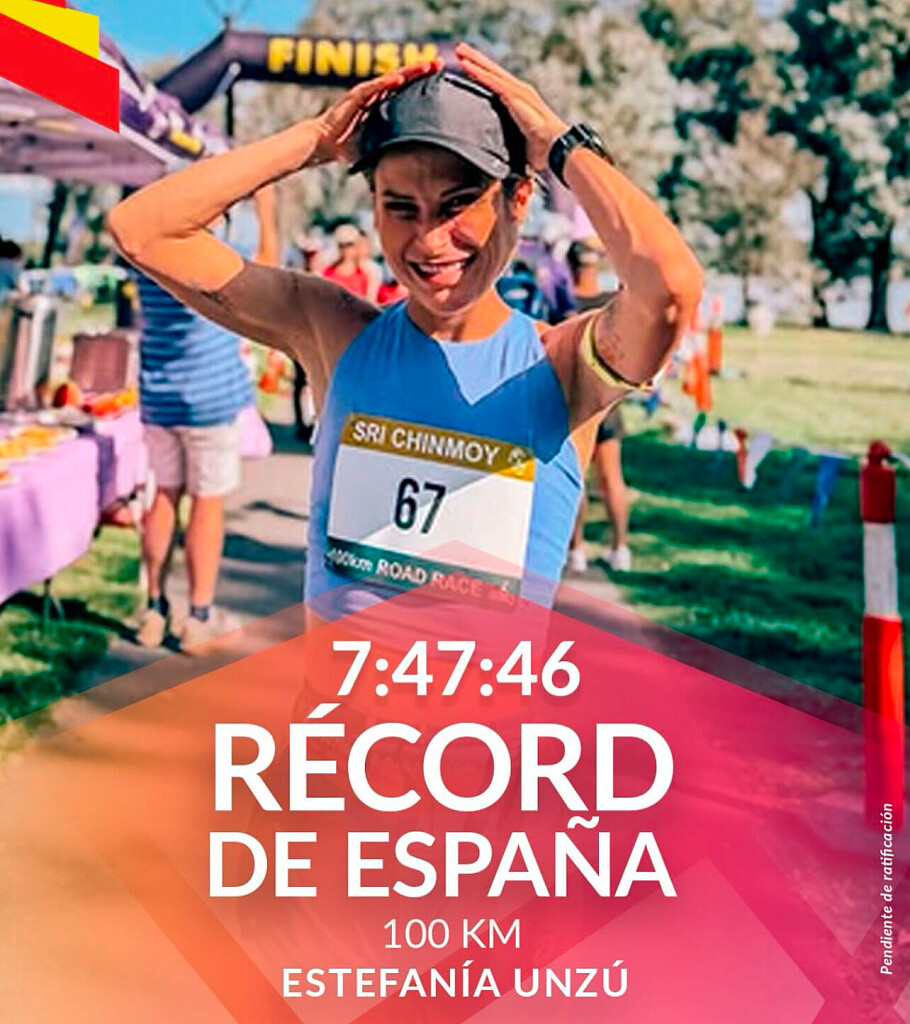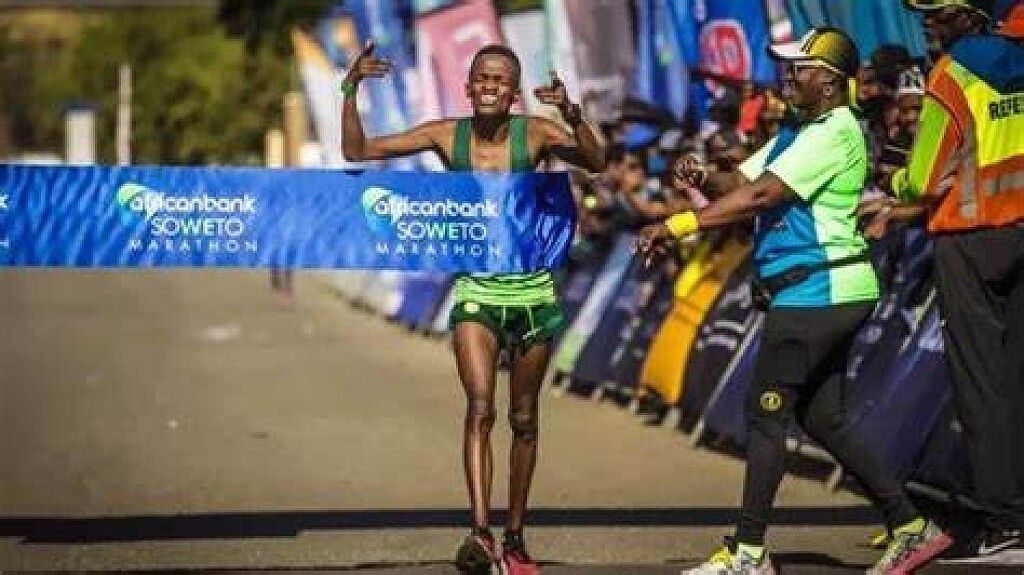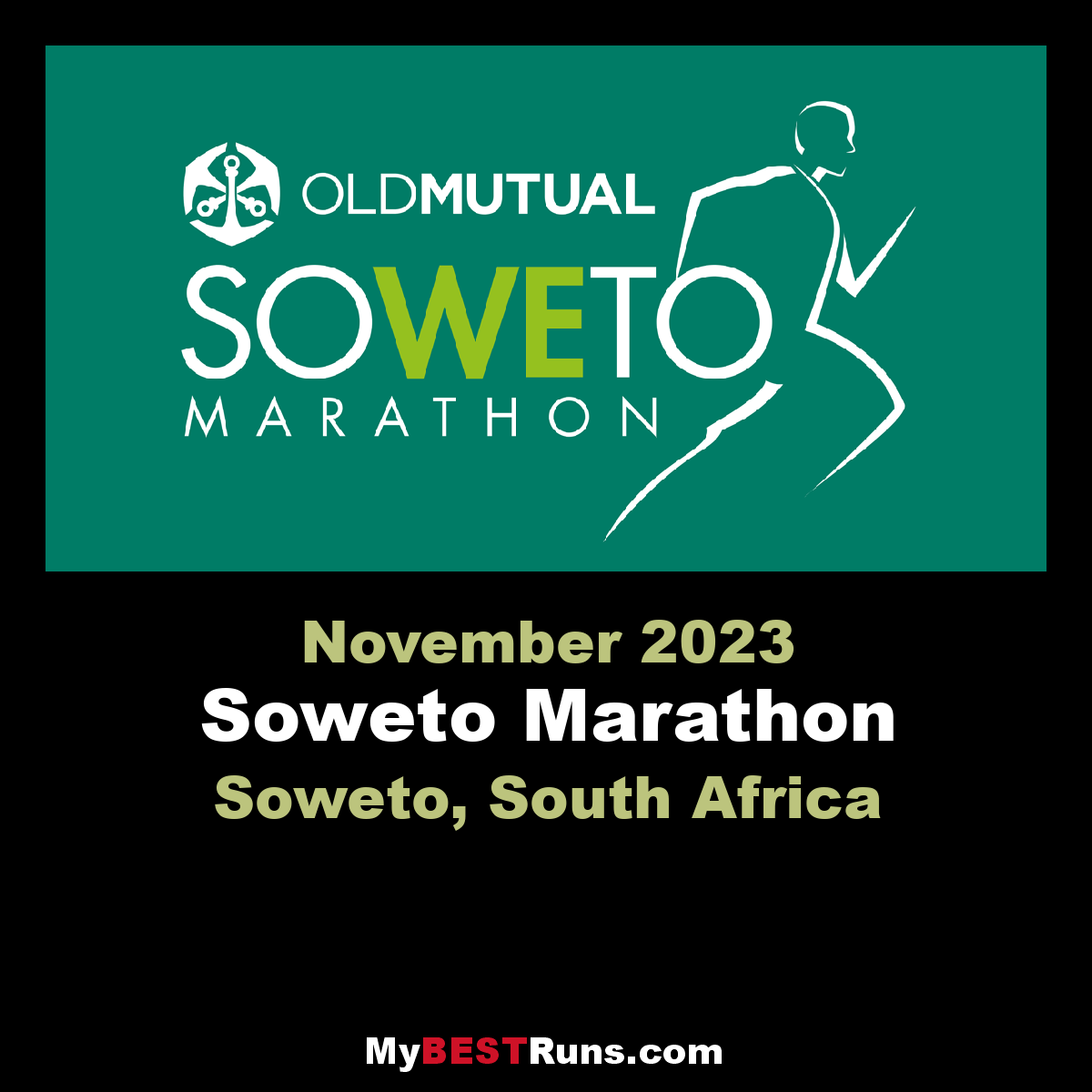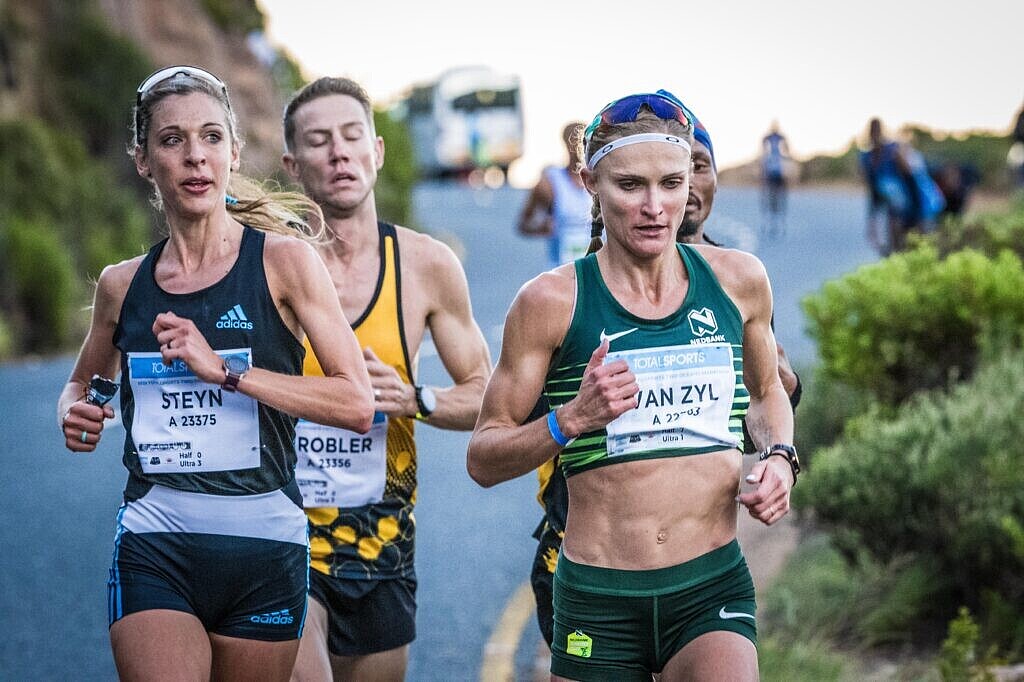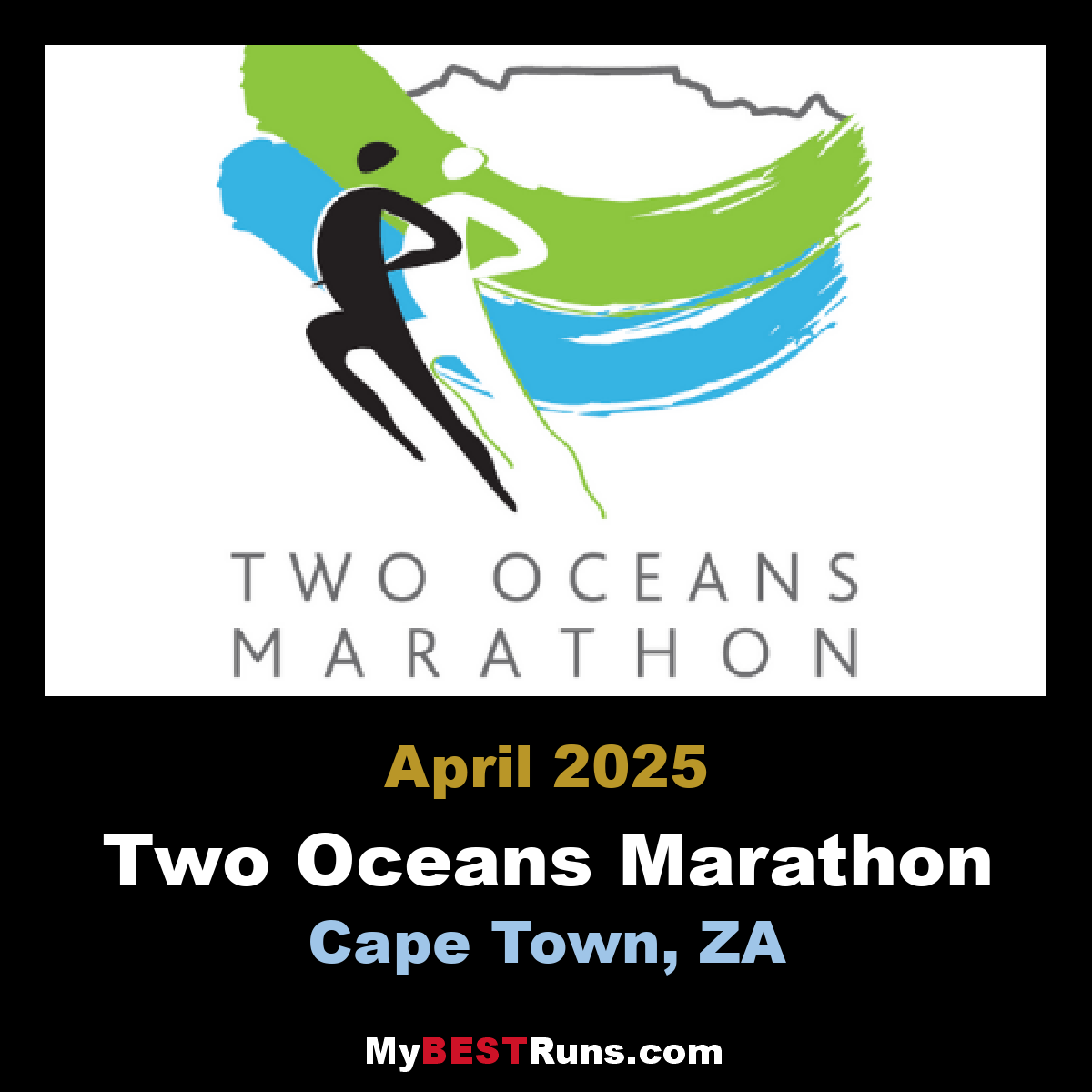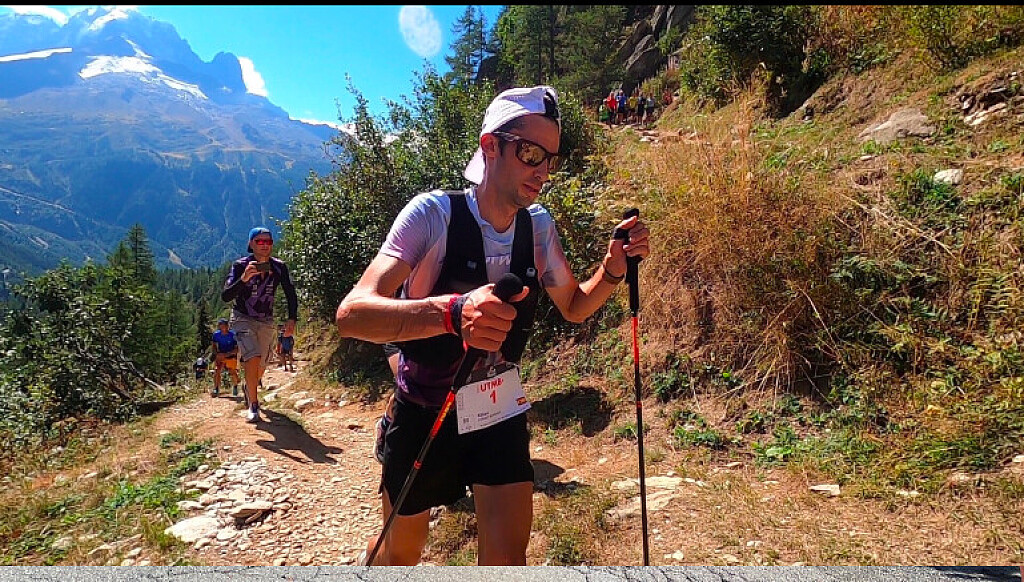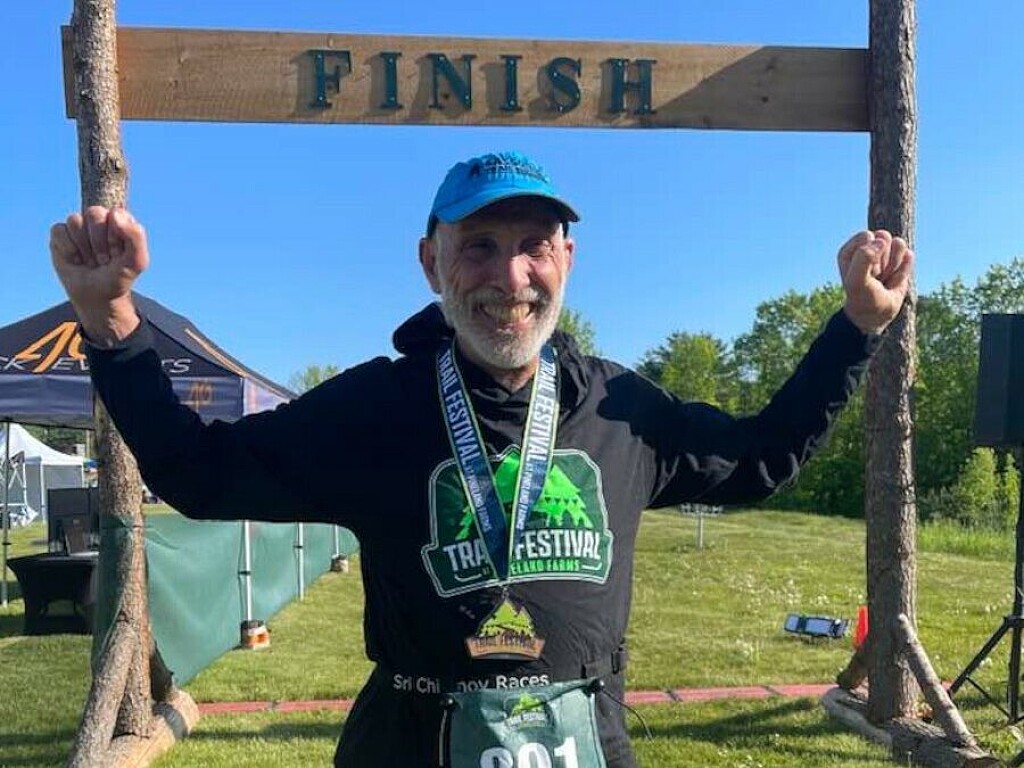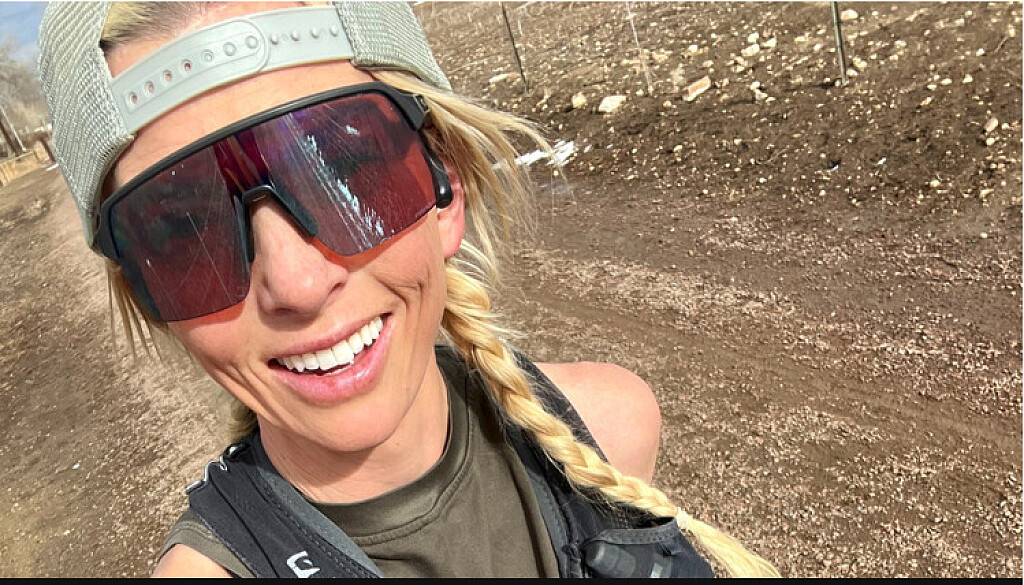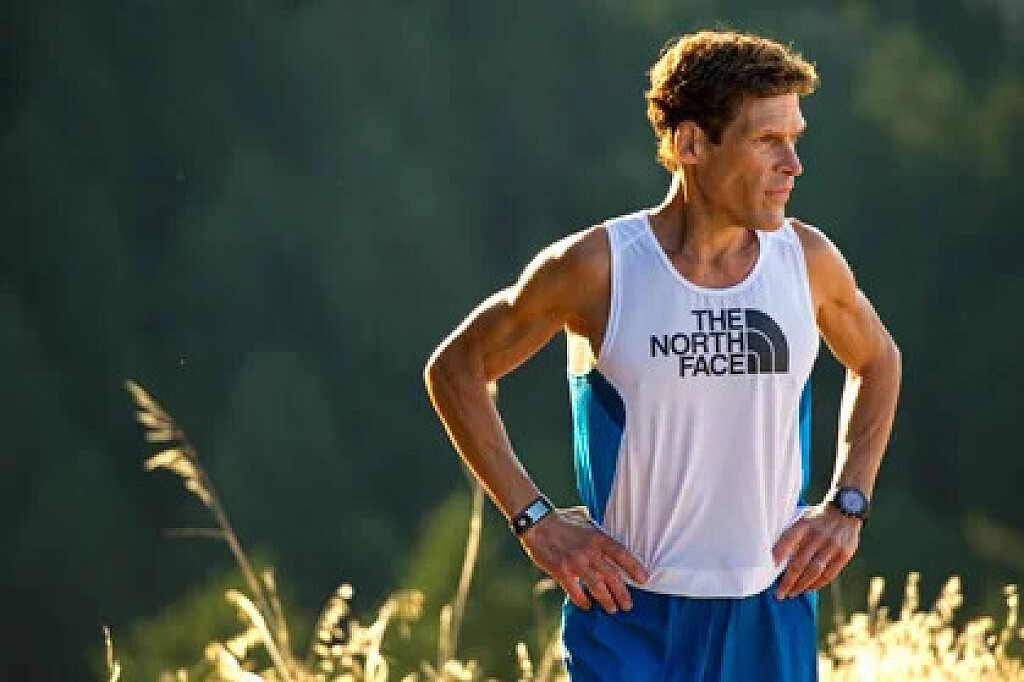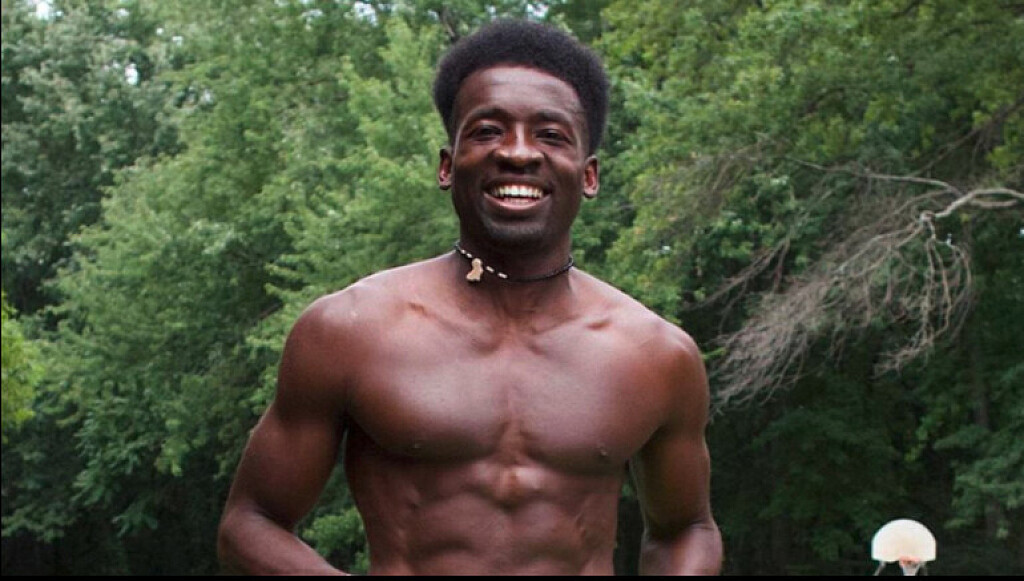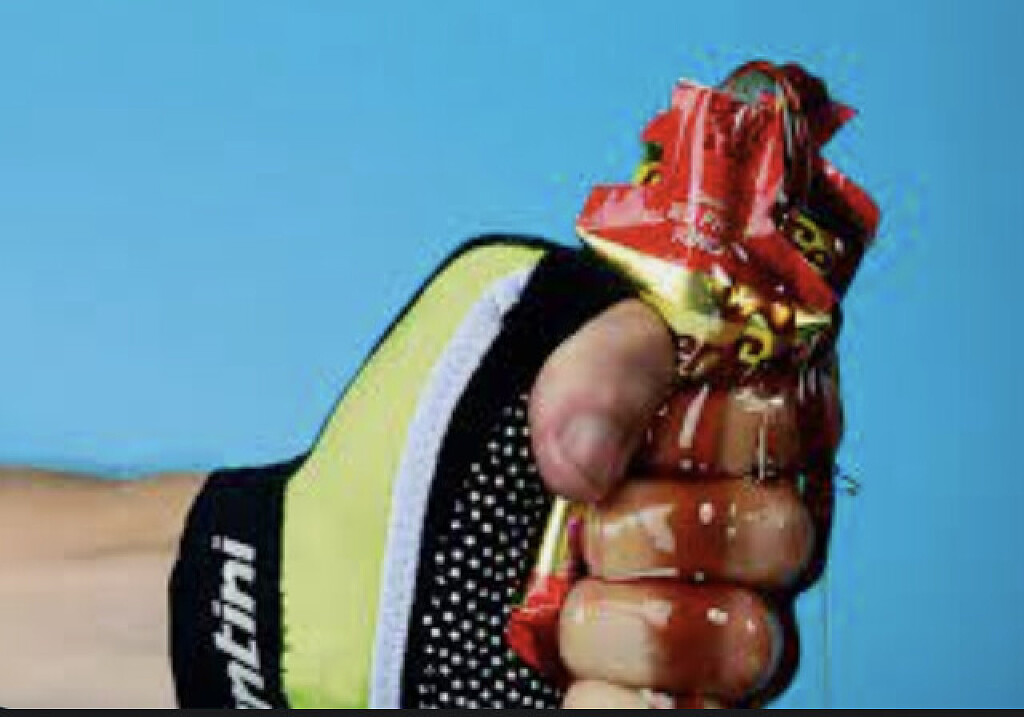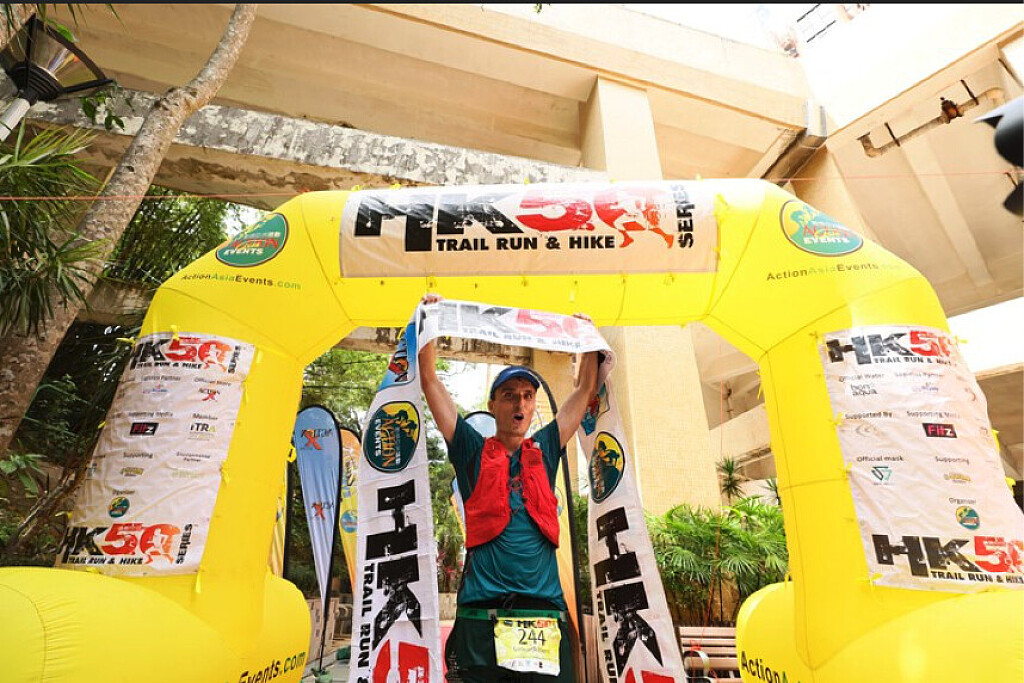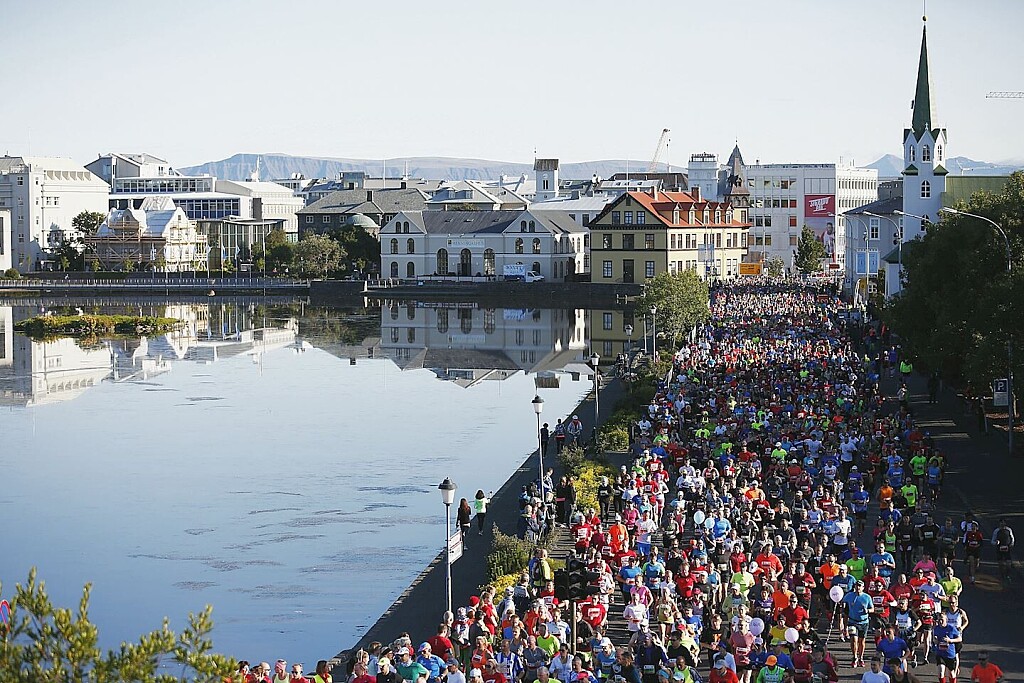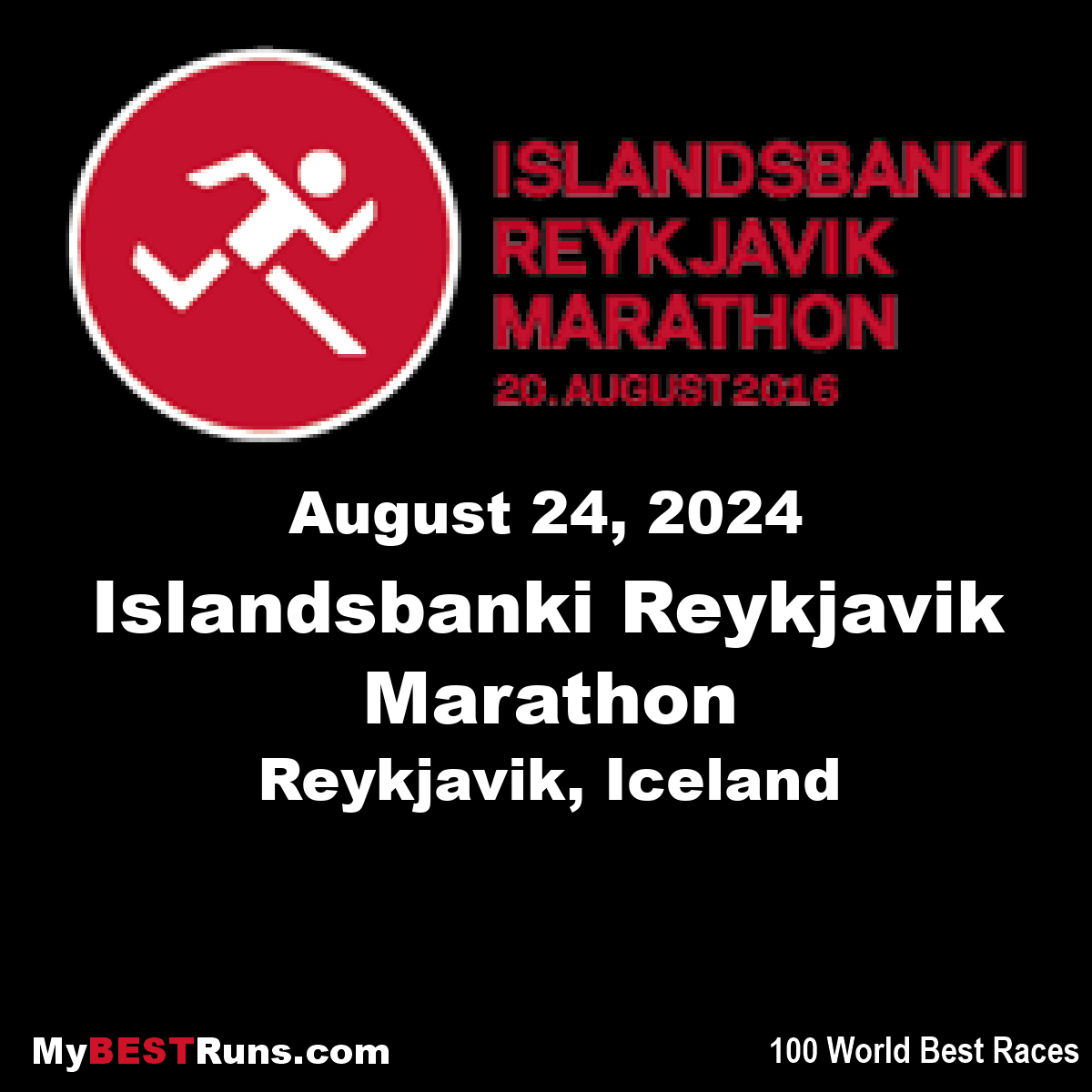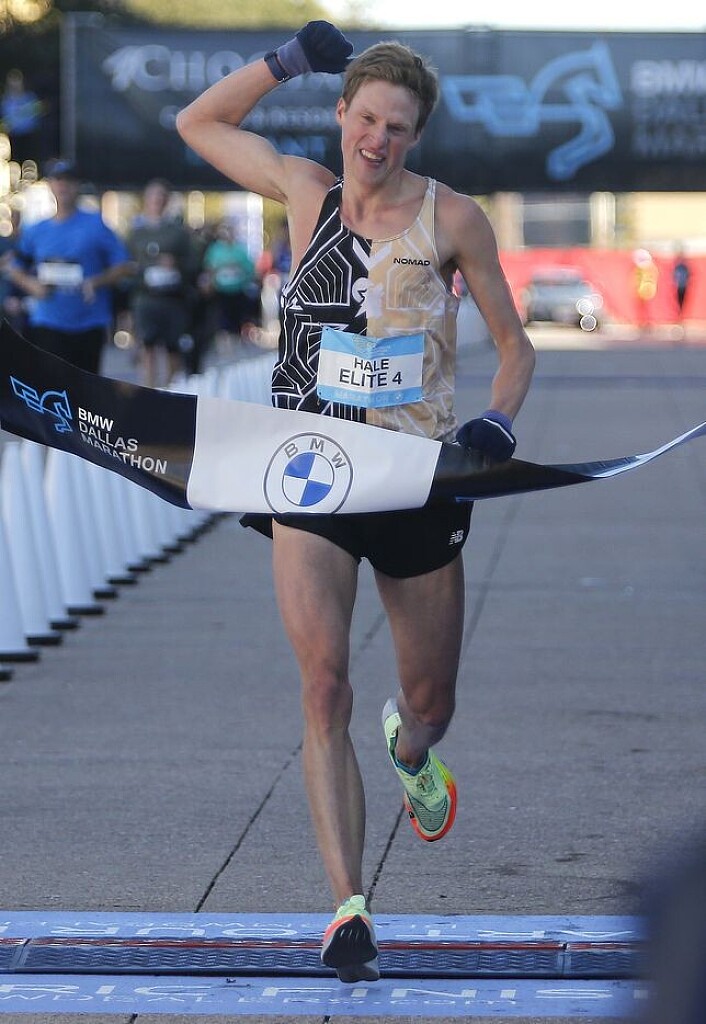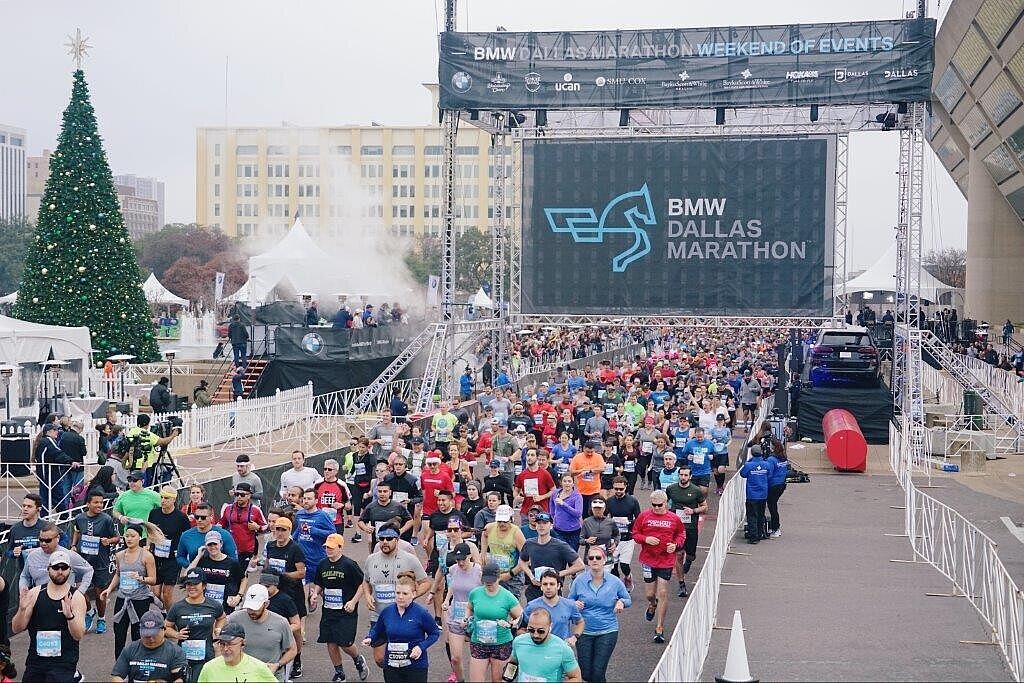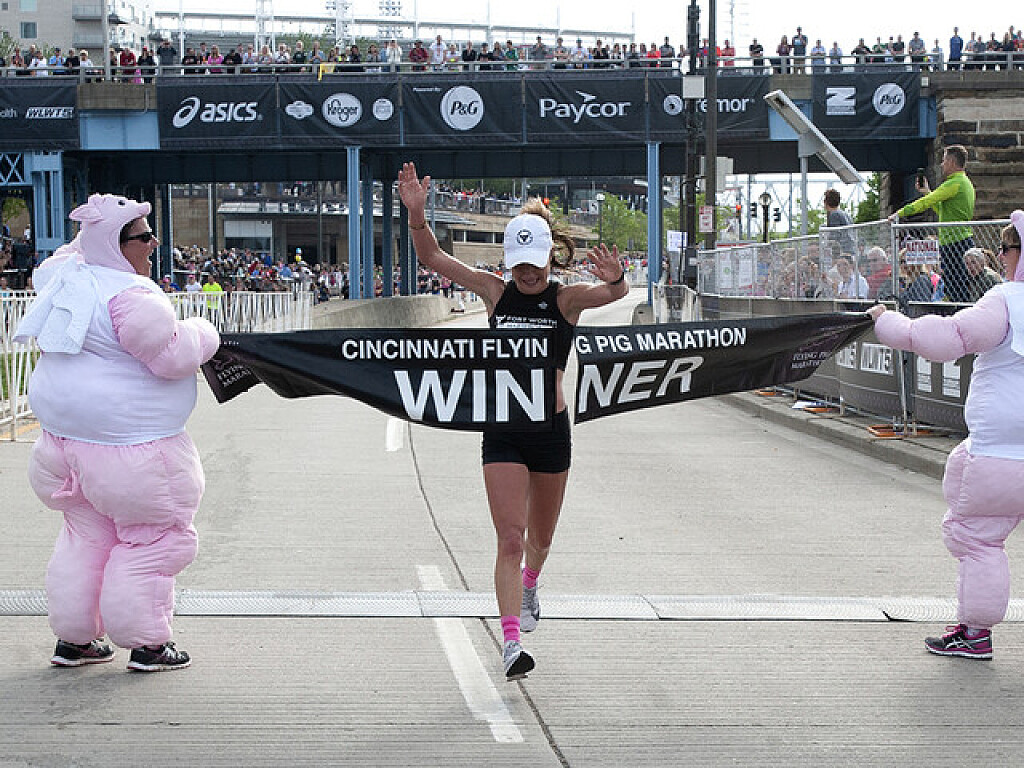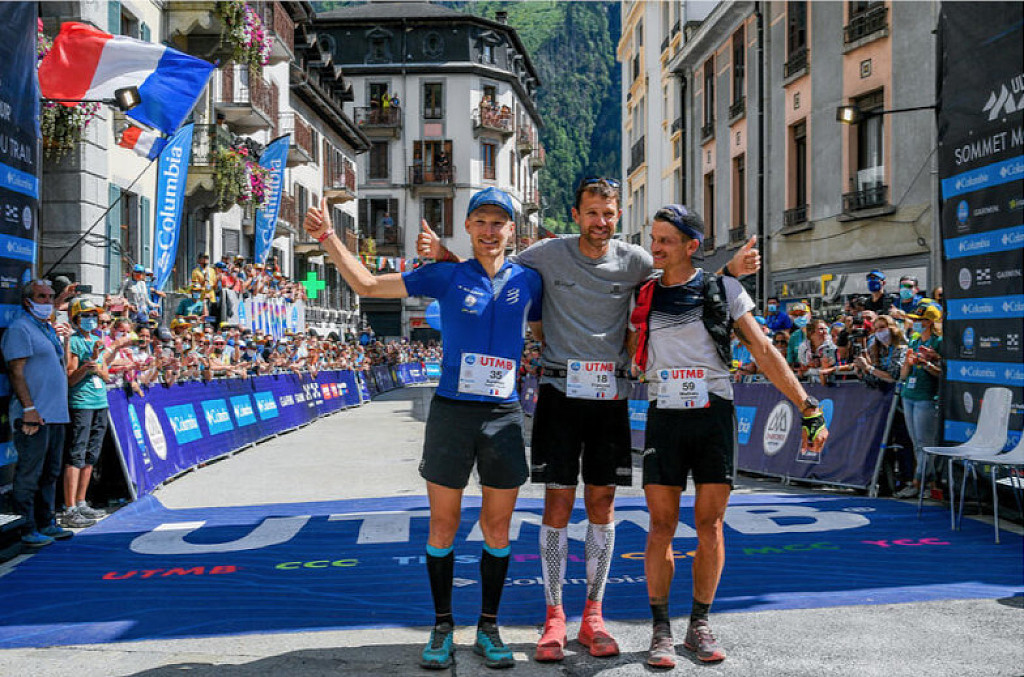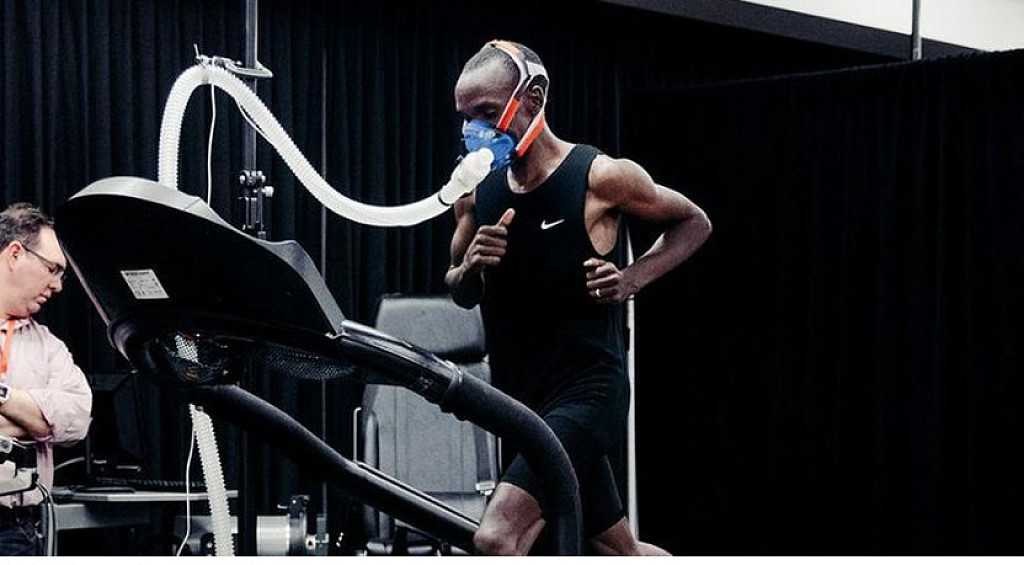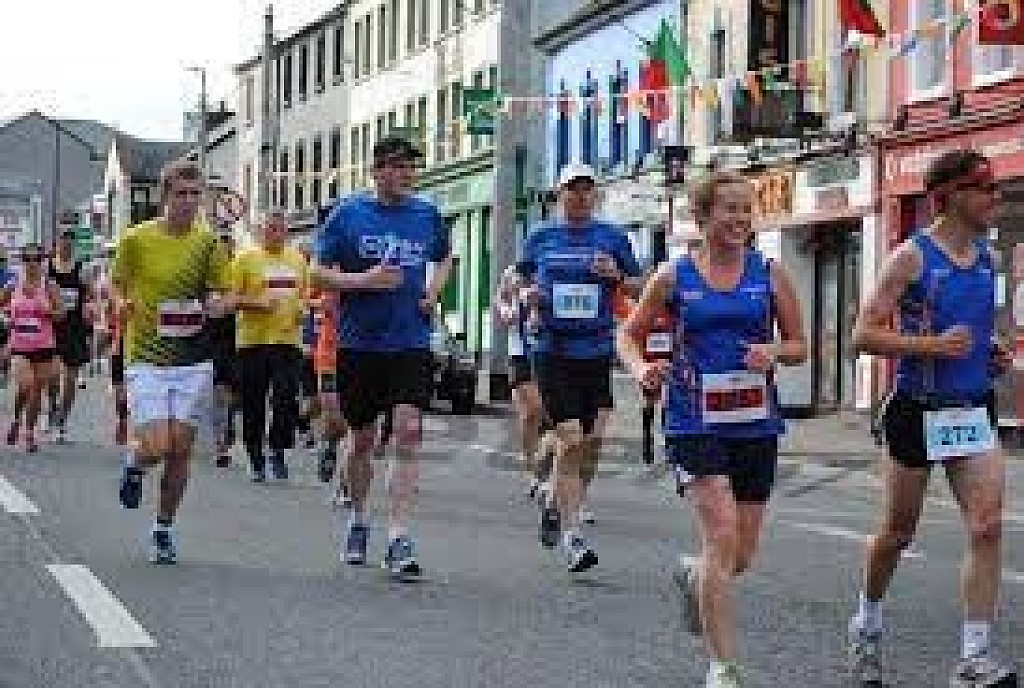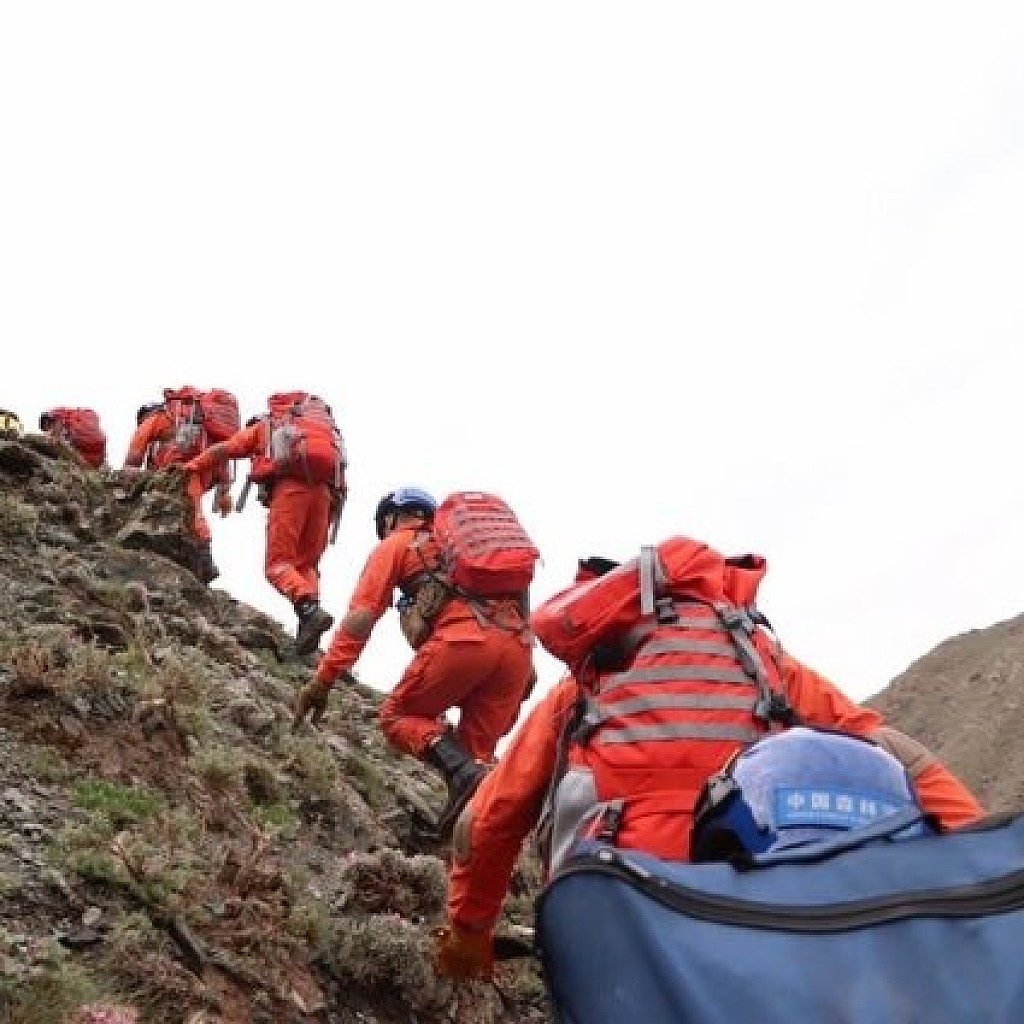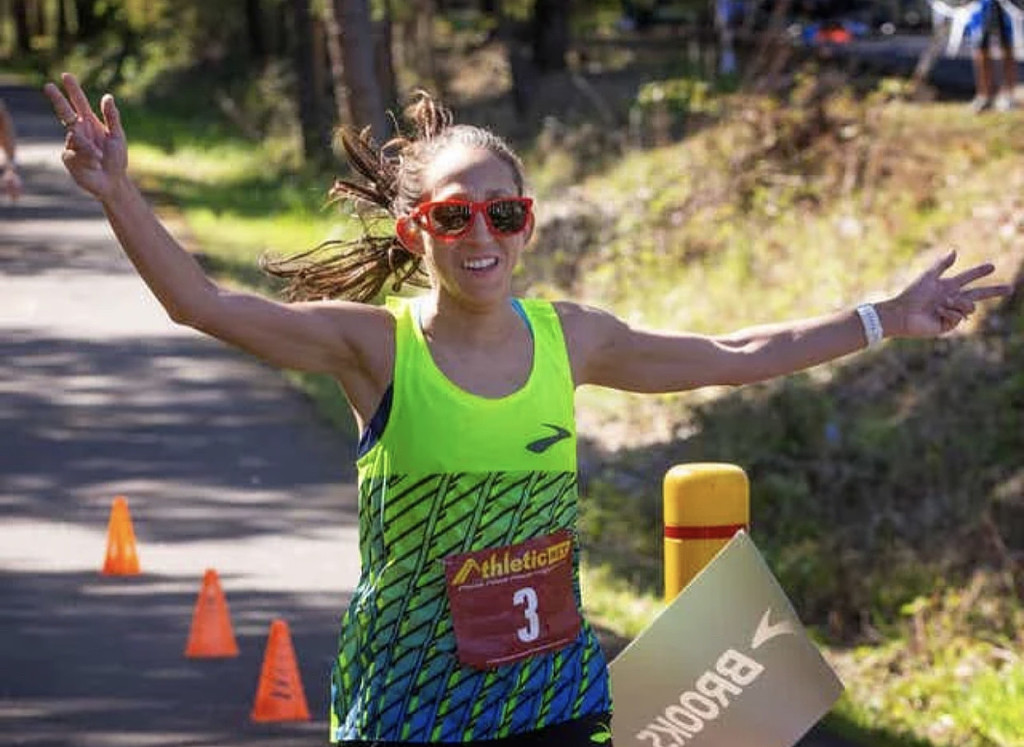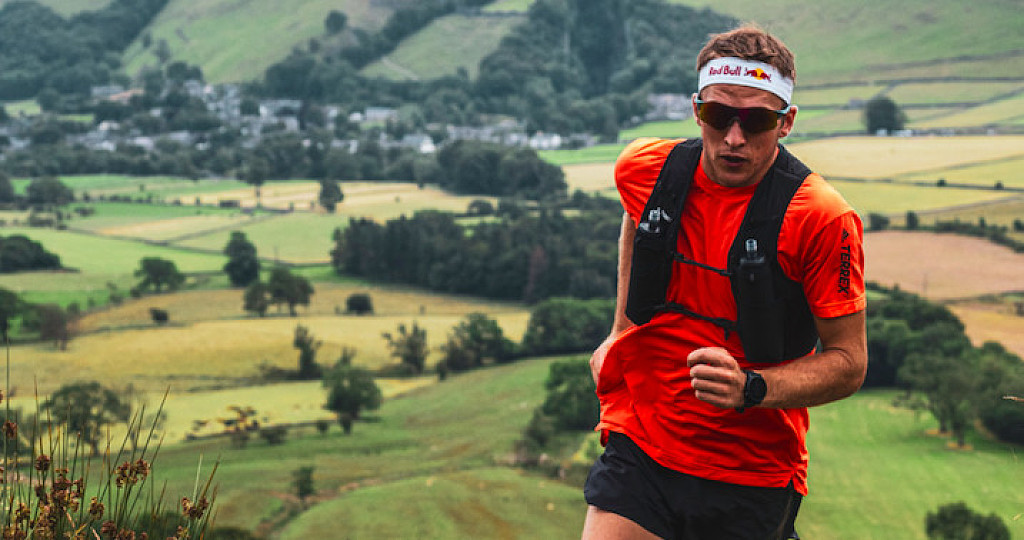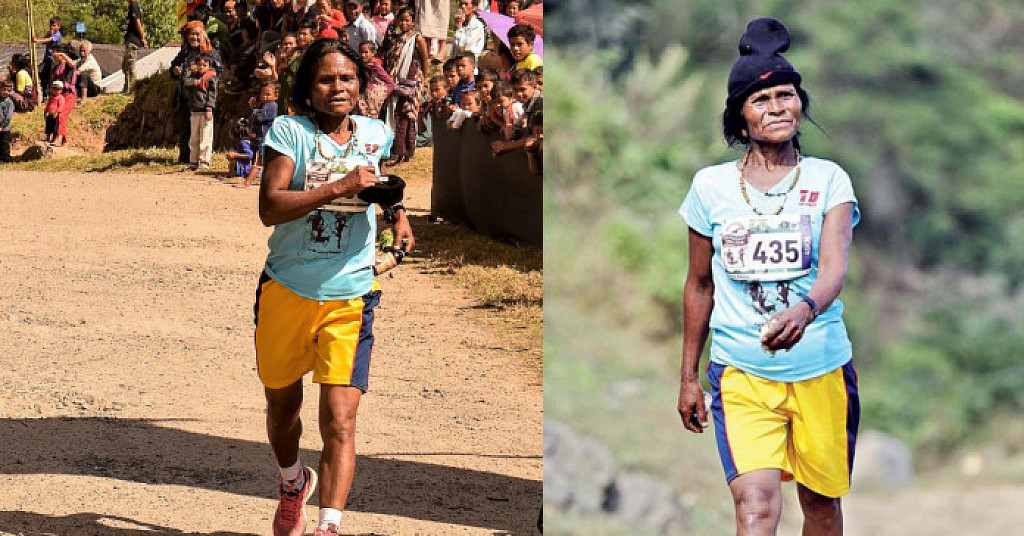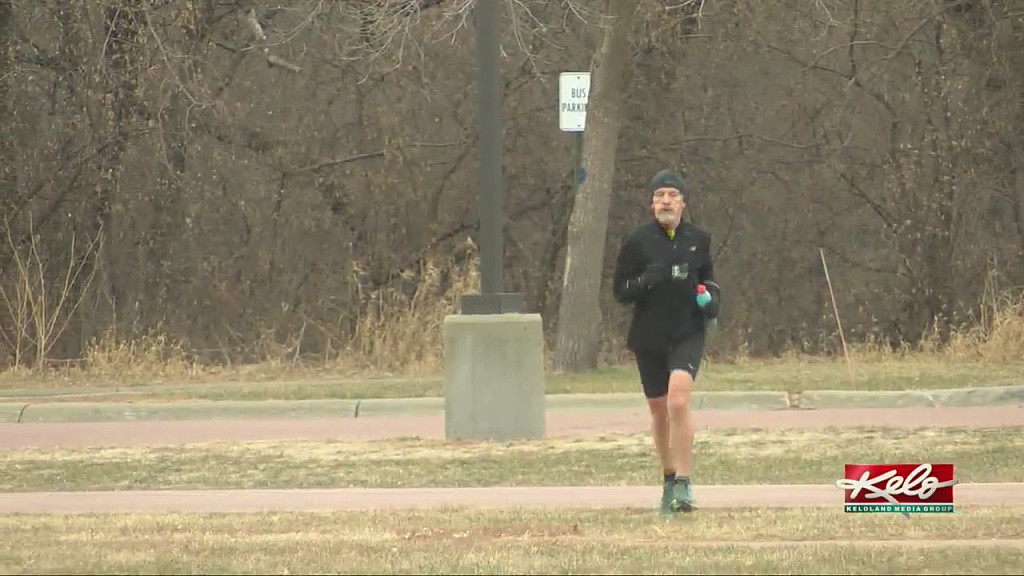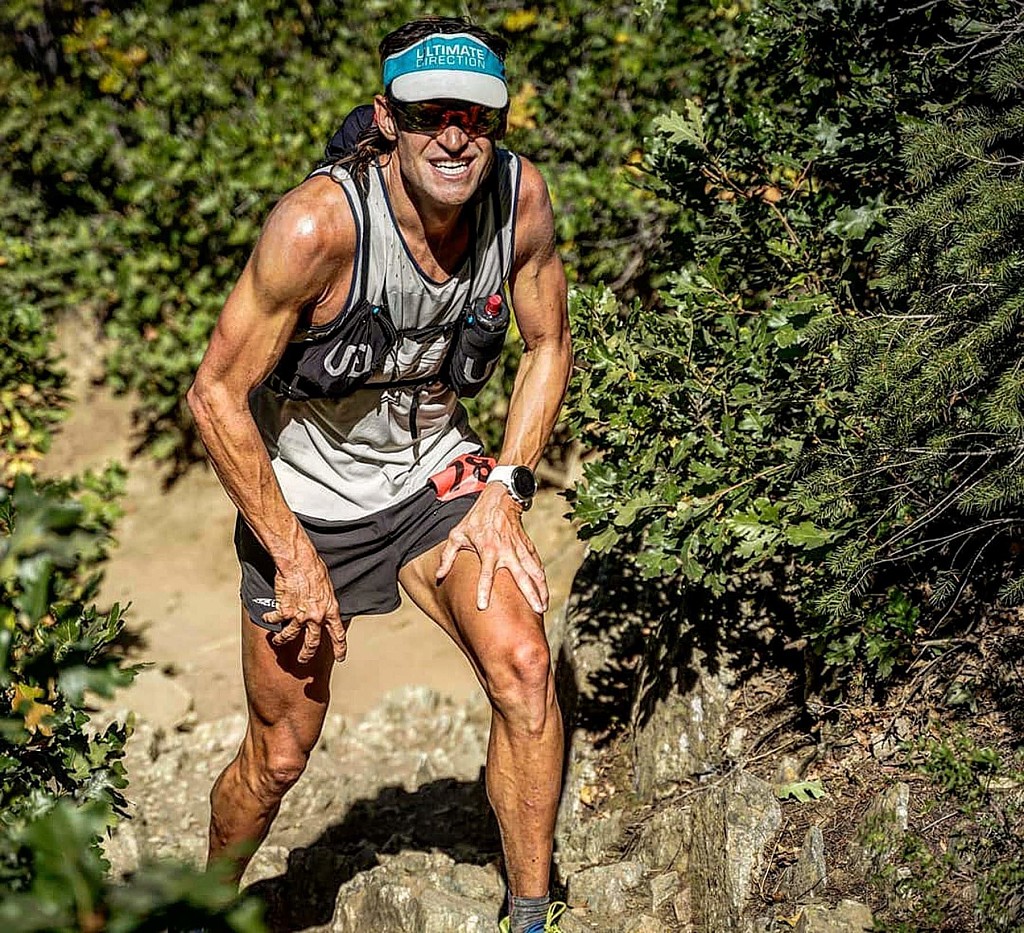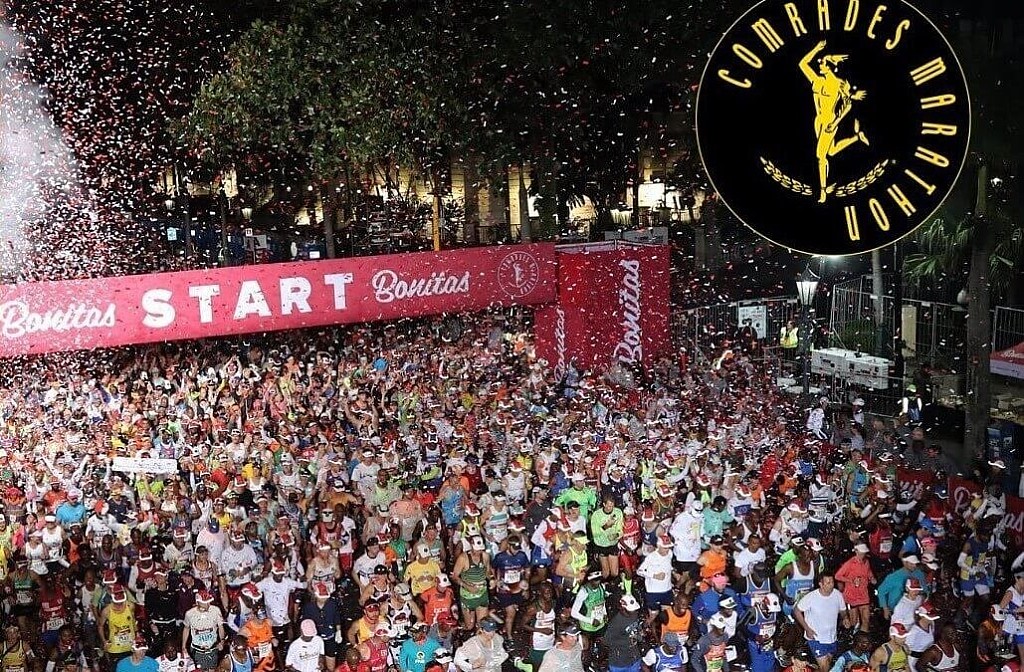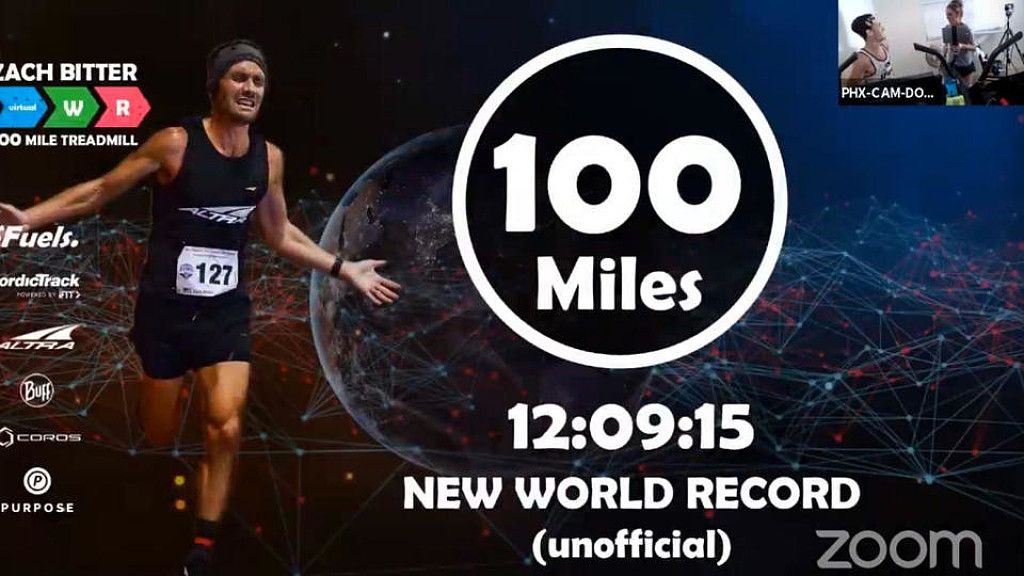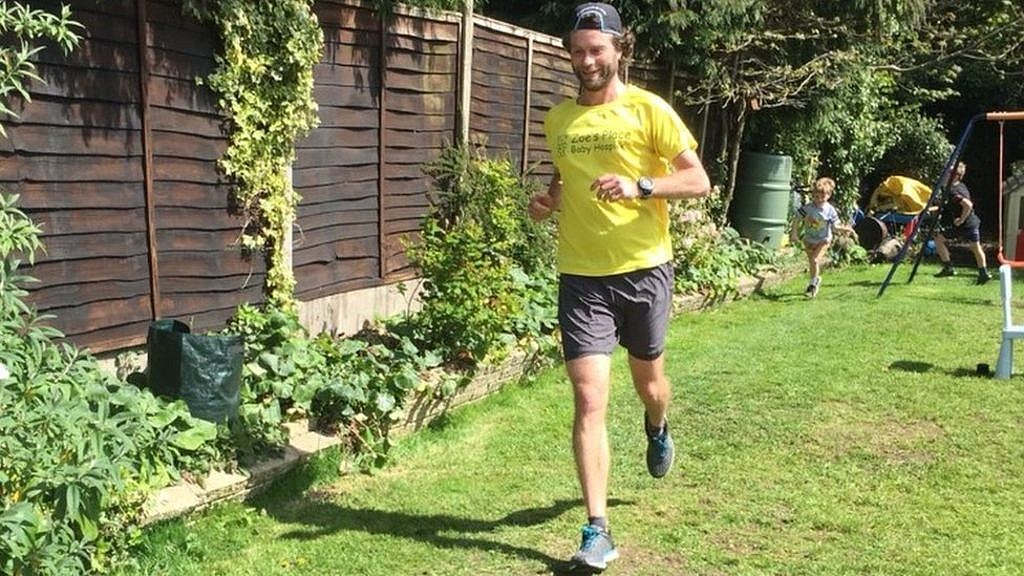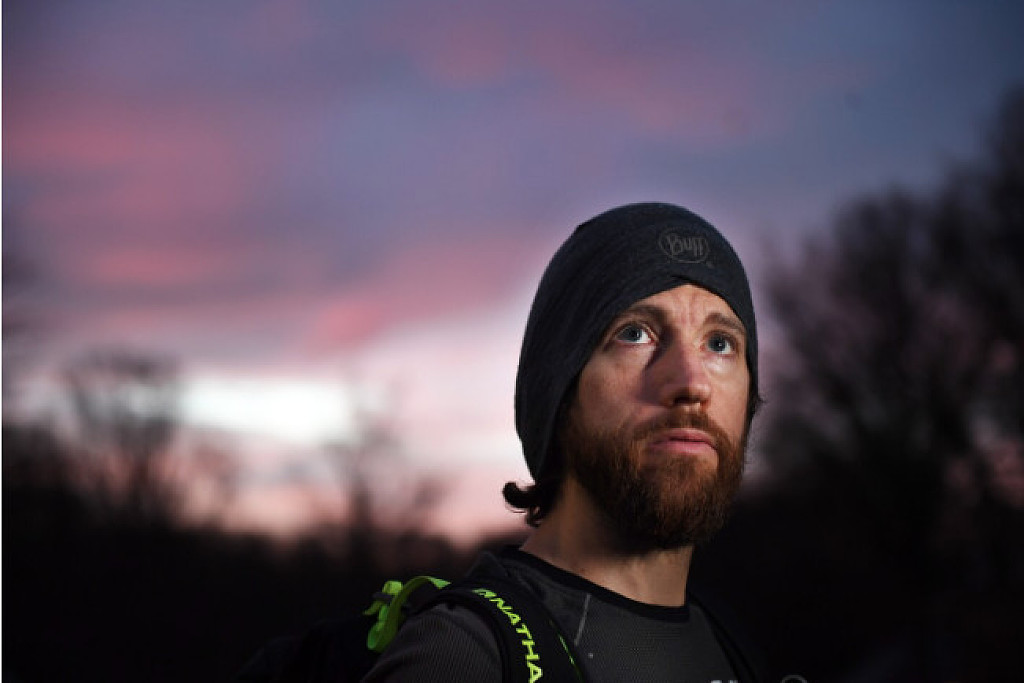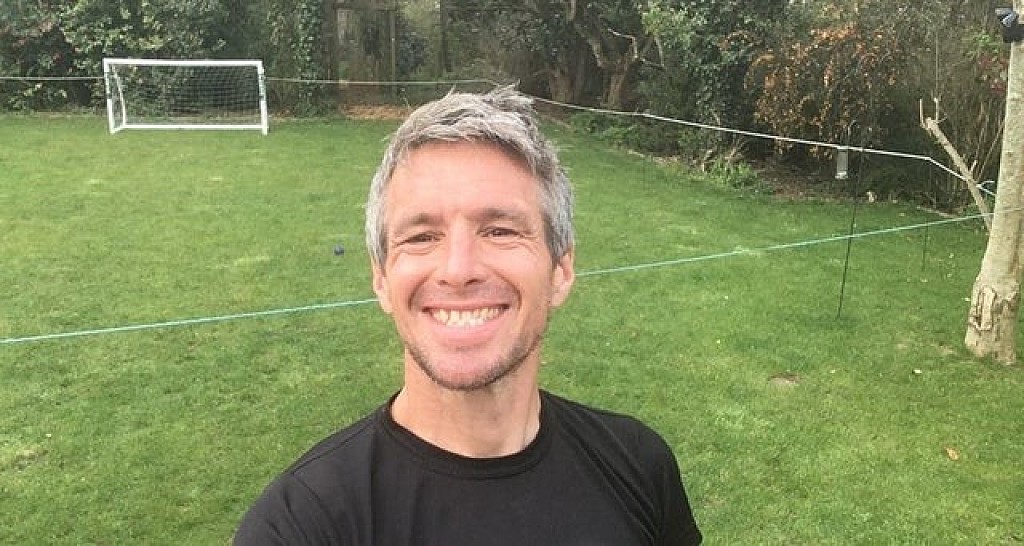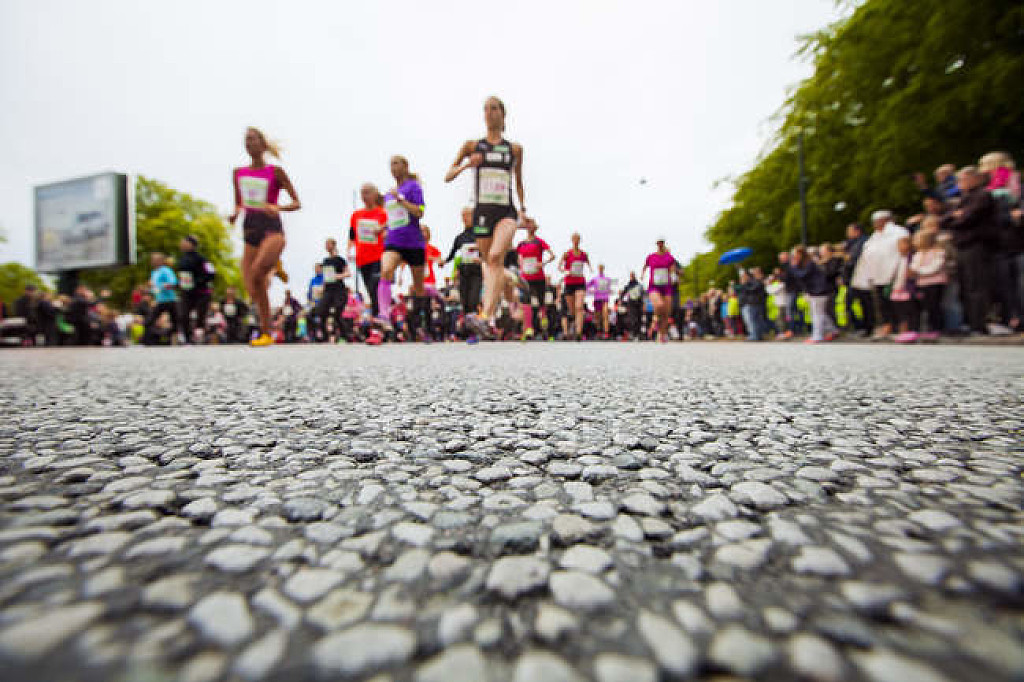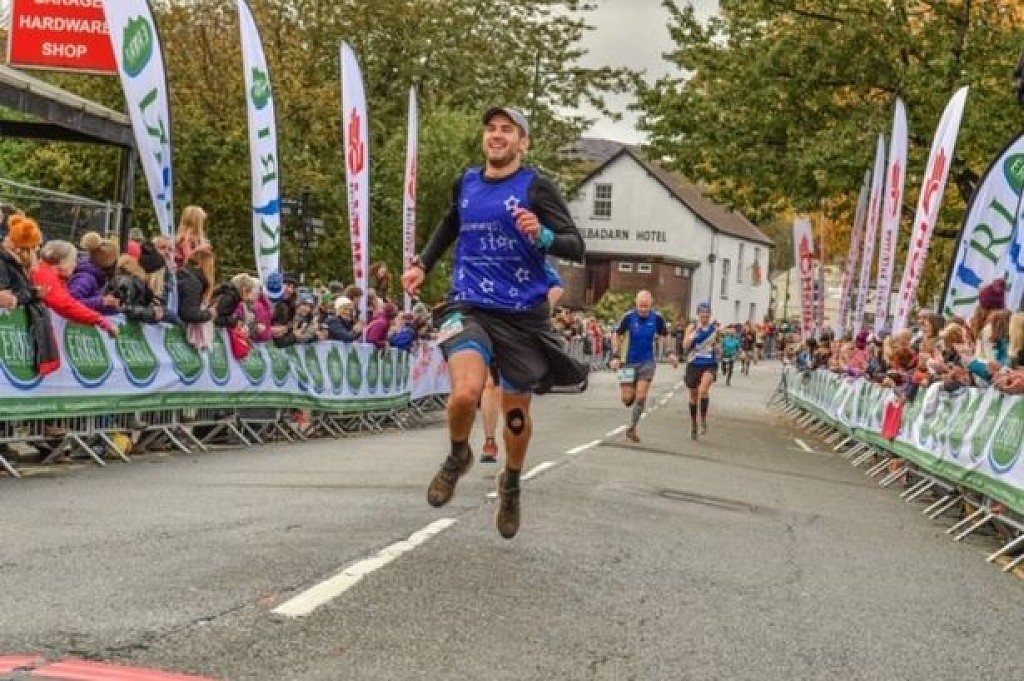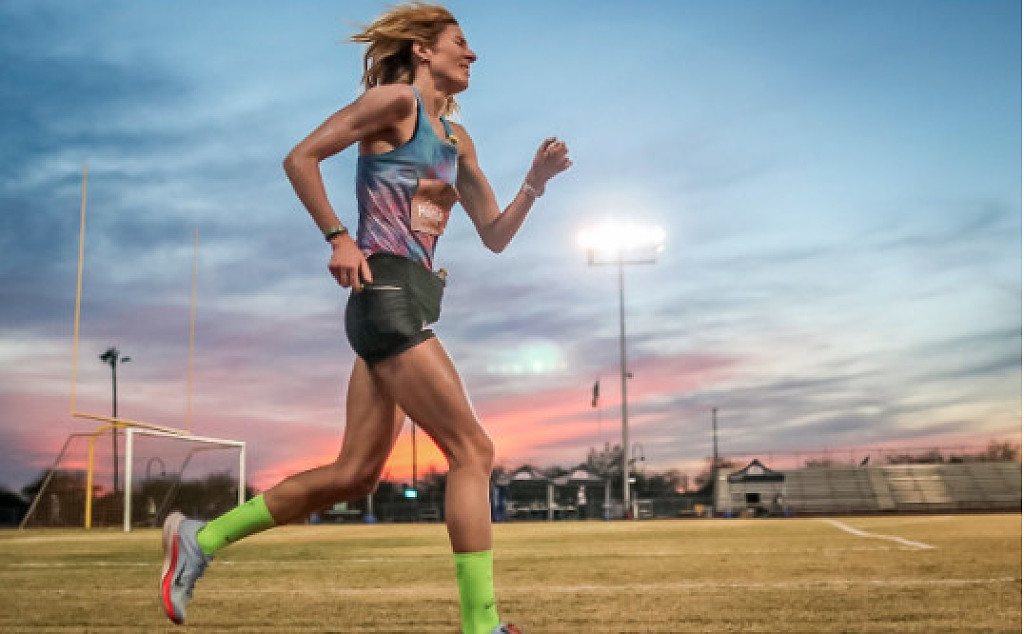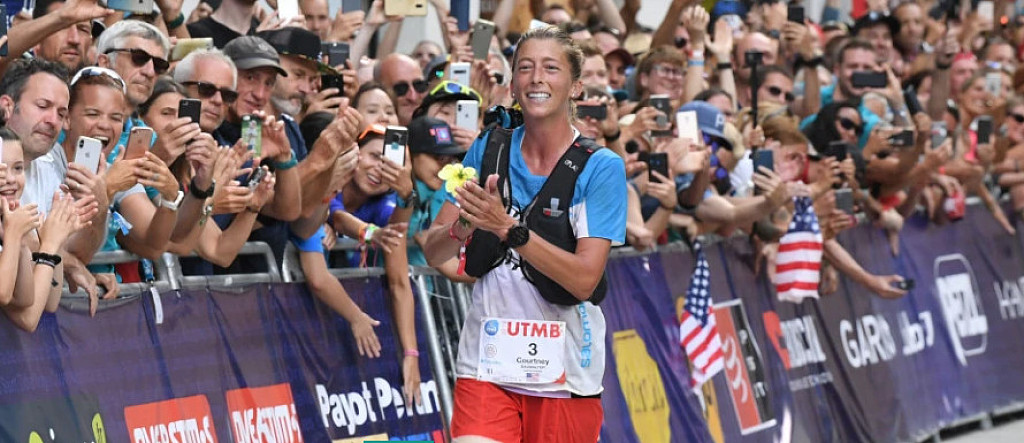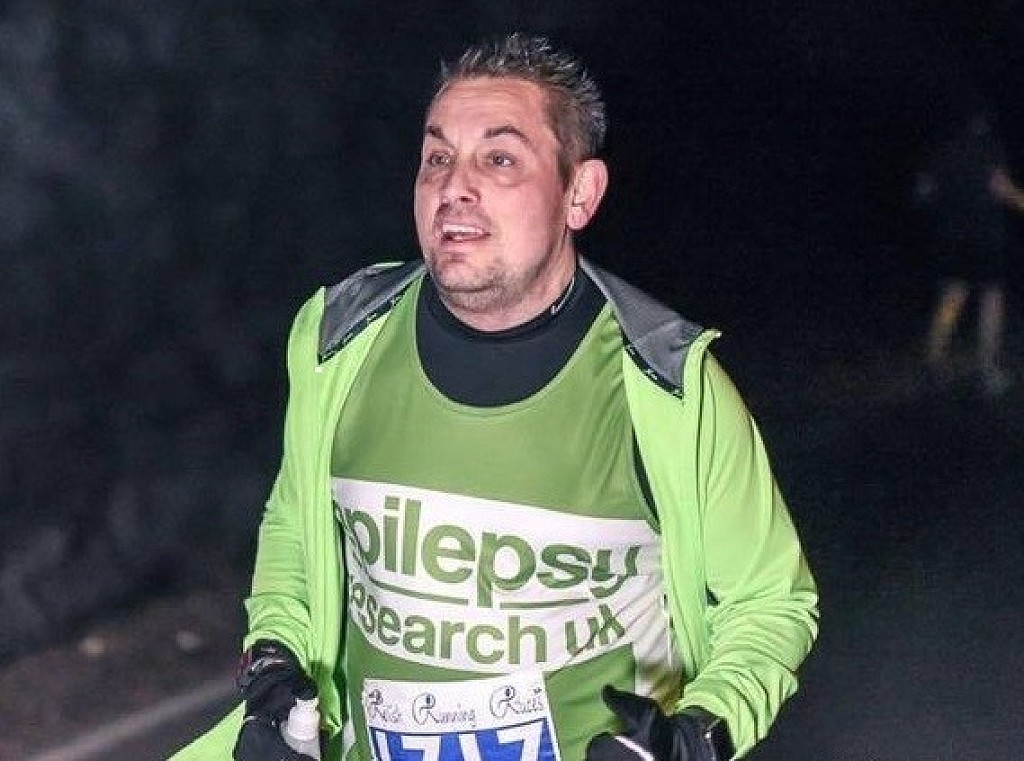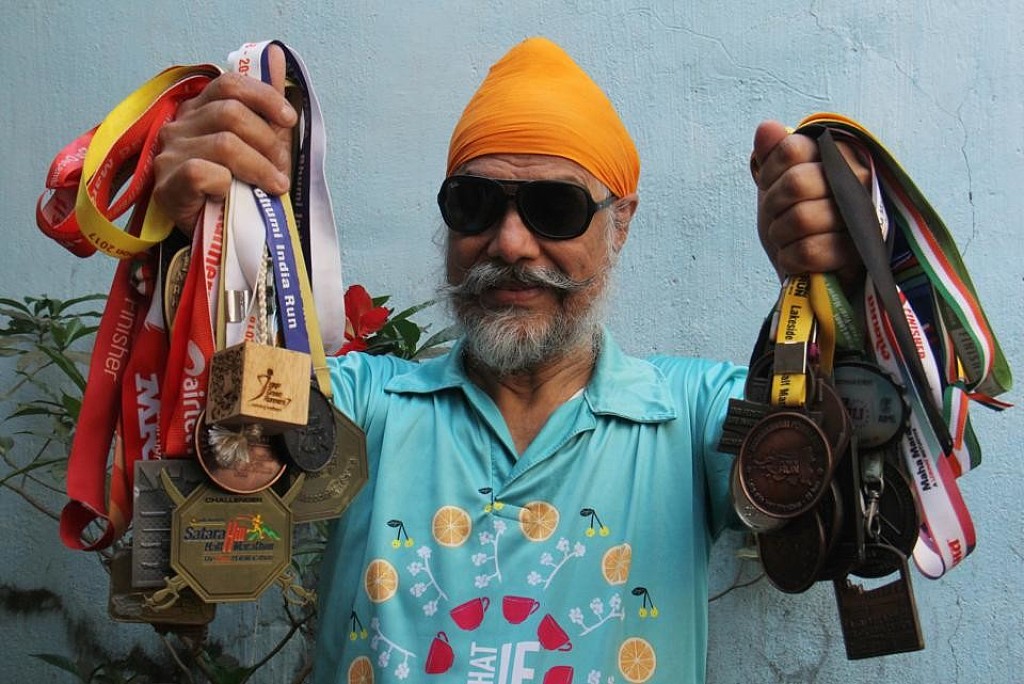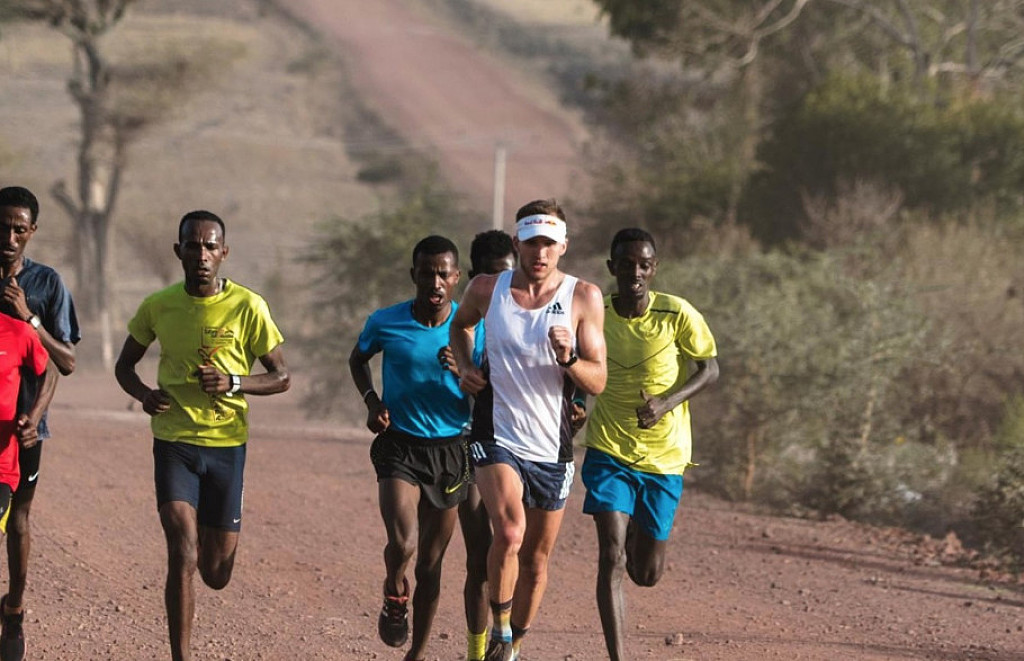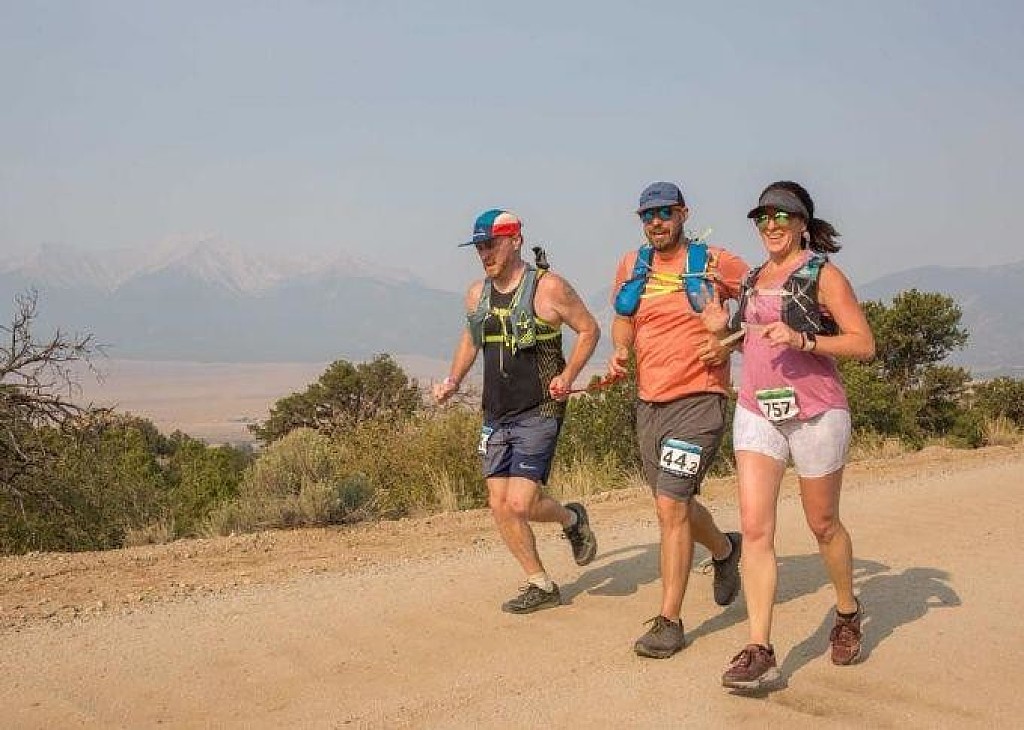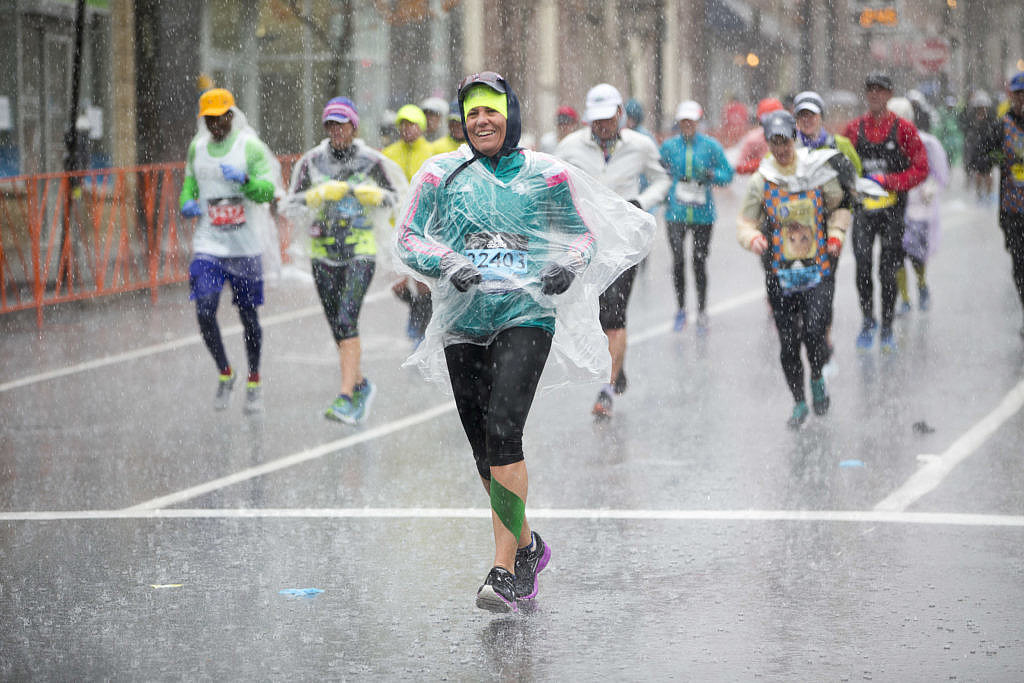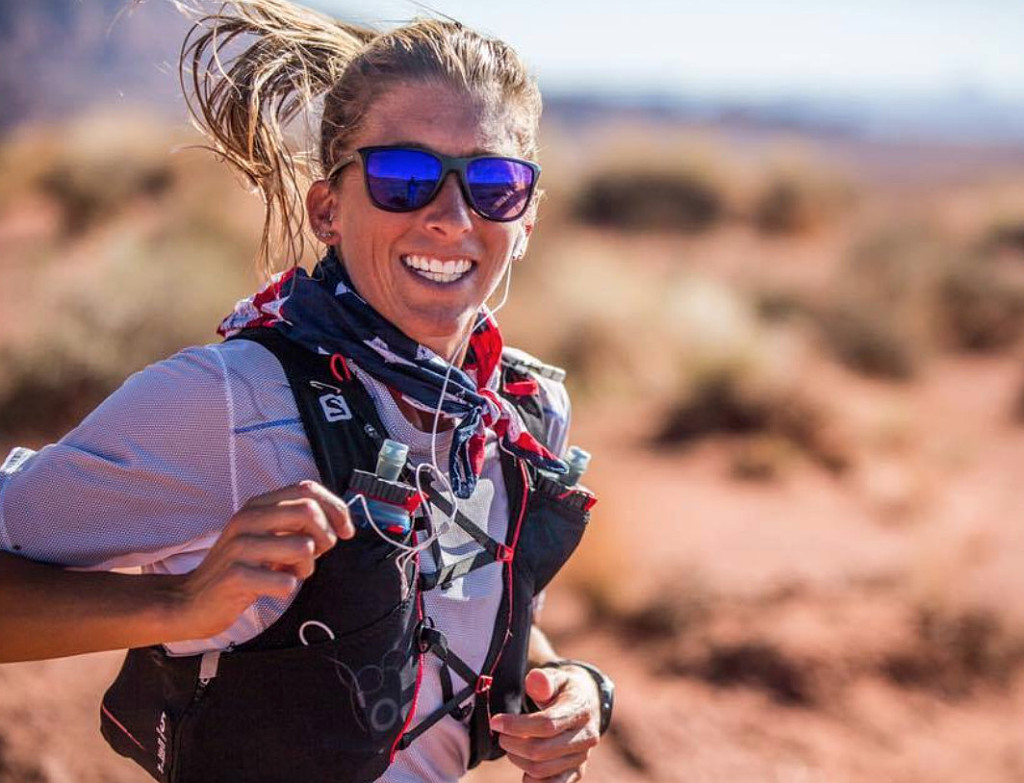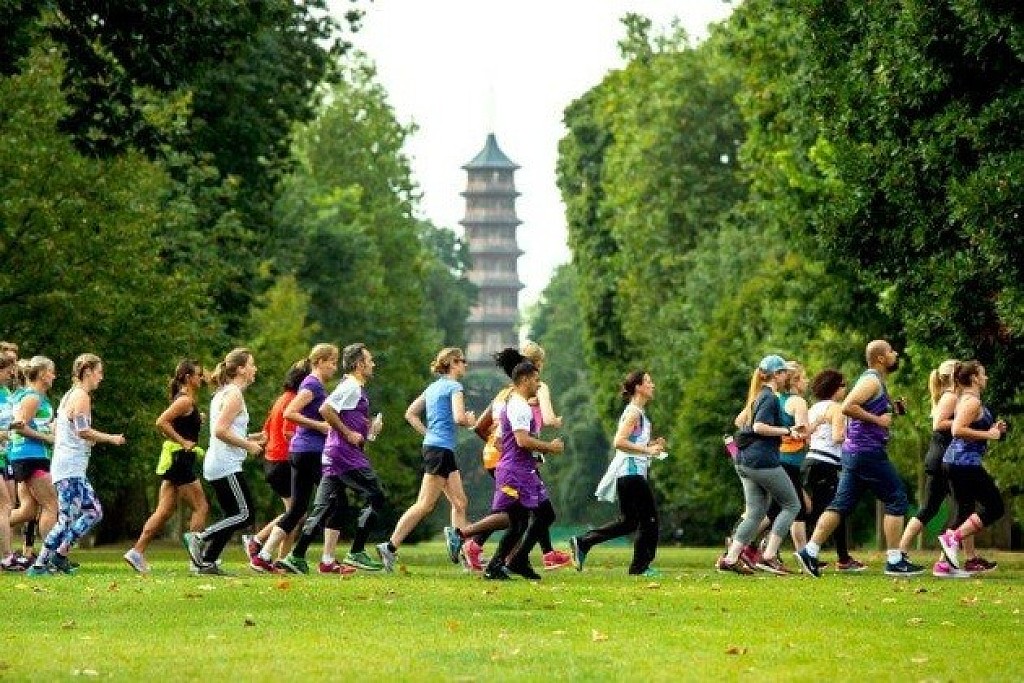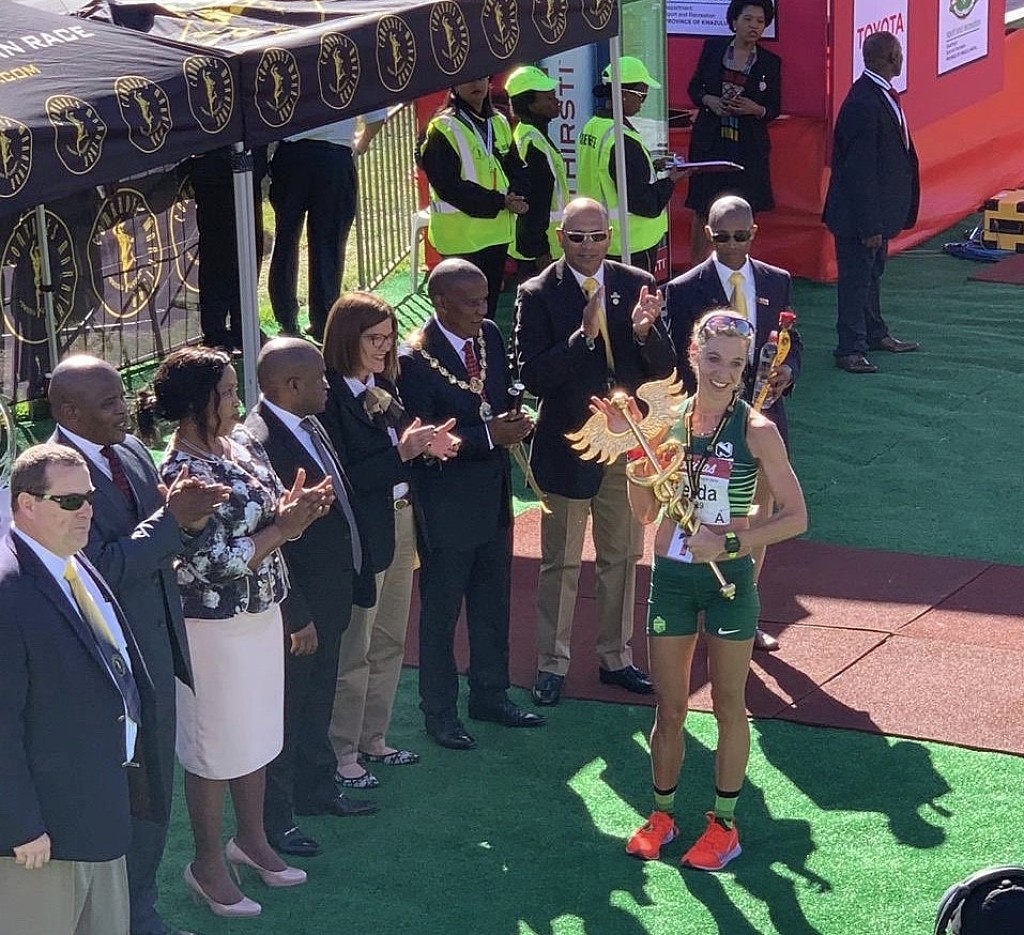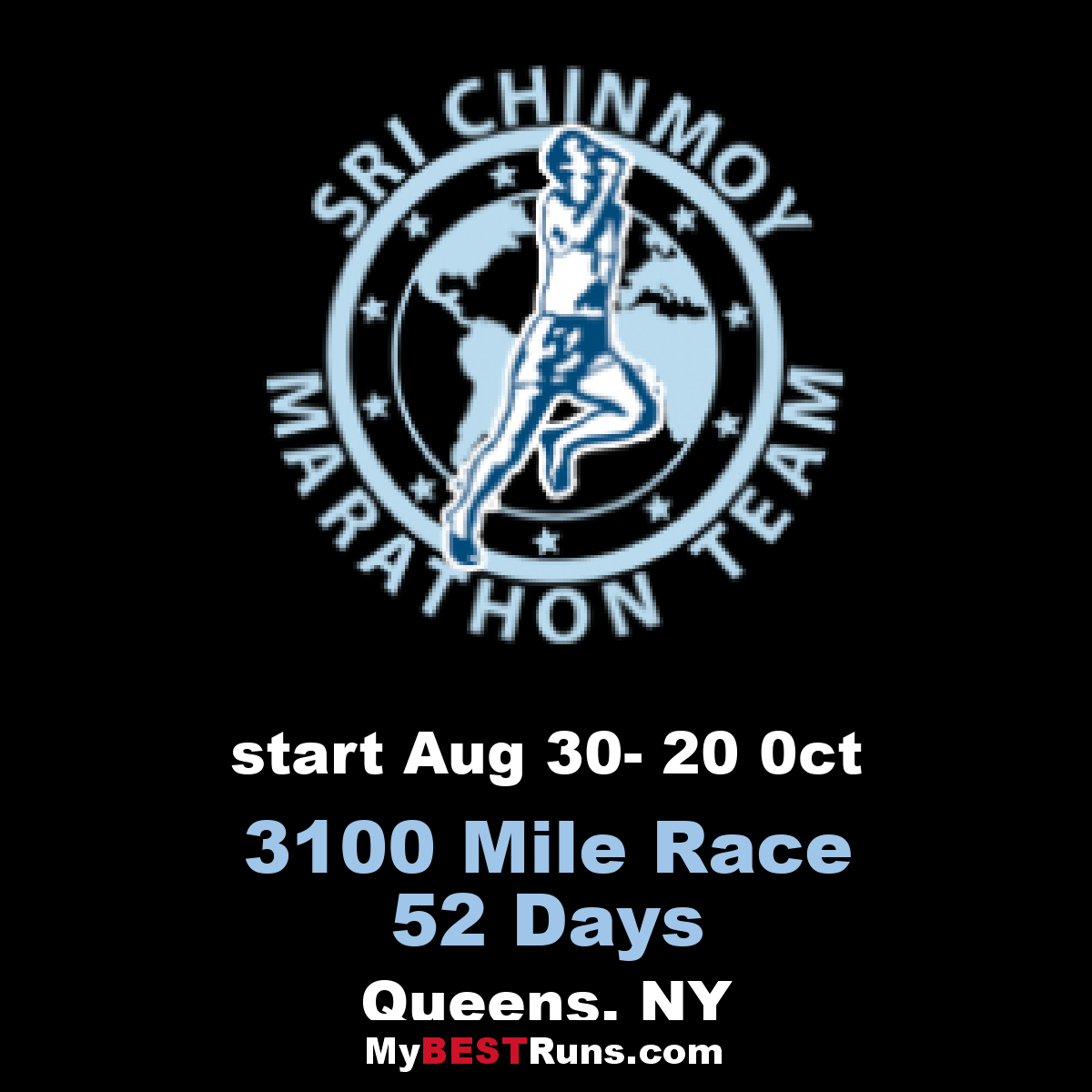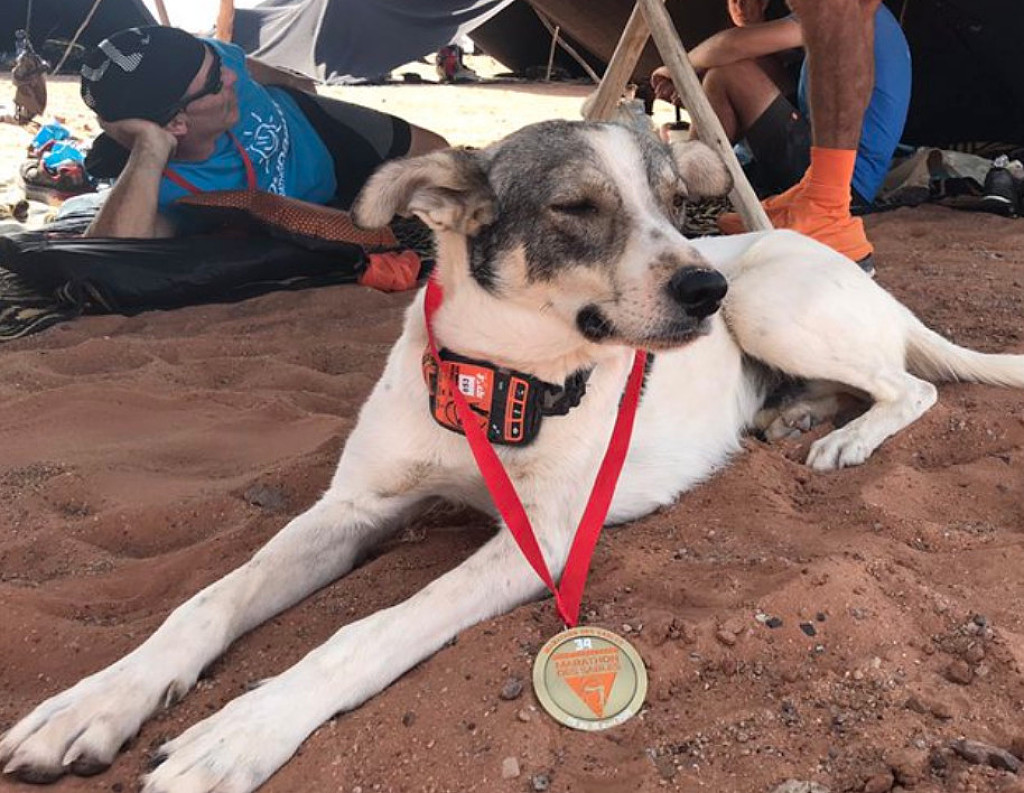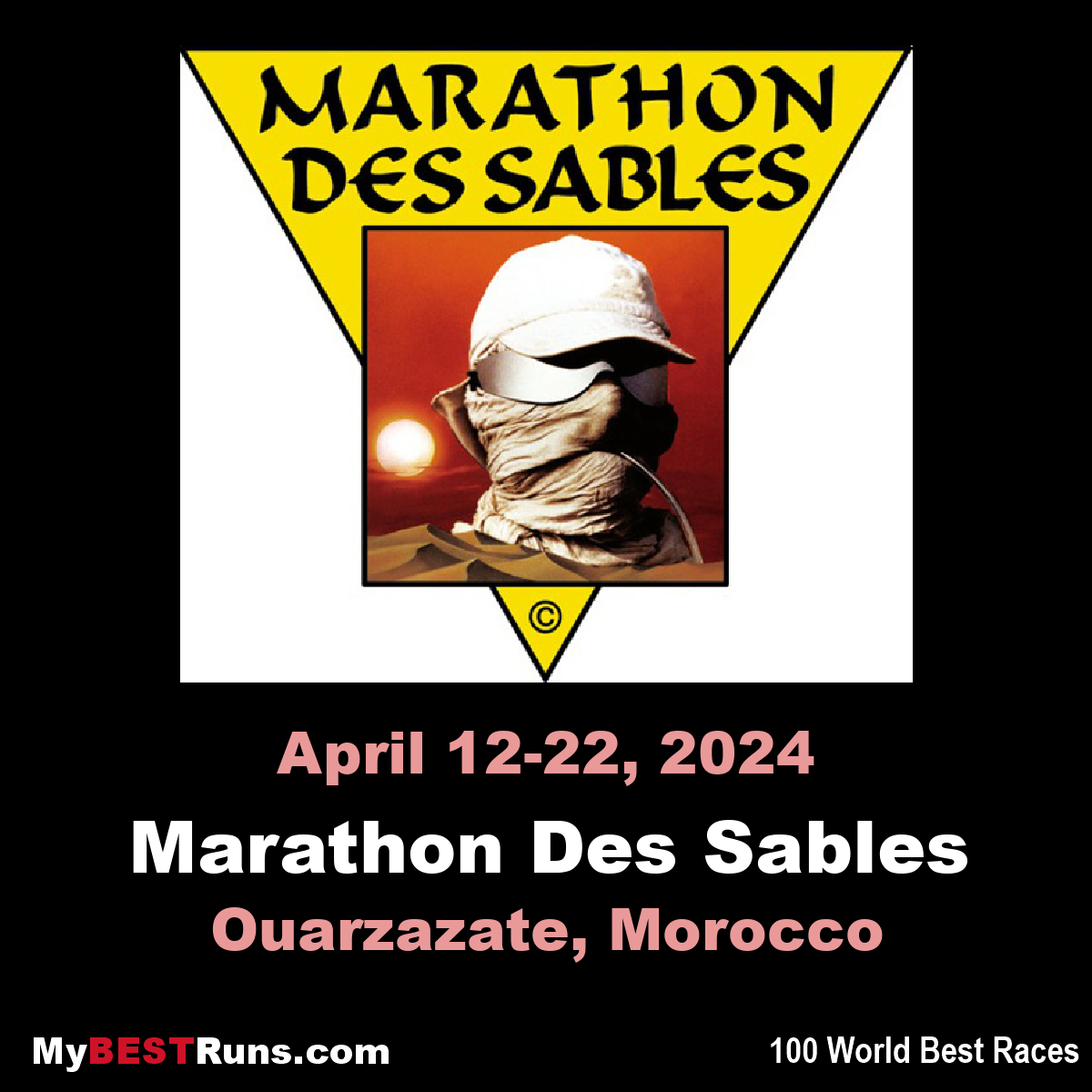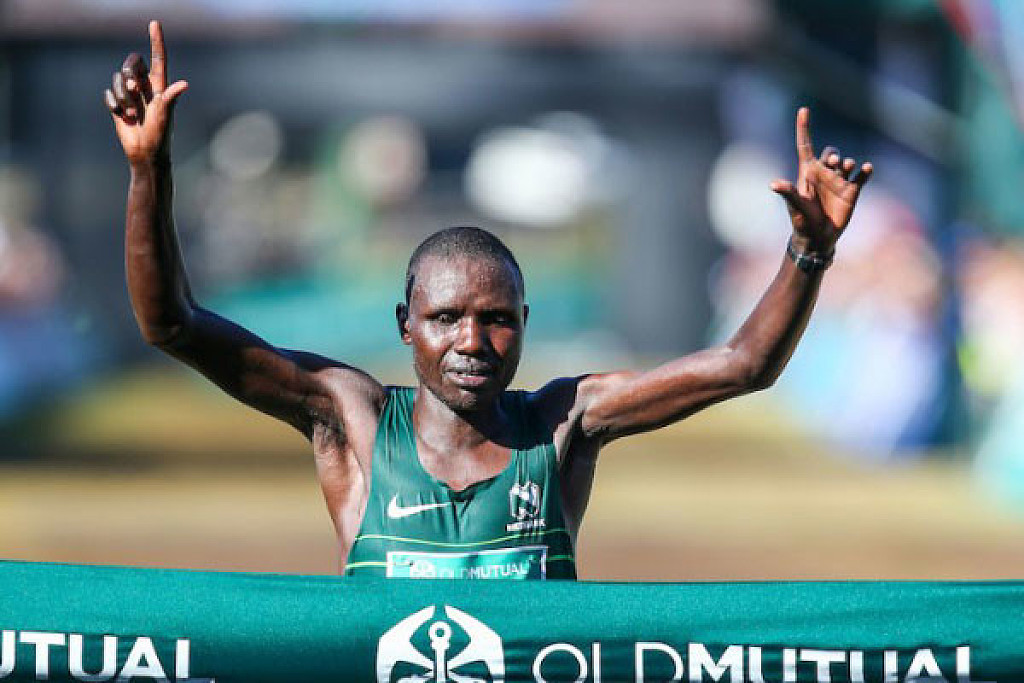Running News Daily
Running News Daily is edited by Bob Anderson. Send your news items to bob@mybestruns.com Advertising opportunities available. Train the Kenyan Way at KATA Kenya and Portugal owned and operated by Bob Anderson. Be sure to catch our movie A Long Run the movie KATA Running Camps and KATA Potato Farms - 31 now open in Kenya! https://kata.ke/
Index to Daily Posts · Sign Up For Updates · Run The World Feed
Articles tagged #ultra marathon
Today's Running News
Estefanía Unzu Sets New Spanish 100km Record in Canberra
Just under three weeks after completing the World Marathon Challenge—running seven marathons on seven continents in seven days—Spain’s Estefanía Unzu has shattered the national women’s 100km record at the Australian 100km Championship in Canberra.
On February 22, Unzu, a 39-year-old mother of eight, finished the race in 7 hours, 47 minutes, and 46 seconds. She was the first female finisher and placed second overall, just behind men’s champion Dominic Bosher, who completed the course in 7 hours, 45 minutes, and 30 seconds.
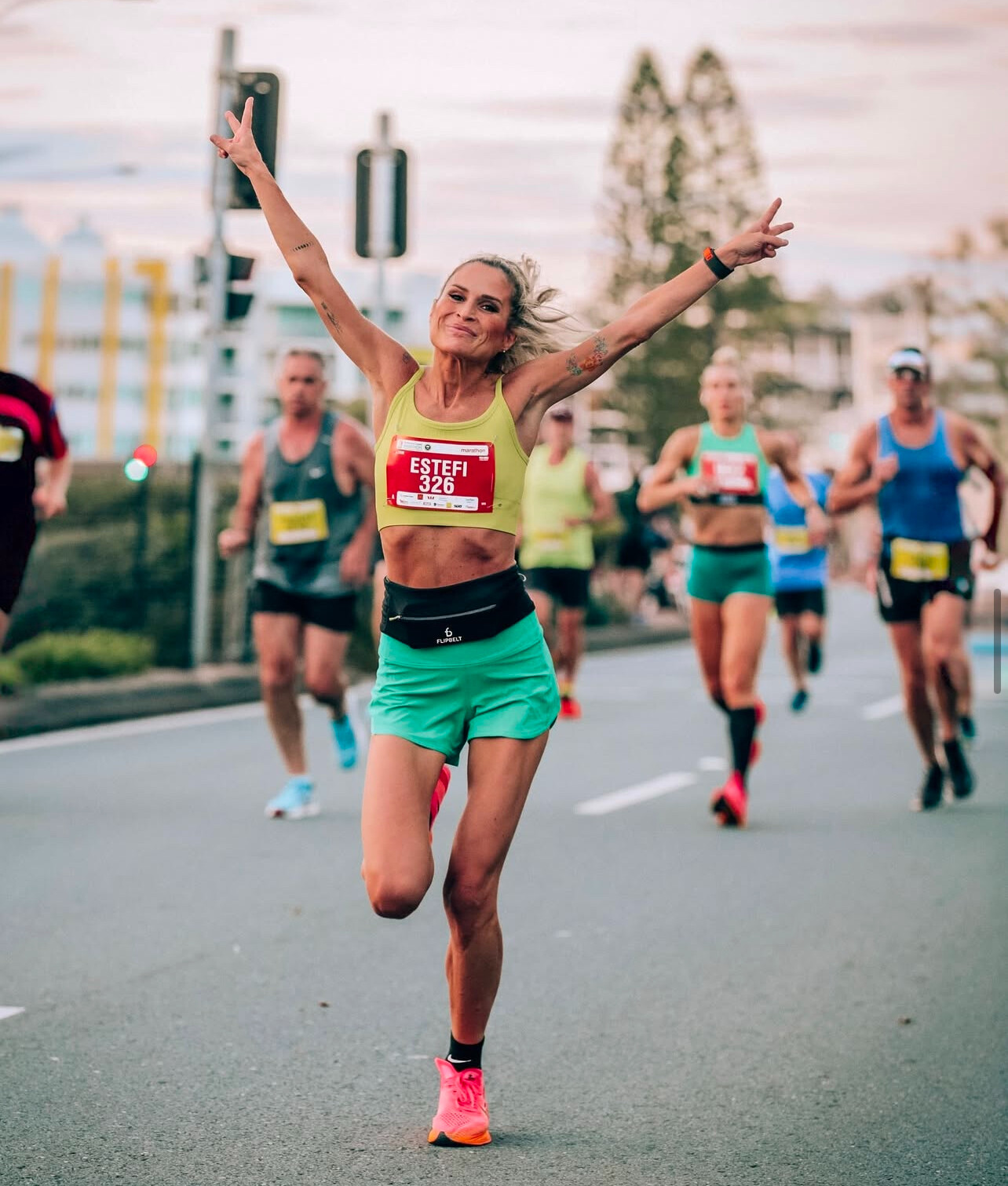
This performance broke the previous Spanish women’s 100km record of 7 hours, 52 minutes, and 21 seconds, set by Mireia Sosa in 2023. Overwhelmed with emotion, Unzu shared on social media, “I want to cry. My name will forever be a part of Spanish athletics history.”

Unzu’s achievement is particularly remarkable given her recent participation in the World Marathon Challenge, where she ran seven marathons across seven continents in one week. While many athletes require extended recovery periods after such endeavors, Unzu demonstrated exceptional resilience by promptly setting her sights on the 100km ultramarathon.

Known as “Verdeliss” on social media, Unzu has a substantial following, with nearly 1.5 million Instagram followers and over 2 million YouTube subscribers. Beyond her athletic pursuits, she is the founder and CEO of the cosmetics brand Green Cornerss and gained public attention after appearing on the sixth season of the Bulgarian reality show VIP Brother in 2014.
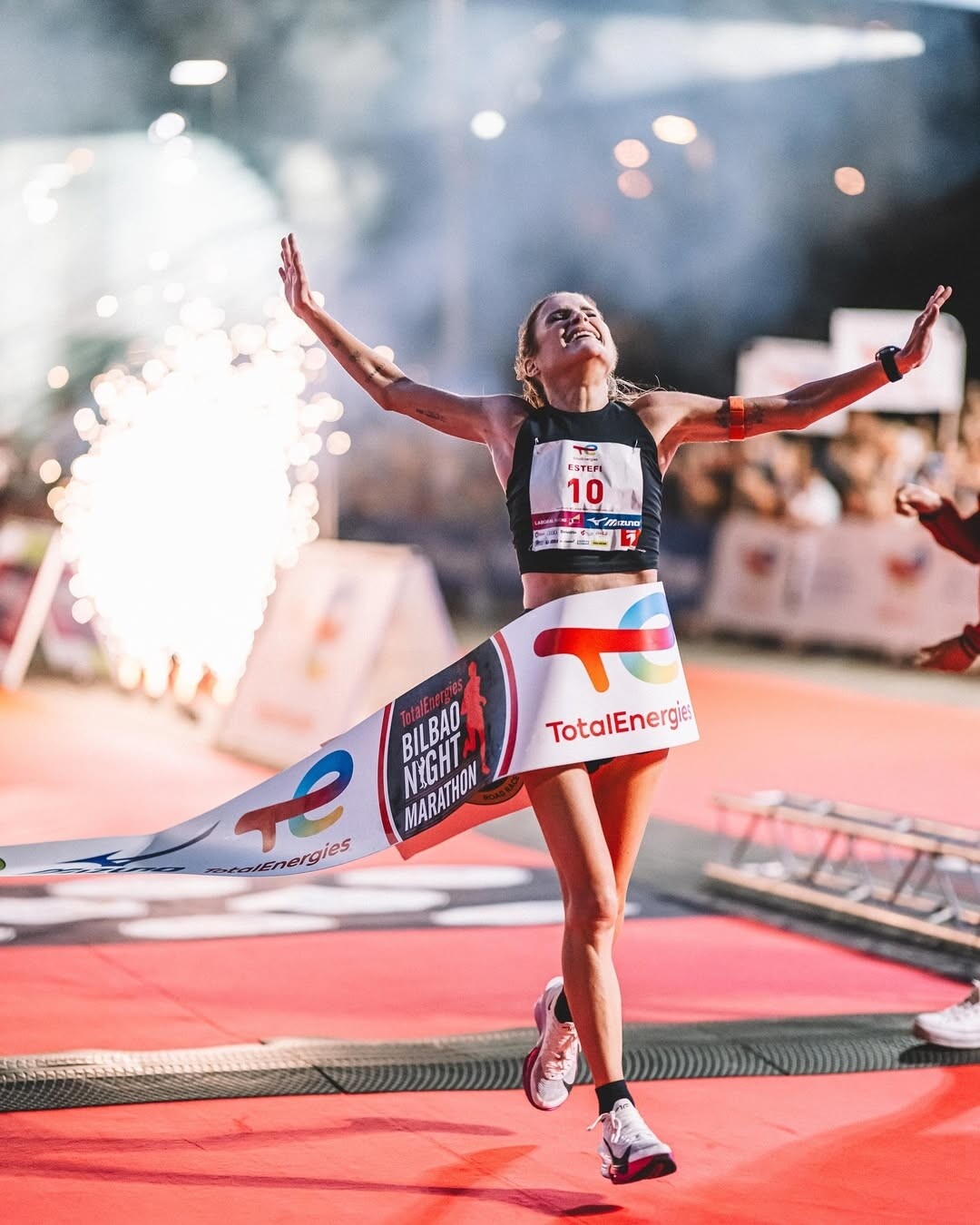
In May 2024, Unzu won the 100km distance at the Spanish National Ultra Marathon Championship with a time of 7 hours, 59 minutes, and 30 seconds. Her recent accomplishments have solidified her status as one of Spain’s premier endurance athletes, inspiring many with her ability to balance elite athletic performance and family life.

As Spain celebrates its new national record holder, the ultrarunning community eagerly anticipates Unzu’s future endeavors, confident that her determination and drive will lead to more groundbreaking achievements.
Login to leave a comment
Onalenna Khonkhobe closes superb season with Soweto Marathon victory
The 2024 Soweto Marathon was won by South Africa’s Onalenna Khonkhobe in a time of 2:18:36 on Sunday.
Khonkhobe also won this year’s Two Oceans Ultra Marathon.
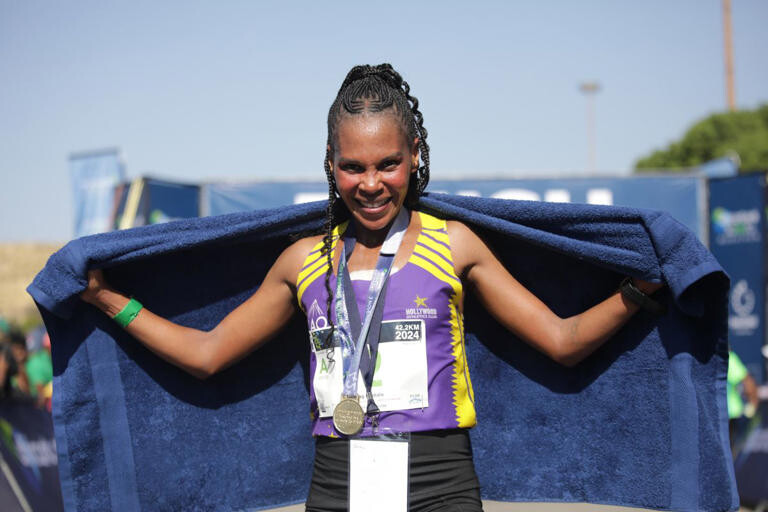
Second place went to Lesotho’s Joseph Khoarahlane Seutloali on 2:18:54, with Kenya’s Kipkemoi Kipsang in third in 2:19:05.
Meanwhile, the women’s Soweto Marathon was won by Lesotho’s Neheng Khatala in a time of 2:43:07.
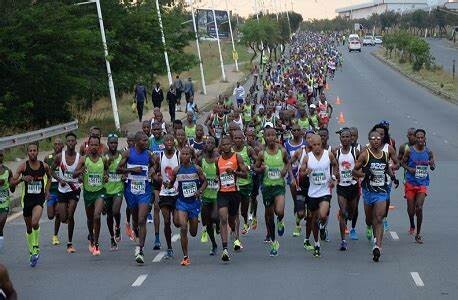
In an all-international podium, Kenya’s Margaret Jepchumba took second (2:44:55) with Ethiopia’s Worke Degu Amena rounding out the podium in third in 2:48:11.
‘Exceptionally proud’
Around 25 000 runners tackled this year’s Soweto Marathon, half-marathon and 10km races.
Soweto Marathon spokesperson Thokozani Mazibuko said he was exceptionally proud of the race and all those who worked tirelessly to ensure a safe, pleasurable and well run event.
“It’s been a fantastic day! This was one of the biggest Soweto Marathon’s since the inception of the race,
epitomising the spirit of Soweto!
“Our team and treasured partners have gone above and beyond for the valued people of Soweto, South Africa and far beyond our borders.
“We are truly grateful for those who helped us run a successful event and a hearty congratulations to our over 25 000 runners who took to the streets today.
“The Soweto Marathon medal is one of the toughest – and you’ve earned it fair and square so well done to you!”
by Garrin Lambley
Login to leave a comment
Soweto Marathon
The Soweto Marathon is an annual event which takes place in Soweto at the NASREC Expo Centre. It is a circular race and will begin and end at the Expo Centre.The marathon is sponsored by Energade, Netcare 911 and the MTN Expo Centre. Metro police will be directing traffic where there are road closures on the day.The Soweto Marathon is...
more...Ultra marathon queen Steyn wins fifth-successive Two Oceans, Khonkhobe reigns supreme for men
Gerda Steyn proved once again that she indeed is the queen of ultra marathon on the continent after she claimed her fifth-successive victory at the TotalSports Two Oceans Marathon in Cape Town on Saturday morning.
The 34-year-old from Bothaville in the Free State cruised to victory with a record time of 3:26:54, beating her 2023 time of 3: 29:05.
Relaxed as ever throughout the marathon, Steyn cemented her status as the country's best female ultra marathoner of all time.
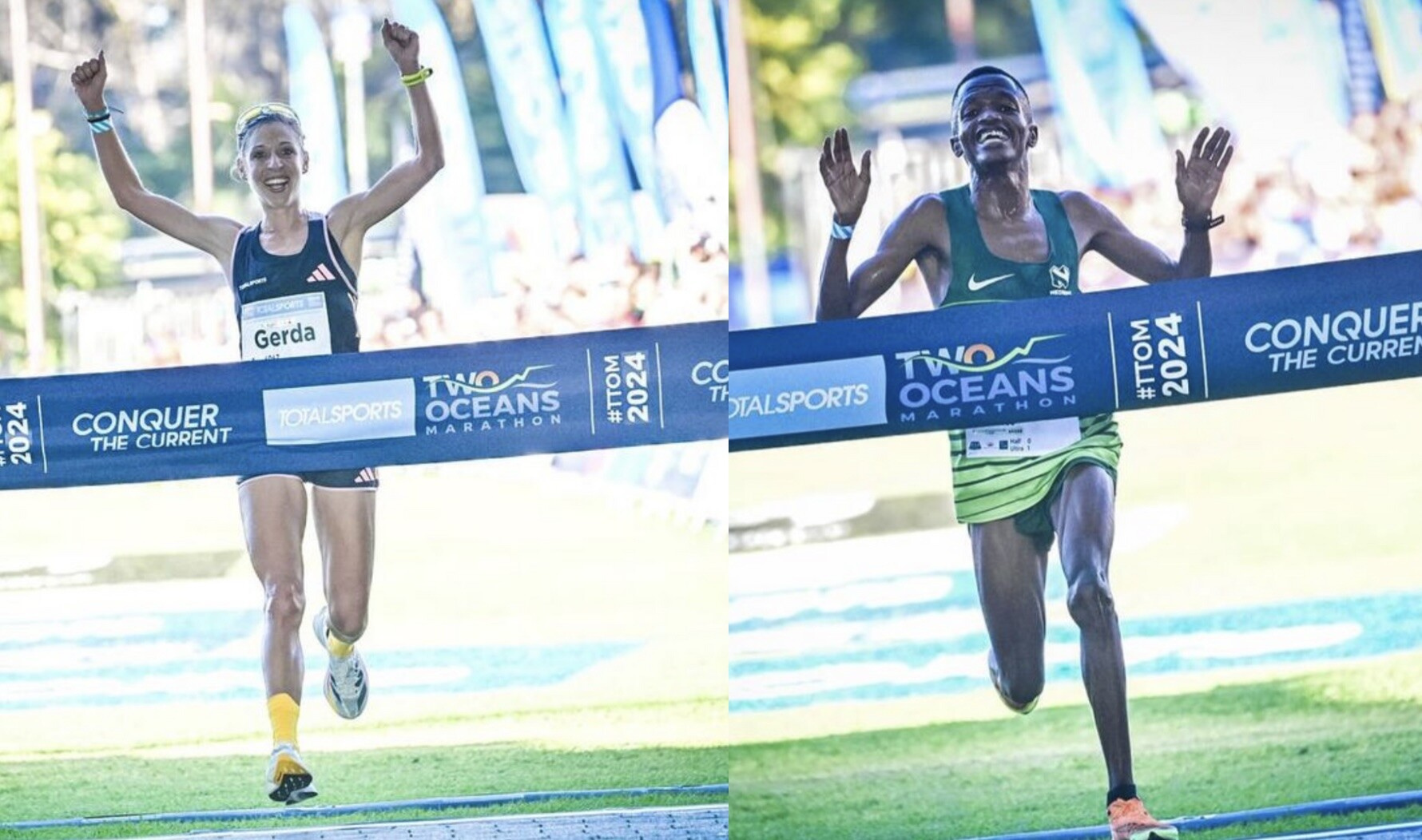
Representing her running club Phantane AC regalia, Steyn surpassed South Africa's Monica Drogemoeller (1988, 1990, 1991 and 1992) and Russian twin Elena Nurggalieva's (2004, 05, 09 and 12) records to be the most decorated ultra marathoner in competition.
Coming to the race, Steyn said she expected a hard-fought battle.

In windy conditions, it was clear from the start of the race that she meant business as she sped into the lead.
At 14km defending Champion Steyn, Irvette van Zyl, and Zimbabwean Loveness Madziva all formed a tight bunch of three, all running an average of 3:35 a kilometre.
At 28km, it became a two-horse race between Steyn and Van Zyl as they climbed small Chappie's neck on neck.
The race between the two titans, a classic rematch of two years ago, there was little separating the two as they descended Chapman's Peak.
At the marathon mark (42.2km), Steyn showed her supremacy and pulled ahead of van Zyl.
Nicknamed the “Smiling Assassin”, she looked unbeatable climbing Constantia Nek and the writing was on the wall for Van Zyl at the 50km mark.
As Steyn passed the finish line, she received a kiss on the cheek from her husband Duncan and cheers from the UCT upper campus sports ground mound.
Van Zyl finished second with a time of 03:29:30 while Madziva clocked 3:38:00 at the end.
In the men’s race, Klerksdorp's Onalenna Khonkhobe became the first South African since 2019 to win the race.
“I’m announcing my arrival; tomorrow you will acknowledge me.” Those were the words of Khonkhobe before the marathon.
He did exactly that with as triumphed in a time of 3:09:30 for top podium finish.
It was his second Two Oceans after making his debut last year, finishing in sixth place.
His Nedbank AC teammate, Lloyd Bosman finished second in 3:09:58 while defending champion Givemore Mudzinganyama could not repeat his 2023 feat, as he took third position in 3:11:13.
by Anathi Wulushe
Login to leave a comment
Two Oceans Marathon
Cape Town’s most prestigious race, the 56km Old Mutual Two Oceans Ultra Marathon, takes athletes on a spectacular course around the Cape Peninsula. It is often voted the most breathtaking course in the world. The event is run under the auspices of the IAAF, Athletics South Africa (ASA) and Western Province Athletics (WPA). ...
more...What is the UTMB? Meet trail running’s most difficult race
We answer all of your questions about this hellacious footsport event
If you’re starting to dip your toes into the crazy sport of ultrarunning, a couple of things will happen. First, you’re going to need several pairs of the best trail running shoes in rotation at any given time to put up with all those miles pounding rocky trails, and second, it won’t be long before you hear mention of the UTMB.
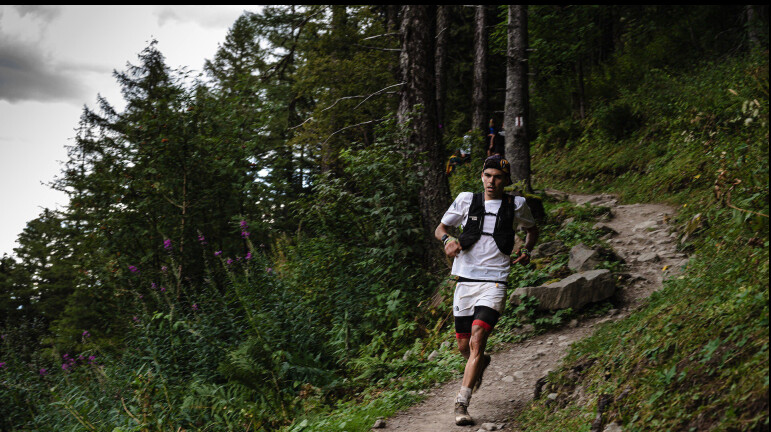
In fact, I recently attended the Arc’teryx Alpine Academy in Chamonix which holds a number of trail running clinics, and over the course of four days it was rare to have a conversation where the UTMB didn’t come up. Other participants in the academy wanted to know if our mountain guides had run it, how many times and whether they liked it (they don’t, considering it a tourist event) and mountain guides were keen to complain about how busy it made their favorite running trail.

But what is the UTMB exactly? Is it the ultimate goal for all trail runners? Why is it so hard? Here, we answer all of your questions about this hellacious footsport event.
What is the UTMB race?
UTMB stands for Ultra-Trail du Mont Blanc and is considered one of the world's premier trail ultra marathons. This demanding annual event follows the route of the Tour du Mont Blanc, a classic long distance hiking trail which circles the Mont Blanc Massif over 106 miles and passes through France, Switzerland and Italy. The UTMB begins and ends in Chamonix and is regarded as one of the most difficult races in the world.
The race takes place on the last weekend of August or first weekend of September and is today the ultimate in a series of events that take place around the world. Runners from all over the world aspire to compete in the UTMB. In the first year of the race, there were 700 participants, but these days, participation is capped at around 2,300 runners and other events have been created to allow for more participation.
The maximum cutoff for the race is 46.5 hours. In 2022, Kilian Jornet became the first to complete the UTMB in less than 20 hours (check out his race data to find out how he managed it) but most mere mortals can expect to have to run for two days and two nights to complete the race. Better bring some running gels then!
How does the UTMB race work?
Due to the event’s extreme popularity, you need to qualify to run the UTMB. That involves accumulating points through qualifying trail races over a two-year period. Qualifying races take place all over the world, from elsewhere in the Alps to Snowdonia, California, Mexico, Hong Kong and Australia. So if you’re serious about participating, you’ll have lots of time to train.
For each event you participate in and complete you’ll receive one running stone, which you can then enter into the lottery to be selected. You can enter the lottery at the UTMB website.
Why is UTMB so hard?
Besides the fact that at over 100 miles, it’s very long, competitors in the UTMB are also looking at 32,940 feet of elevation gain. In comparison, over roughly the same distance you could run the Leadville 100 in Colorado and gain only 11,000 feet (though at much higher altitude) or the West Highland Way in Scotland where you’d gain 10,300 feet.
The highest point of the route is 8,743 feet, which you’ll reach twice, in both Switzerland and France. That’s not extremely high altitude and it’s unlikely you’d experience altitude sickness at that height, but you’ll definitely notice shortness of breath and more challenging conditions, especially if you’re not already used to this altitude.
What you can also expect is more extreme conditions that come with trail running in the Alps. The altitude combined with the season means that the days might be swelteringly hot, while the temperatures at night could drop down around freezing at night.
How much does it cost to enter UTMB?
In 2023, the UTMB itself cost €335 to enter, plus administration fees. Of course, you’ll also have to pay registration fees for your qualifying events too. Your race will also include the cost of traveling to and from Chamonix, and accommodation while you’re there, but on the plus side the aid stations will be on hand to feed you during the race so you can save a little on those pricey Chamonix restaurants.
How many people have died in UTMB?
Sadly, deaths do occur in ultrarunning events and it’s perhaps more remarkable that for 17 years, no fatalities occurred during the UTMB, which not only places runners’ under extreme physical stress but entails a lot of night running. There have now been two deaths of runners in the UTMB, occurring in 2021 and 2022, both as the result of falls.
Do people sleep during UTMB?
Some runners somehow manage to do the UTMB without sleeping at all while others do sleep, but they’re not carrying a bivy sack and grabbing eight hours if that’s what you’re wondering. Sleeping during the UTMB looks like cat napping, and according to a 2015 study of 17 UTMB runners, the average time spent resting was between 12 and 17 minutes in total, and hallucinations were a common complaint, understandably.
Can you walk the UTMB?
Can you walk the UTMB? Well, yeah you could. Since the race is 106 miles and you have 46.5 hours to complete it, you technically could walk at a 2.3 mile per hour pace without any breaks and make the cutoff. Obviously though, you could just walk it at a time when the race isn't going on, save yourself €335 and enjoy far fewer people on the trail.
In all seriousness though, if you don’t already know, ultrarunning is actually hiking, and you’re not going to be running at the same pace you do on the tarmac back home. Even Jornet ran at an adjusted pace of around five miles per hour which isn’t exactly turbo speed (though it is if you maintain that for 20 hours). You’ll most likely walk the uphills and slow down or walk for rest periods, making up time on the downhills. And sorry, there aren’t many flats to speak of.
Login to leave a comment
Canadian ultrarunner still snagging podiums at 66
Trishul Cherns has firmly staked his place in the history of Canadian ultrarunning. But at age 66, the endurance athlete has shown with his recent ascents to the podium that he has no desire to dwell on past successes—nor should other runners who have entered their senior years. The Hamilton native, who lives in Kingston, N.Y., with his wife and crew leader, Käären Schilke-Cherns, has recently racked up no fewer than three podium finishes at ultras around the U.S., including second overall at the 144-hour 3 Days at the Fair road race in Augusta, N.J., in early May, covering 677. 53 km; third overall at the 33-hour Centurion Ultra Trail Event–Blue Buckle in Connecticut in June, completing 183.304 km; and earlier this month, Cherns won the 48-hour event at the Notchview Ultra in Windsor, Mass., covering 229.332 km on trails.
Cherns is best known as a multi-day racer, and throughout his career, has represented Canada in many international competitions. He has broken more than 110 Canadian ultrarunning records and has racked up tens of thousands of kilometres in events as short as 50K and as long as 1,600 km on roads, trails and the track. Altogether he has accumulated more than 300 ultra finishes during his career.
Cherns says beyond being personal accomplishments, these latest results speak assertively to the strength and potential of runners over the age of 65.

“Age is not a limit,” Cherns tells Canadian Running. “I still feel 30 inside, and I’m beating guys that are 20, 30, 40 years younger than me. So I think the message is, no matter what your age is, keep going and keep doing what you’re doing.”
Although age does offer runners the benefit of experience, running success in older life doesn’t just happen. Cherns says choosing healthy foods and cultivating a positive mental attitude have been crucial to his continuing to be a strong competitor.
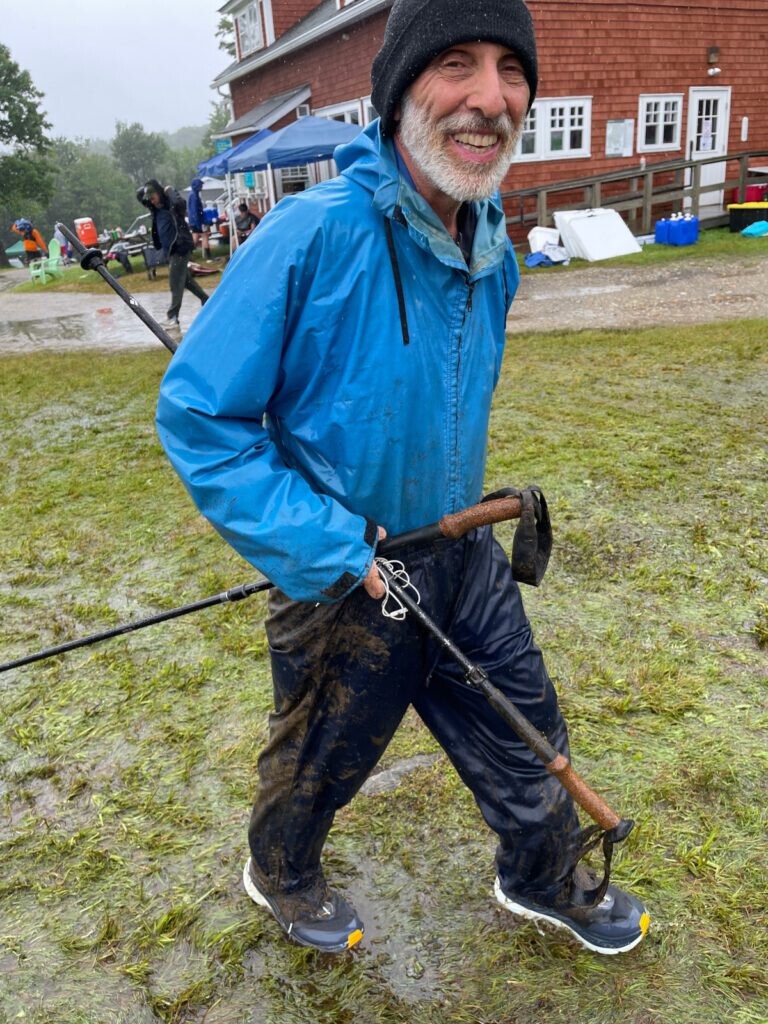
“My success definitely comes from my diet,” he says. “I’m a vegan, and that’s an anti-inflamatory diet. I’m trying to prevent inflammation in my body because these are stressful (running) events, so I’m trying to make it as easy as possible.”
He says meditation and approaching running as a spiritual practice have been key to maintaining a positive mindset during challenging races.
“Meditation and spirituality give me fortitude. Inner peace and stillness give me strength. I can do things that others can’t because of my inner fortitude, which supports my being very, very mentally strong and very, very emotionally strong,” says Cherns, who was a student of the late endurance athlete and spiritual teacher Sri Chinmoy.
Another key ingredient to continued success and joy in running is to continue to look ahead, says Cherns, and always to set one’s sights high. “My ideas are always self-transcending. I want to be prolific. I want to keep pushing my goals so that running is all a new adventure for me. I’ve run more than 300 ultras—in the next five years I’d like to bring that to 500. Ultimately, can I do 1,000 ultra marathons in my lifetime? You know, that’d be cool,” he says.
“I’m trying to go for the stars. There’s no reason why you can’t go for the stars, no matter what age you are.”
by Paul Baswick
Login to leave a comment
Candice Burt tapering off after 200 ultras in 200 days
Candice Burt completed her 200th ultramarathon in 200 days earlier this week and says her body is holding up well after the staggering feat.
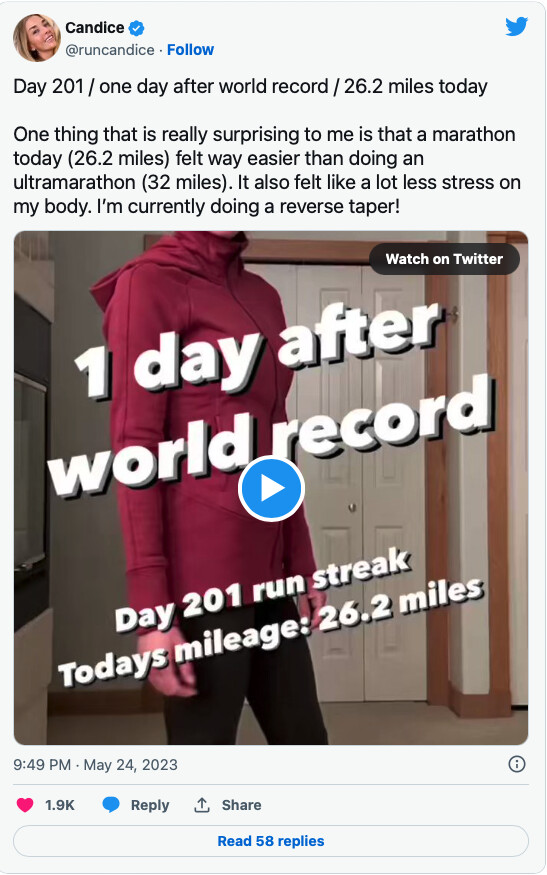
The American is set to claim the Guinness World Record once her endeavour is verified, with the previous best for consecutive days running an ultra marathon standing at 22.
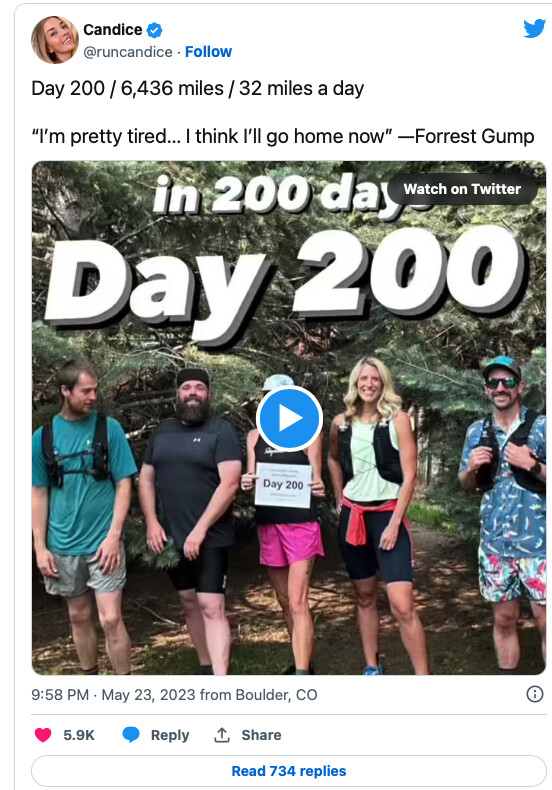
Burt, whose company Destination Trail is behind the Triple Crown of 200s – Tahoe 200, Bigfoot 200 and Moab 240 – covered over 6,400 miles after setting off on November 5, 2022.
She even ran the HURT 100 in Hawaii to continue her streak on days 71 and 72, a brutal race David Goggins has taken on four times, failing to finish in 2012.
Mental resilience
“Every morning I woke up and got it done no matter what,” she wrote on Instagram after finishing her final ultramarathon. “Thank you to the men and women who set the bar before me!”
“Records inspire us to find within ourselves courage and discipline to advance humanity
“This run has been about me trusting my body & adapting to every demand I encountered along the way. It is a personal quest, one in which I looked to satiate my curiosity about endurance, my body, running and the mind.
“That fire has only grown.
“My heart is content and I’m excited about my future adventures and spending the summer with my kids exploring Colorado.
“It’s truly incredible how good my body feels, although I’ll be the first to admit it’s changed a lot of the past 200 days. Some changes are good, some are not.”
Easy marathon
Burt is now in the process of winding down after her eye-watering schedule, but still ran a typical marathon – 26.2 miles – the day after her 200th ultra, undeterred by an “epic” thunderstorm in the latter stages.
“One thing that is really surprising to me is that a marathon today felt way easier than doing an ultramarathon,” she wrote in another Instagram post.
“I don’t have much fatigue running even 20 miles, but as I taper off the world record, part of me seems to be allowing myself to think, ‘my legs feel tried today’ instead of having to box that up and file it away.
“When you’re running a 50k a day no matter what, your feelings don’t really matter. Pain or tension in the body is used to indicate where to focus on any rehab/PT rather than to feel sorry for myself or shorten the run.
“This allowed me to grow, adapt and achieve a higher level, but it came at some cost.
“What’s the cost? There’s a bit of a disconnect between my feelings and sensations and the run. Those sensations — at least the pain or immobility ones—are saved for after the run and only for the context of treatment. My feelings, when negative, were filed away completely because they weren’t needed or helpful.
“I think learning to do this is very helpful in many endeavours. But to live in the world outside the runs I sometimes need to access these things more readily. Just an observation – one that I hope to delve into a bit more at some point.”
Flexibility decrease
Burt reiterated that her physical condition is remarkably solid, aside from some understandable stiffness following her relentless running effort.
“Let’s talk about my body: physically I feel great. There are times I’m not sure if its as great as I think or if I just got used to a high level of tension. I will get up and I can tell my muscles are sharp and ready.
“My flexibility has been significantly reduced in favor of stability and propulsion. This serves me well when running, but can make other daily tasks harder.
“For example, I cannot sit on my heels with my toes under me stretching the bottom of my feet. My feet simply don’t stretch like that anymore.”
Burt is eyeing more record-breaking runs in the future, but for now, she is enjoying a return to normality and spending time at home with her children.
Login to leave a comment
Top six reasons ultra runners are a breed apart, Ultrarunners' brains might be wired differently (how else to explain it?)
Ultra runners are pretty unique athletes. How many people are willing to run 50K, 100K, 100 miles or more? The answer is not a lot, which is why ultra running is so different from other sports. There are things that ultra runners do that no other athletes (not even short-distance runners) understand. Don’t believe us? Take a look at these few differences between ultra running and other sports.
Eating contests
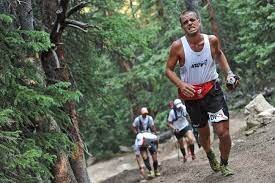
To run an ultra marathon, you have to train well, but when race day arrives, your success will come down to how much you can eat–because after you’ve been running for several hours, your digestive system might be a little out of whack (and what goes in has been known to come back out). If you can keep enough nutrition down to keep your energy levels high for the entire race, you’ll do well.
To do that, ultra runners will eat some pretty random things on the race course (flat Coke and scalloped potatoes, anyone?), besides your classic energy gels and electrolyte drinks. Athletes in other sports are very careful about what they eat or drink before and during competitions, but for ultra runners, it seems like pretty much anything will work as fuel to get them to the finish line.
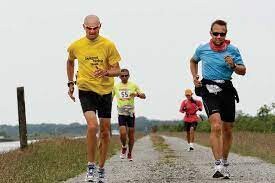
Weird sleeping habits
A basketball player wouldn’t take a court side nap, just like a hockey player would never go to sleep on the bench or in the penalty box, but that’s not the case with ultra runners. If you’re in a race that will take you more than a day to complete, you’re going to get pretty exhausted on the course, and that might mean you’ll need to take a nap break at some point–even if it means lying down by the side of the trail, or in a ditch, for a few minutes of shut-eye. (It’s called a dirt nap, for the uninitiated.) Ultra runners get pretty good at sleeping anywhere and for however long, so they can re-energize and get back to racing.
No rush
In most sports, you’re encouraged to go as fast as possible, because your speed will be rewarded with a touchdown, goal, basket or some other form of points. In ultra running, athletes aim to complete each race in good time, but there’s no rush. In fact, going too fast will only hurt your result and jeopardize your chances of finishing the race at all. Ultra runners quickly learn how to find a comfortable pace that they can hold for hours upon hours (or even days) of running and power-hiking.
No end
While most ultra marathons have set distances, some events are open-ended and go as long as it takes until only one runner is left standing. These are known as backyard ultras, and they task competitors with running a 6.71-km (4.17-mile) lap every hour for as many hours as they can. One by one, athletes will drop out of the race, either because they can’t go any longer or because they don’t complete a lap before the hour is up. Can you think of any other sport with this last-runner-standing, no-end-in-sight format? Didn’t think so.
No schedule
The Barkley Marathons is one of the most infamous ultra marathons on the planet, but despite its cachet, it is incredibly secretive. The race’s start date isn’t even public knowledge until the athletes are at the start line. This would never fly in other sports. The NHL couldn’t tell players to be on-call and ready for a random start date for a game, but in the world of ultra marathons, this system works (for the Barkley Marathons, at least).
Get emotional
After running 100 miles, you’re going to be beaten down, both physically and mentally. Because of this mental wear, you may burst into tears at any moment. In most sports, crying may be a sign of weakness, but in ultras, it’s pretty normal. No one’s going to judge you, and who knows, if they see you crying they may join you.
by Ben Snider-McGrath
Login to leave a comment
Gerda Steyn hopes for a fourth win at Two Oceans
With 50 days to go to the “world’s most scenic race”, the Totalsports Two Oceans Marathon (TTOM) is shaping up to be an elite fest with a stellar field.
Once again, any athlete who breaks the record in the Men’s or Women’s Ultra Marathon Race can look forward to a record incentive of ZAR 250,000 (EUR 12,800) in cash.
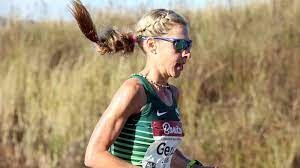
With prize money for the Totalsports Two Oceans Ultra Marathon at ZAR 250,000, any record-breaker could look forward to a massive ZAR 500,000 pay day on 15 April 2023.
Nkosikhona “Pitbull” Mhlakwana, who made a sensational Totalsports Two Oceans Marathon debut last year, lived up to his nickname showing tremendous tenacity finishing in a superb second place behind Ethiopia’s Endale Belachew, with Sboniso Sikhakhane coming in third.
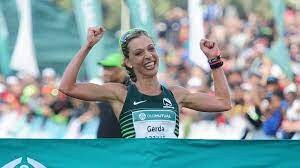
As expected, the 30-year-old considers himself to be a bit stronger and wiser, and determined to do one better this year.
“My main goal is to improve my position from last year,” says Mhlakwana.
The Hollywood Athletic club athlete says he picked up invaluable experience last year and now knows what to expect.
Another epic battle for supremacy is expected this year in the women’s Ultra. Gerda Steyn and ASICS athlete, Irvette van Zyl, who both shattered Frith van der Merwe’s longstanding women’s 56km record of 3:30:36 set in 1989, have confirmed they will line up again this year.
Steyn (3:29:42) became the first woman to run the grueling route in sub 3:30. The 32-year-old returns this year in a bid to be crowned champion for an unprecedented fourth consecutive time, while running as the current record-holder.
The three-time champion, who will be running in her permanent blue number, 6067, will, however, not have it all her own way, with the 34-year-old Van Zyl (3:30:31) finishing just a few seconds behind her last year. The purists can rest assured that Van Zyl will come out guns blazing and ready for another classic battle with Steyn.
Steyn says she is very excited to be preparing for the Totalsports Two Oceans Marathon again.
“This will be my fifth time running the race, and I am really hoping for a fourth win after taking the title three times in a row now. Last year was such a highlight for me. I am just hoping to repeat that experience and that win. The preparations until now have been going well, which makes me even more excited for the race,” she says.
With 50 days to go before Race Day, Steyn feels the next three to four weeks will be crucial to her preparations.
“Another very exciting aspect of this year’s Totalsports Two Oceans Marathon is that it will be the first time that I will be running in my permanent number in any race.
“Usually, one has to complete 10 Ultra Marathons, but I managed to win the race three times, therefore earned a blue number. This brings a very special touch for me. At the moment I am preparing for the Two Oceans in Johannesburg. The energy level and excitement is at an all-time high," adds Steyn before wishing all runners everything of the best with the final stretch of preparations.
If excitement levels are high for the Ultra on the Saturday, the battle for supremacy in the Half Marathon on Sunday, 16 April, will be even higher. The likes of previous winners Stephen Mokoka, Elroy Gelant, as well as Precious Mashele from the Boxer Athletic Clubs, have all confirmed their entries. Moses Tarakinyu from Zimbabwe is back to defend his title with Entsika’s Desmond Mokgobu also looking to improve on his third place from last year.
Last year’s winner, Fortunate Chidzivo, will not be lining up to defend her title in the women’s Half Marathon this year, which leaves the race wide open for a new champion to be crowned.
by AIMS
Login to leave a comment
Two Oceans Marathon
Cape Town’s most prestigious race, the 56km Old Mutual Two Oceans Ultra Marathon, takes athletes on a spectacular course around the Cape Peninsula. It is often voted the most breathtaking course in the world. The event is run under the auspices of the IAAF, Athletics South Africa (ASA) and Western Province Athletics (WPA). ...
more...Hellah Sidibe Runs Frustration into the Ground
The former soccer phenom was burnt out and angry. Then he started running every day, no matter what.
Hellah Sidibe shared his story with producer Sarah Vitak for an episode of The Daily Rally podcast. It was edited for length and clarity.
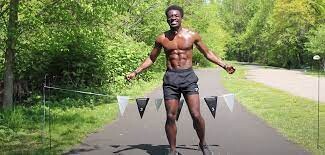
I went into this dark area in life where I was just mad. Why is this happening to me?
It all came down to, all right, I’m pissed at everything, but let me stop making excuses. Just look at myself, and just deal with what I can handle, what I’m in control of. That’s how it started.
My full name is Hellah Sidibe, but I have a nickname: Hellah Good. I got that nickname back in college. I played Division I soccer. Every time I would take the ball and start sprinting down the line, they’d just say, oh, he’s Hellah good.
Growing up in Mali, West Africa, soccer was the number one sport. We just loved playing, and we loved watching the top players on TV. We were trying to play like them: we were trying to score goals and celebrate the way they do.
We lived in an area where there’s dirt, so we would use our feet to trace and make marks. You would literally make the whole soccer field. In order to still see the line, we would go into our kitchens. When we make food, we make food with wood and charcoal. Everybody would fill that up in a can from their house and bring it to the field. The path that we created with our feet, we’d spray that chalky gray-white powder along those lines so it looked like the white soccer lines.
We’d pick teams. Say: you’re Brazil, you’re Argentina. We’d always take the South American teams because they were the best in the world at the time, when I was young. We would pick players, and we would be like, you’re Thierry Henry, you’re Luís Figo. I’d say, I’m Ronaldo Nazário. Sometimes you’d just paint their numbers on your back, on your bare skin.
We would recruit our own team within the neighborhood. The next neighborhood was within a five-minute walk, and we’d go play them. Their neighborhood we would call allez, which is away. And there was no pressure. We did it because we wanted to, and no one was yelling at us.
When I came to the U.S., it got a little competitive. There started being consequences. If you didn’t do something right, the punishment was: let’s make you run. So I got to college, and it added more to that because I was playing under a coach. His mindset was that we might not be the most skillful team in the country, but we’re gonna be the fittest team in the country. It was to a point in that sometimes the track team would joke around and say, are you guys with the UMass track team or the soccer team? Because whenever they went by the field, they’d see us just huffing and puffing.
So I started hating running. I would cramp up in my calves, my lungs would be burning, and my hamstrings would be on fire. I started having a fear of it. It wasn’t a fear where I hated the game, but it was fear of going to practice for that specific reason. You’re getting yelled at like it’s not enough, even though you feel like you’re giving your absolute best.
Out of almost 400 players, I was one of 20 picked up to face the US youth national team. All of those teams were after me: phone calls from teams, telling me, we want this player. We like his skillset. I was approached by Sporting Kansas City my senior year, and they were one of the top teams in the MLS and won the MLS Cup the year that I finished college.
I was told: you’re gonna get picked up in the draft.
There were domestic roster spots and international roster spot at the time. I don’t know if that’s changed; I haven’t really looked into it. It was the rule that only eight international players could be picked up per team, and the rest had to be domestic players.
The assistant coach at Sporting Kansas City was like, hey Hellah, I’m sorry to tell you this, but the reality is right now. We’d rather have a young player that is a U.S. citizen that’s not as talented as you, but we can develop them and we don’t have to worry about the paperwork side of it. But also we can pick up a big European player that can sell jerseys and tickets that can take the spot. Versus, I’m somebody who hasn’t made a name for himself.
He was just telling me the reality. It wasn’t even his decision.
Just seeing that—it is frustrating, and it’s tough. Your goal is to play the game that you love, and it’s getting pulled away from you.
I just started hating everything. I’m not a doctor, but I do think there was some depression looking back. When you’re in that spot, nothing matters. Someone could smile at you or could even want to hug you, and you want nothing to do with that.
It was a looking-at-myself-in-a-mirror moment. What can you do with yourself right now? What are you in control of? I literally had that conversation with myself. Being an athlete, you always fall back on your physical ability because it makes you feel a certain way mentally. You like challenging yourself. You like competing on the field.
I was just like, what are you gonna do now? You tell yourself you’re going to go to the gym every day for a week, and you can’t even last three days. Do something, and hold yourself accountable for once. Be consistent.
So that is what led me in 2017 to when I said, what is a fear of mine that I wanna face? And running was the first thing that hit my mind.
It was a two-week goal of ten minutes a day within the first week. I didn’t care about distance. It was time. I would just start my watch, and then after ten minutes I’d be done, so I’d be just over a mile.
The ten-minute goal wasn’t because I couldn’t do more than ten minutes; it was just attainable. I just knew that it wasn’t so much where I was going to hate it.
That didn’t last more than a week. Even within the first week, I was going as far as four miles, which is way longer than ten minutes. But I would get lost in it. It wasn’t about pace or distance or anything. It was about just being out there in the present moment.
I ran every day for two weeks. And then I said, I don’t want to get ahead of myself, but I can see myself doing this for the rest of my life. Let me do it every day for a year.
And now we’re here, running every day for 1,989 consecutive days. About to hit 2,000 consecutive days. And running across the U.S., doing a hundred-mile race, and still loving it like day one.
When things aren’t necessarily working out in life, it does mean it’s the end of you. It just means that it’s preparing you for something even greater. You just have to focus on what you can control and keep putting one foot in front of the other. Right now, I would not trade this for anything. Nope, I would not.
Hellah Sidibe is a runner, speaker, and content creator. He has run for more than 2,000 consecutive days. In 2021, he ran across the United States. In September of 2022, he competed in the Leadville Trail 100 Ultra Marathon. You can learn more about him at hellahgood.com.
by Outside On Line
Login to leave a comment
I Replaced Running Gels with Real Food and This Is What Happened
I'm obsessed with running gels.
"You're hooked," my fiance would say every time I came home from a trip to my local running store with a heap of energy gels. It's not goo, I would tell him. It's gel. I thought he was just gel-ous that I basically got to eat frosting on my long runs, sucking down flavors like salted caramel, birthday cake, campfire s'mores, sea salt chocolate My mouth is watering.

I discovered the magic of gels when I started running marathons two years ago. It was a great trade-off in my mind - you're running longer miles, so you get a reward about halfway. Fun! I distinctly remember running the Hamilton Glow Marathon in Hamilton, Ohio and shouting at my dad on the side of the course, "I GET TO EAT A GEL SOON!"
But, I'll be honest, my zealousness for energy gels was not the most financially healthy habit. Gels are $1.60 a piece at my local running store and I bought three or four a week to stick in my drawers, backpack, car and jackets. After a year of this, I estimate I spent around $300 on gels alone.
Even more concerning, I believed I wouldn't be able to run well without gels and never completed a long run without one. I went out of town one weekend and didn't bring any gels, so I refused to join my dad for a long run. At the time, I truly thought I wouldn't get through half the run without a gel.
That particular weekend out of town was eye-opening. I knew I wanted to stop leaning on gels but still needed a way to replenish lost electrolytes and glycogen. So I decided I was going to start substituting energy gels with whole, real foods to prove I didn't need them to be a good runner. It was time to face my fears and kick the crutch I'd been leaning on for over a year.
What to Look for in an Energy Gel Replacement
The editors at Women's Running provided a perfect resource for learning what I needed to do to fuel my long runs with natural foods.
Authors Caitlyn Pilington and Malissa Rodenburg write: "Fueling is important during long runs, but your choice of what to fuel with lends itself to flexibility. Ultimately, all of our bodies are different and therefore tolerate things differently. You'll no doubt see a majority of athletes fueling themselves with gels, blocks, sports drinks, or other commercial products. And there's honestly nothing wrong with that-sports products are engineered to be absorbed properly and help you perform."
There are all kinds of brands of energy gels, but I'll be touching on my favorite, GU. Each packet contains 100 calories, 125 mg sodium, 40mg potassium, 22g of carbs and 7g of sugar. So a gel replacement would need to cover those bases plus be compact, easily digestible and (hopefully) tasty.
Nutritionist Sarah Cuff focuses on holistic fueling, so she was eager to speak on the topic of replacing gels with whole foods. She says the three main factors to consider in a gel or whole food replacement are sodium, carbohydrates and sugars.
Sodium
If you're a 'super sweater' like me (I could fill a bathtub wringing out my running clothes) you'll want to pay close attention to this next bit.
"When we sweat, sodium is the electrolyte lost at the highest proportion," Cuff says. "So while most energy gels will include some potassium and magnesium and calcium, they are not necessarily required because we don't lose them in any high amount when we sweat. Sodium is most important."
She adds that the amount of sodium needed depends on a variety of factors like how much you generally sweat, the temperature and how much energy you're exerting. Cuff says a good rule of thumb is if you're drinking one liter of water an hour, you want to make sure you're intaking at at least 600 mg of sodium. Learning this, I realized the sodium in my favorite GU gel and the whole food replacements don't meet those standards, so I needed to supplement with sodium in my water.
"Some athletes who want to be as natural as possible might use coconut water and sprinkle sea salt in it - it's not super tasty, though some people like it," Cuff says. "I'd suggest getting a natural electrolyte drink such as Skratch Labs Hydration or Tailwind. Make sure they have at least 300 mg of sodium per serving."
Carbohydrates
"Another important number we want to be looking at is the carbohydrate number, because that's what primarily fuels our long runs," Cuff says. "We know from studies that we need 30-60g per hour on long runs and up to 90g on really long runs (marathons, ultra marathons) to adequately replace what we're burning. The question is, where can we get those carbs?"
GU gels contain a sort of 'super' carbohydrate called maltodextrin, which is easily broken down while exercising and therefore great for most athletes - though it can cause gastrointestinal issues in some. So my whole food gel replacements need to contain up to 90 grams of carbs and must be as easily broken down as maltodextrin.
Sugars
Sugars are required for the fueling process on long runs. Most gels use carbohydrates like maltodextrin to produce glucose and fructose. When you intake sugar, your body breaks it down into glucose and fructose which can be used for energy right away.
"Ideally, we're looking at what's easy for our digestive system to break down while we're running," Cuff says. "Sugar is digested pretty darn quickly. Now, straight table sugar would be difficult to stomach, but there are companies who have packaged maple syrup into small serving sizes. That's a very natural whole food alternative to gels."
My Energy Gel Replacements
Over the course of four weeks I packed five different snacks on my longer runs, ranging from 10-16 miles, and ranked which ones worked the best for me and which ran me into the ground. I also took Cuff's advice and tried Skratch Labs hydration drink mix, which contains 70 calories, 17g of carbs, 15g sugar and 710 mg sodium per serving.
White Bread with Honey
Calories: 132 | Carbs: 28g | Sugar: 7g | Sodium: 180mg
Probably the most boring sandwich I've ever made turned out to be my favorite energy source during this experimentation period. I took one piece of white bread, drizzled on a little bit of honey, folded it up and wrapped it in a sandwich bag. It fit neatly in my running pack around my waist and, even if it did get a little smushed, tasted glorious when I needed it. I had zero tummy troubles and felt as energized as when I took an espresso flavored gel.
Sweet Potato
Serving size: 4oz. | Calories: 112 | Carbs: 26g | Sugar 6g | Sodium: 73mg | Potassium: 448mg
I'm a fiend for sweet potatoes. They're excellent for running because of their phytochemical content which can reduce post-workout inflammation - and I'm usually all kinds of inflamed after a good tenner. I chose a small sweet potato, about the size of my palm, and cooked it long enough before my run so that it was cooled. I wrapped it in a paper towel and stuck it in my pack and, when the time came, I ate that sucker like it was a donut, skin and all. I didn't finish the whole thing, because half did the trick. I felt fueled and it digested well. The trade-off is the low sodium content, but because I supplemented with my water, it evens out.
Banana
Serving size: Medium banana | Calories: 110 | Carbs: 28g | Sugar 15g | Potassium: 450mg
Tried and true, I knew bananas would never fail me. This is often my pre-run snack because I can digest it easily and it has carbs and natural sugars that are broken down quickly. The downside is that it didn't fit in my running pack, so I had to put it in my jacket pocket, which was a little uncomfortable. Like the sweet potato, there's little sodium, but I had my supplemented water.
Cereal
Serving size: cup| Calories: 100 | Carbs: 20g | Sugar 1g | Sodium: 140mg | Potassium: 170mg |
For this energy gel replacement, I packed a cup of dry, plain Cheerios in a tiny baggie. While I'm a big fan of cereal, it's not exactly easy to pour into your mouth while running. I also didn't feel as fueled during the second half of my run, leading me to believe I might not have packed enough. The issue is, if I packed anymore, I'd be crunching cereal for a whole mile. Plus, it really dried out my mouth and made me thirsty.
Dates
Serving size: 2 dates | Calories: 133 | Carbs: 36g | Sugar 32g | Potassium: 334mg
I had high expectations for this snack. Dates are delicious, compact and full of natural sugars, so it makes sense why runners sometimes substitute them for energy gels. However, I didn't anticipate how the three medjool dates would glob onto each other into a golf ball sized glob. That wasn't the biggest issue though; my stomach did not do well with dates. I experienced camping, bloating and overall my digestive issues caused me to cut the run short. Further research led me to discover that my body must not have liked the high amount of fiber and sulfites in the dates. So this snack may work for some, but for me, it was a hard pass.
Will I Give Up Energy Gels?
This experiment resulted in more than great runs and weird stares (have you ever seen a runner chomping on a whole sweet potato?!), it also provided me with the answer that I was looking for: I don't need energy gels to be a good runner. They're not a magical potion that gives me a boost as good as the speckled mushroom in Mario Kart.
But, energy gels are a useful, efficient tool to quickly recover lost glycogen and keep you going on long runs. I certainly have no desire to give them up, but I know now that I can substitute a gel for whole foods, if I so please. In the weeks after my trial, I purchased one gel. Given my track record, I'd say that's pretty goo-d.
by Trail Runner Magazine
Login to leave a comment
Dutchman Lodewijk Adriaan Vriens wins first race in Hong Kong 50 ultra marathon series
Hong Kong 50 ultra marathon got off to a blistering start with Dutchman pipping local favourites in the men’s division, while Cheung dominated the women’s field
The second leg of the four race series takes place on Lantau on December 10, with HK50 West and Sai Kung 50 taking place in early 2023


The Hong Kong 50 ultra marathon series got off to a solid start on Sunday, with Dutchman Lodewijk Adriaan Vriens storming a field of almost 500 runners to claim line honours.
While Vriens battled strong competition from Chan Ka Keung and Wong Kwok Wai – who came in second and third respectively – the Dutchman paced himself early in the race but surged in the second half to extend his lead and finish with a time of 4 hours and 47 minutes.
“Today’s race was really, really cool and a really phenomenal feeling,” Vriens said. “It’s a really tough course, but I had a lot of fun. The organisers did great, really good spirit out there and some really good competition.”
Chan, one of Hong Kong’s top up and coming runners, had a very strong finish, putting the hammer down on the final 1km to squeeze by Wong for second place with just a few hundred meters remaining.
“I was happy with a strong finish catching Wong Kwok Wai who tried very hard also at the end. The race was really exciting and the scenery on the last 20km was beautiful which made the change of scenery from my home training area in Tsuen Wan very different,” Chan said.
“Coming down Jardine’s Lookout I took a fall kicking a step, but brushed it off and kept pushing as was top three at the time.”
Crossing the finish line in 3rd overall in the Men’s 50km was Wong Kwok Wai who ran a fantastic race leading and trading places for almost half. He came within striking distance of the Dutchman and Chan, but did not have the legs in the last few hundred meters to mount a full tilt attack.
Karen Cheung Man-yee dominated the women’s field to win in a comfortable 5 hours 30 minutes 38, almost 30 minutes ahead of her nearest rival Wong Mei Ying, who took second place.
“Overall, the race was great,” Cheung said. “I thought my run was very smooth. The weather was good and I was happy with my performance. I am very happy to be able to run in a physical race like this as I enjoyed it so much being around others in competition.
Third on the women’s 50km podium was South African Deena Schwan who took up ultra running just over a year ago.
The second leg of the four race HK50 series will take place on Lantau on December 10, with HK50 West and Sai Kung 50 taking place in early 2023.
Login to leave a comment
Reykjavik opens registration for non-binary athletes
Participants can now select female, male or non-binary in the entry system for all Reykjavik Sport Association (RSA) running events.
Registration opens in the beginning of November in Islandsbanki Reykjavik Marathon, Laugavegur Ultra Marathon and the Suzuki Midnight Sun Run.
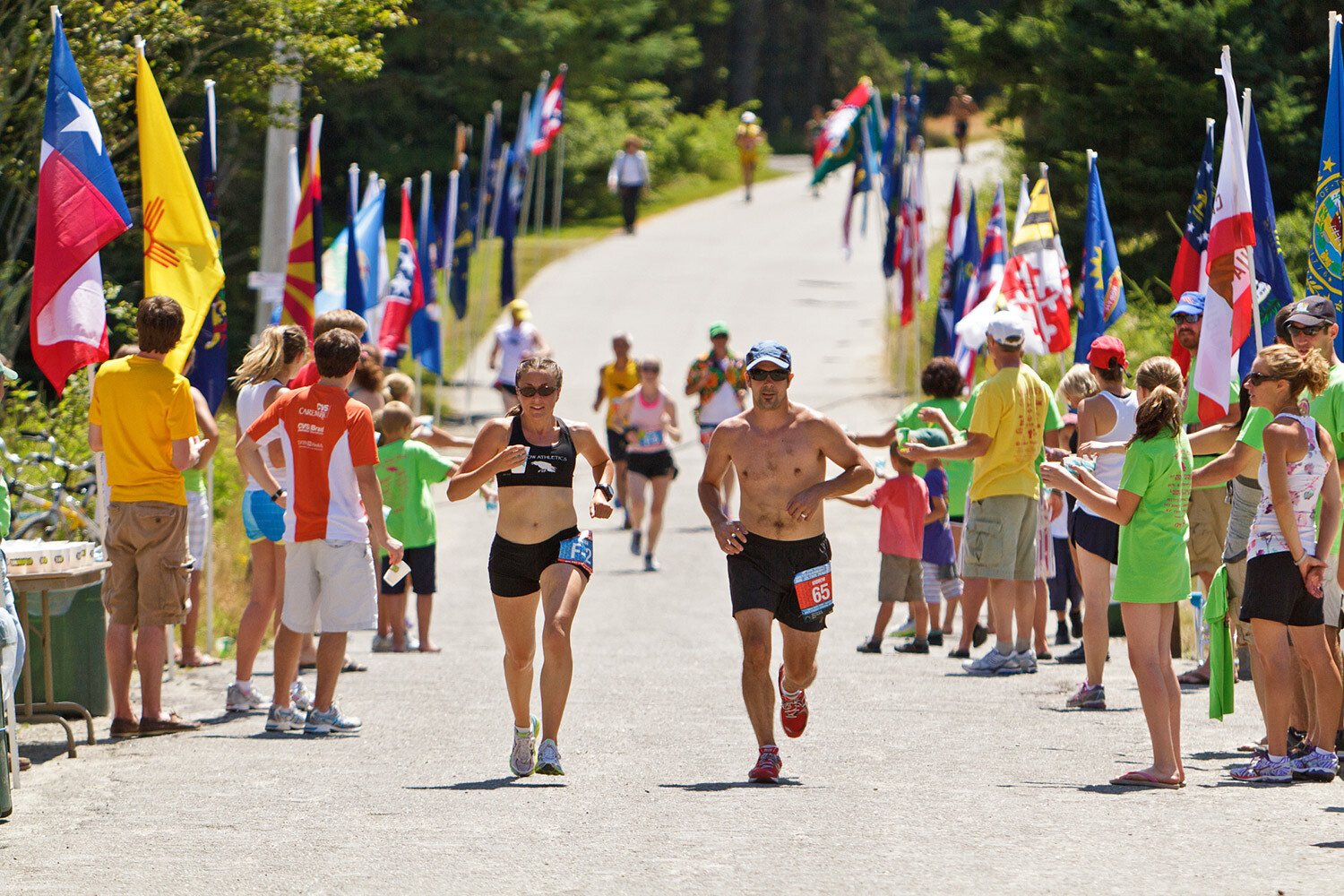
The three gender options (female, male and non-binary) will be offered to all participants registering for the Reykjavik Sport Association events. For the first time awards will be given for three categories in the running events.

“We are excited to welcome everybody in our events, regardless of gender, gender identity and gender characteristics. We welcome everybody to our running events,” says Hrefna Hlín Sveinbjörnsdóttir event manager.
by AIMS
Login to leave a comment
Islandsbanki Reykjavik Marathon
In 1983 two young entrepreneurs working at a travel agency were looking for an opportunity to interest more tourists in visiting Iceland when they came up with the idea of starting an international road race in Reykjavik. A year later the first run was held with 214 participants. These were natives and runners from seven other nations. Since then the...
more...Ultra running is exploding in popularity around the world, but what actually is an ultramarathon?
The term Ultra covers a broad range of races, from mountains to road
Ultra running is fast becoming a mainstream sport. Once, it was the realm of a few crazy runners, and not the pastime of everyone from your boss to your neighbour. But what actually is an ultramarathon?
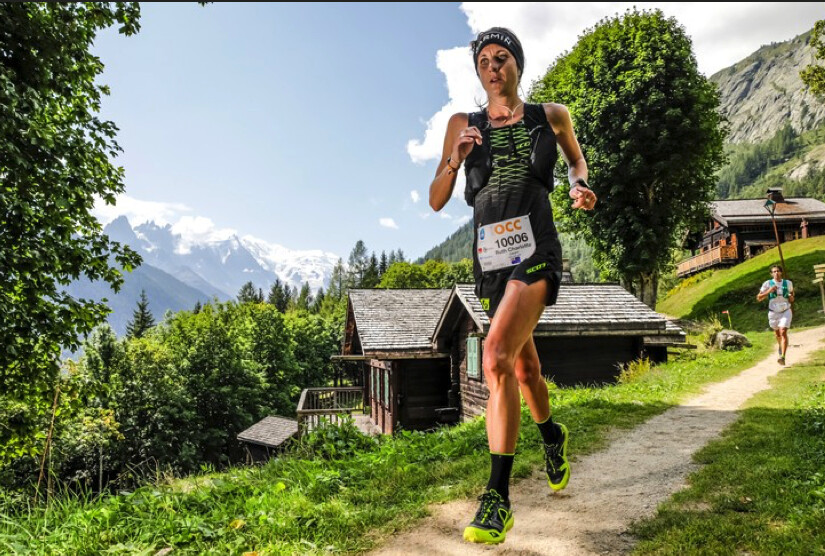
How long is an ultramarathon?
An ultramarathon is anything longer than a marathon, which is 26.2 miles (42.195km). So, you could complete a marathon and run back to your car and you’ve technically run an ultra distance.
Typically, ultramarathons start at 50km and go up from there. Standard distances are 50km, 100km and 161km (100 miles), the latter often being referred to as a “miler”.
While a marathon is never longer than 26.2 miles, ultras tend to vary a bit. For example, the Hong Kong 100 is in fact 103km. And the Ultra Marathon du Mont Blanc, a miler, is in fact 171km. Others are a bit shorter than advertised, too.
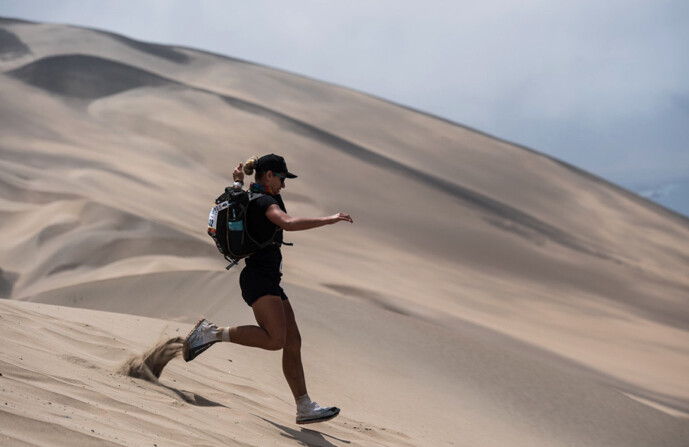
Aside from the above three types, there are ultra races of all sorts of distances and formats. As long as it’s more than a marathon, the distances and formats can be limitless.
An increasingly popular format is 250km split over stages, such as the Marathon Des Sables. Runners complete different distances each day, some less than an ultra, and sleep at night.
As the sport continues to grow, others try to push the boundaries – such as the 298km Hong Kong Four Trails Ultra Challenge, which is non-stop and has no support on the trails. Runners finish the distance in between around 48 and 70 hours.
The formats are becoming increasingly imaginative. A backyard ultra, for example, is around a 6.7km loop. The runners start on the hour every hour until there is just one runner left, so the distance is not set. It keeps going and going. Runners have gone on for more than 80 hours.
Outside organised events, runners often complete ultramarathons just for fun, to set a personal best or a Fastest Known Time (FKT), which is ultra terminology for a specific course record. This can be anything from the 44km Hong Kong Trail, which takes a few hours, to the 4,172km Pacific Crest Trail, which has an FKT of almost two months.
What terrain is an ultramarathon on?
With an infinite range of distances come infinite terrains. An ultramarathon can be road, flat, track, pavement, mountain, trail, snow and more. As long as you can run on it, you can run an ultramarathon on it.
A famous road ultramarathon is the 246km Spartathlon. It follows the legendary route run by Pheidippides, who ran from Athens to Sparta before the Battle of Marathon in Ancient Greece, thus inventing the marathon.
The most high-profile mountain ultra is the Ultra Marathon du Mont Blanc, which has a total of 10,040 metres accumulative elevation gain in the Alps.
Track ultras often take the format of a set time rather than distance. For example, how far you can travel in 24 hours, round and round the same athletics track.
When Zach Bitter set the 100-mile world record, which has since been broken again, he ran it around a 443m track by doing 363 laps.
The distances and terrains are so varied race to race they are essentially different sports. Kilian Jornet is considered one of the best ultra-mountain runners ever, but comparing him with Yiannis Kouros, considered one of the best ultra road runners ever, is like asking who is better at football: Tom Brady or Lionel Messi.
Is an ultra harder than a marathon?
The word ultra refers to the distance, not difficulty. An ultramarathon is inherently hard, but not inherently harder than a marathon or any other distance for that matter.
If you have a specific and demanding finishing time in mind for your marathon, you will have to stick to a specific split, keep your legs spinning and spinning, all the time concentrating on your pace and pushing your body.
Is that easier or harder than a 24-hour 100km over mountains, with variation in terrain and elevation, when you walk some parts and rest at check points?
What about a 5km? If you want to run a fast 5km, you will be at your absolute limit for the entire time and collapse over the finish line.
Non-runners often think an ultramarathon is the “next step” for runners looking for a new challenge. Searching for a faster time is just as challenging as searching for a longer distance.
Either can be harder than the other – it’s down to the runner.
The same is true within ultra running. Ruth Croft, one of the best runners, dominates races around 50km. She was repeatedly asked when she would do a 100 miler once she had “completed” a 50km. Croft resisted the urge to cave to the pressure to run further until she was ready, understanding that fast and far are two often incomparable metrics.
When you consider all of the above, the simple definition of “longer than a marathon” does not quite do justice to the massive range of events encapsulated by the term ultramarathon.
Login to leave a comment
Joseph Hale and Yanet Castro Aguilar won the men’s and women’s marathons, respectively
Most of Sunday’s runners at the BMW Dallas Marathon had been waiting two years to feel the euphoria of crossing the finish line in front of city hall.
Joseph Hale had three years of waiting under his belt after finishing fourth in 2018 and not running the race in 2019.
So when the Dallas resident crossed the finish line to win the 50th Dallas Marathon with a time of 2:28:42, he pumped his fist and let out a celebratory yell.
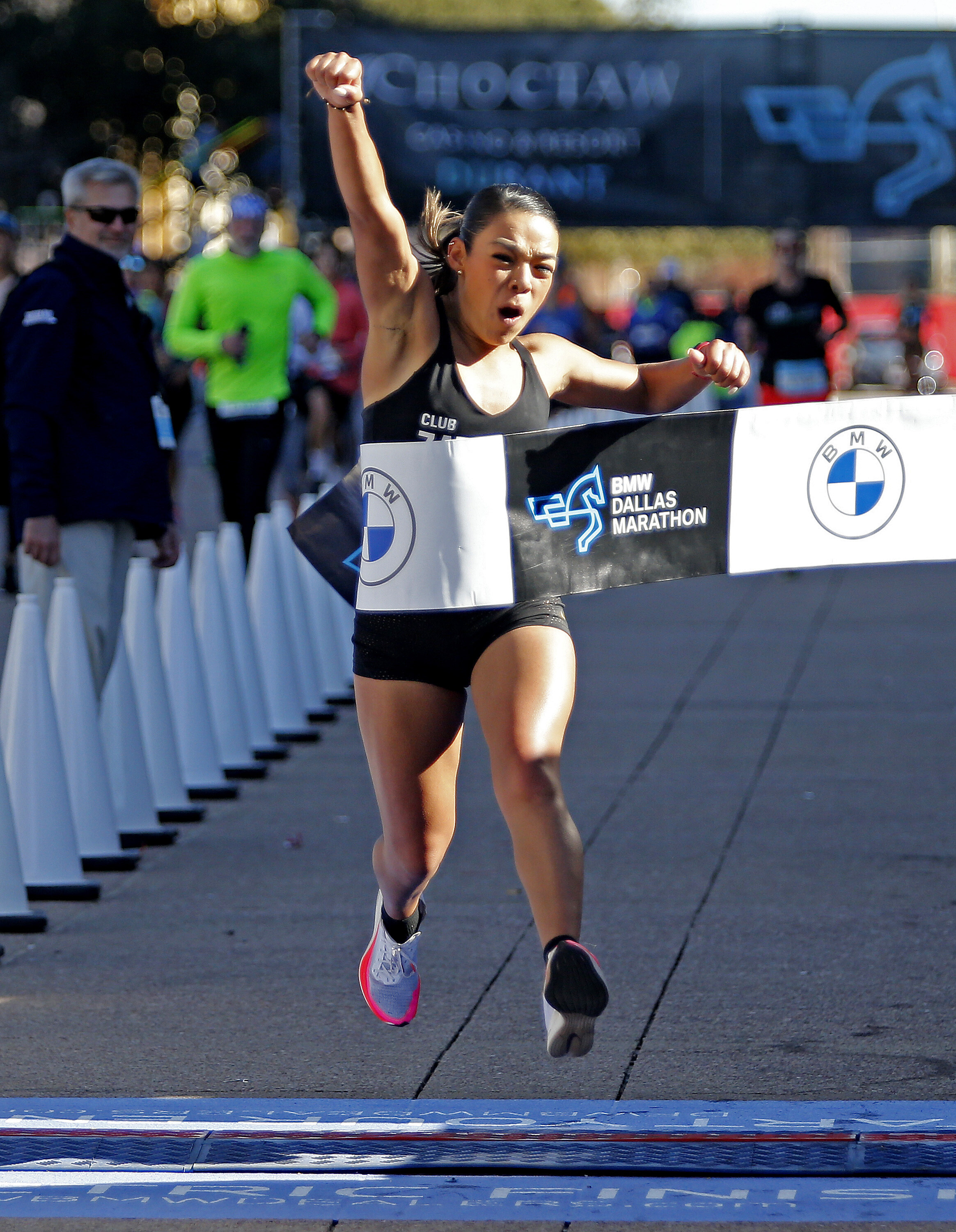
“It’s literally more than a life goal,” Hale said. “I don’t get emotional very often, but I’m going to get emotional about this.”
Joseph Hale crossing the finish line with a time of 2:28:42 to become the winner of the 50th Dallas Marathon.“I’ve literally dreamed of running that corridor for the last three years,” he said.
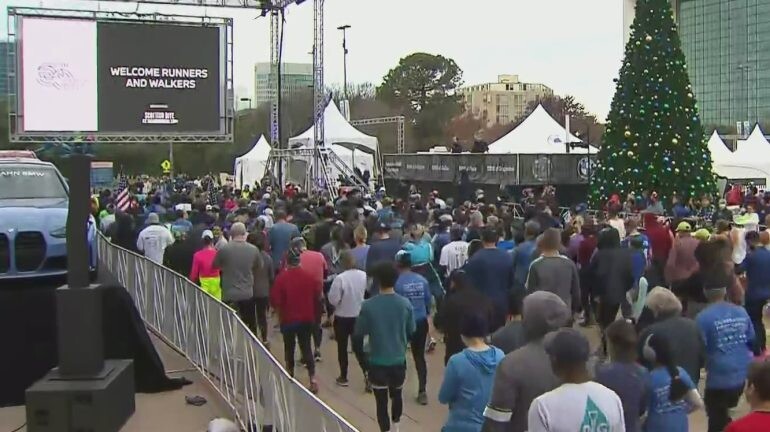
He just edged runner-up Joseph Darda of Fort Worth, who was about 20 to 30 seconds behind for the last 12 miles of the race. Darda crossed the finish line with a time of 2 hours, 29 minutes, 14 seconds.
Hale said having someone right behind pushed him to go harder but also forced him to be strategic.
This was the second straight weekend Hale finished a marathon.
He ran the California International Marathon the previous Sunday in Sacramento, Calif., finishing with a time of 2:26:44. He said he felt the mileage in his legs by the 10th or 11th mile.
“I wasn’t going for time; that’s what my race last week was about,” Hale said. “I actually don’t really know my time. I don’t really care. I won.”
More than 17,500 runners competed in Sunday’s races, and over 26,000 people competed over the entire weekend, which set a record.
The women’s winner was Solyenetzitl Selene Yanet Castro Aguilar of Zacatecas, Mexico, who finished with a time of 2:52:20.
She spent the first part of the race pacing with another competitor but, unbeknownst to her, the other runner was running the half marathon and soon split off in a different direction.
Castro Aguilar said she has been dealing with injuries over the past few years. She has spent the past three months training very hard for Sunday, and she took full advantage of the opportunity.
“I’ve been waiting three years to run this,” she said through a translator. “I was very happy and smiling all the way.”
It was the first marathon for Bradley. She ran at Baylor and was an NCAA cross country championship individual qualifier in 2017.
“This is kind of a full-circle moment because I went through some injuries that at the time I thought were career ending,” Bradley said. “To be able to run a marathon, it’s like all my dreams coming true.”
It was a banner year for first-time competitors. Both half marathon winners, Mitch Ammons and Kelsey Bruce, and women’s ultra marathon winner Megan Smyth were running at the event for the first time.
Bruce and Hale are best friends, meeting each other when they were both runners at Dallas Baptist from 2011-15.
They even ran the first few miles of Sunday’s race together before embarking on their own separate, winning journeys.
Bruce won the half marathon with a time of 1:14:35. She moved to Wichita Falls earlier this year after being hired as the head coach of Midwestern State’s cross country and track teams. Being able to come back to her hometown of 10 years and win the half marathon in front of her friends, family and coach was special.
“It’s always fun to hear your name on the course from people you love,” Bruce said.
So with her friend still on the road, Bruce stuck around after receiving her medal and award, joining the cheering brigade for Hale.
And as Hale entered the final length of his winning run, one voice stood out amid the crowd cheering him on.
“With 600 to go, she was there telling me that you got it,” Hale said. “She knows how I finish. She knows I can finish terribly. So when she said that I had it, I knew I had it.”
by Peter Warren
Login to leave a comment
BMW Dallas Marathon
The BMW Dallas Marathon is the result of the efforts of a pioneering group of brave Dallas runners, who had the foresight to establish an annual 26.2-mile race more than 40 years ago. In 1971, Tal Morrison – the official founding father of the marathon – placed a $25 ad in Runner’s World beckoning runners from around the country to...
more...After a two-year hiatus, Dallas Marathon is coming back, celebrating its 50 anniversary
The 50th anniversary of the Dallas Marathon was always going to be a special event.
But then the race was canceled last December for only the second time ever because of the pandemic. The makeup race in May suffered the same fate.
A pandemic-induced cancellation won’t happen a third time. And Paul Lambert, the president of runDallas, the organization that puts on the marathon, said the yearlong wait is going to make the marathon’s golden jubilee even more special.
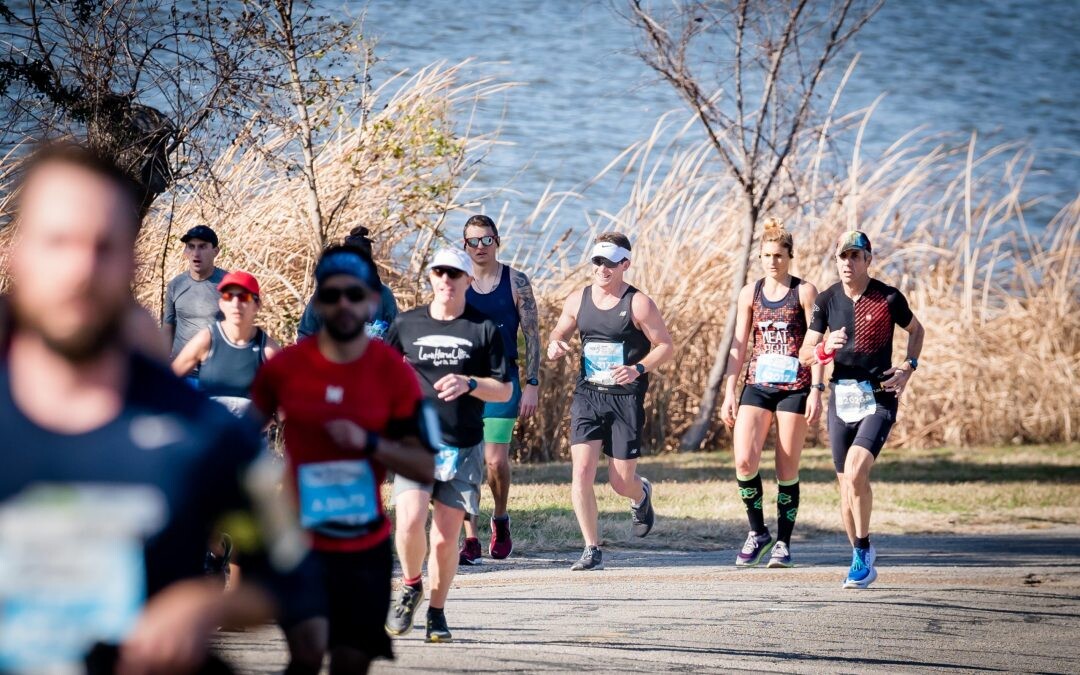
“We’re actually putting a video together and the theme song is ‘Back to Life,’” Lambert said. “If you would ask me how it feels, it’s a combination of truly back to life; not only for, hopefully, a lot of our runners and the feeling that they get out in these massive public community running events, but also for us as a management team.”
The BMW Dallas Marathon will take place next weekend with the 50th running of the marathon scheduled for next Sunday. Ten races will take place throughout the weekend, plus a Health and Fitness Expo at Kay Bailey Hutchison Convention Center on Friday and Saturday.
The first Dallas Marathon, then called the White Rock Marathon, was held on March 6, 1971. Far from the major weekend event it is now, the race had 82 participants and the course was only around White Rock Lake.
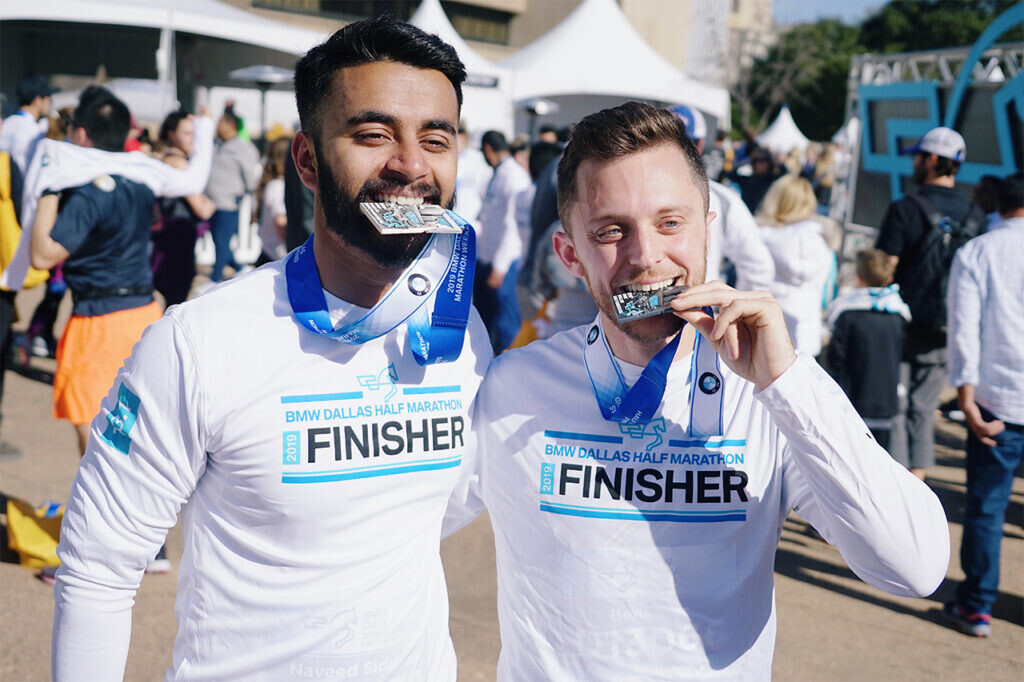
“The changes are really something else,” said Annabelle Corboy, the first female winner of the Dallas Marathon. “The changes in 50 years are incredible. ... There’s so many things that are different between now and then.”
Registration for the original 50th anniversary date opened in April 2020, and runDallas saw strong early participation numbers compared with other races across the country. Lambert said it was because the Dallas Marathon was “probably the first major race to come out with a defined contingency message.”
That plan was if the race couldn’t be held in person in December 2020, runners could either run a virtual race or push their registration back to a backup date in May 2021. And when the backup event was cancelled, the organization offered the same option to run virtually or push registrations to December.
The uncertainty that hung over the organization weighed on its small staff. Despite the contingency messages, it was difficult to do much planning for anything more than three months in advance. And without knowing when the next big race was coming, the team had to make sure it could maintain its financial viability.
But the extra time did give runDallas the opportunity to refine and fine-tune the event, as well as further grow and strengthen relationships with its partners. It has also resulted in extraordinary growth of runners.
Marcus Grunewald, the executive director of runDallas, said the weekend is reaching record participation.
“I think there’s a real pent-up demand to have a big event like this,” Grunewald said. “In fact, our numbers are a bit unusual for the industry as a whole.”
About 15,000 runners participated in the events included in the 2019 marathon. With about a week to go before the first race on Friday, over 23,0000 people have signed up to participate across the 10 different events. RunDallas expects that number to be about 25,000 by race weekend. More than 2,500 people have also signed up to volunteer.
Participation in the ultra marathon, a 50k race added to the program in 2018, sold out weeks ago. The marathon and half marathon are also approaching sellout status, and Grunewald believes they may sell out before race day.
“I think this will be a highlight of the last two years for almost everybody involved with the entire weekend,” Lambert said.
It will be for Logan Sherman, for whom the marathon is almost always a yearly highlight.
He first participated in the Dallas Marathon as part of a relay team in high school over 20 years ago. He has since won the half marathon three times and the 2015 marathon with a time of 2:27:28.
Sherman is now a current member of the runDallas board, and isn’t running any long races this year, instead focusing on volunteering at the event. He is hopeful the 50th anniversary is going to take the event to the next level.
“This is gonna be so much fun,” Sherman said. “I guarantee you there’s gonna be a lot of smiles and emotion that people are going to have at the finish line when they get back to City Hall. I don’t plan on leaving right after the start. I plan on staying up there and just watching the smiles and the emotions that come through.”
by Peter Warren
Login to leave a comment
Women´s 2018 flying Pig Marathon winner Caitlin Keen is the 2021 favorite
If all goes according to plan, the women's winner of the Cincinnati Flying Pig Marathon will celebrate with a cold beer and a burger at Zip's Cafe in Mount Lookout.
Sometime around 10:30 a.m. Sunday, after hurrying by the Halloween harriers, 29-year-old Caitlin Keen hopes to join the exclusive club of two-time winners of Porkoplis pride.
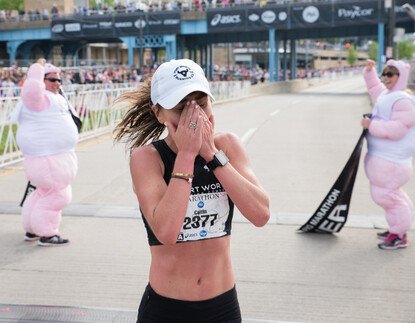
Keen, who spent her elementary school years in Hyde Park (St. Mary's), has been training in sweltering Fort Worth, Texas, and is looking forward to a Sunday morning start with a chill in the air.
She breezed to her first Flying Pig win in 2018, then was outkicked at the end of the 2019 race by Anne Flower to finish second the last time this race was run. Where most participants are happy to finish, Keen's eye is on the prize, even though her last marathon was in Feb. 2020 at the Olympic Trials.
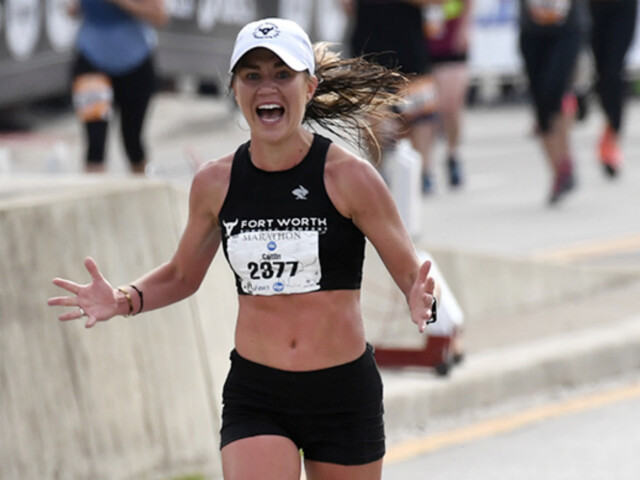
"I'm coming off of a lot of running without racing," Keen said. "I've been training all summer when it was hot. You're just dragging yourself through it, picking yourself up every day. I think it's probably going to be for my benefit. The weather looks pretty good."
In the previous 22 trots of 26.2 miles, there has only been a trio of female winners who have crossed "The Finish Swine" as champion twice. In the second and third years of the race, Becky Gallaher won in 2000 and 2001 back-to-back. Amy Robillard also went back-to-back in 2014 and 2015. Flower, the 2019 champ, is the most recent.
No autumn Flower
On a whim, Anne Flower put in a month's worth of training while working as an emergency room resident and won in 2016. The Anderson Township native, now a full-fledged doctor, repeated in 2019, which technically makes her defending champ since the coronavirus pandemic halted the "live" race in 2020.
Flower is skipping this year's Pig and running in a marathon in Indianapolis the following week. That leaves Keen, now a Fort Worth resident, as a heavy favorite.
Flower, who is hoping to get a PR on a fast course at Indy Nov. 6, is gravitating toward longer races having recently competed out west in events at Moab, Crested Butte and Pike's Peak.
"I've started running ultra marathons in the past few years and have had similar success," Flower said. "Marathon distance is starting to feel too short and fast for me to keep up!"
She plans on cheering this weekend and points toward Keen, whom she outdueled in 2019 as a runner to watch.
"Caitlin Keen is super fast!" Flower said. "Cincinnatus Elite and Columbus Running Company Elite also have very talented teams. Of course, there are always the 'not yet known' runners who could perform well and finish first."
by Scott Springer
Login to leave a comment
Cincinnati Flying Pig Marathon
This beloved race found it's name from Cincinnati's pork history which dates back to the early 1800's. Cincinnati is also known as "Porkopolis."Our weekend line up of events are designed to welcome athletes of all abilities from the Diaper Dash to the full Marathon and everything in-between, we truly have something for everyone. We even added a dog race several...
more...The world's best finish lines
Whether you are running your first or 50th race, there is no better feeling than crossing the finish line. We appreciate all finish lines in life no matter your goals, but we take a look at some of our favourite finish lines in races across the running world.
Boston Marathon (U.S.)
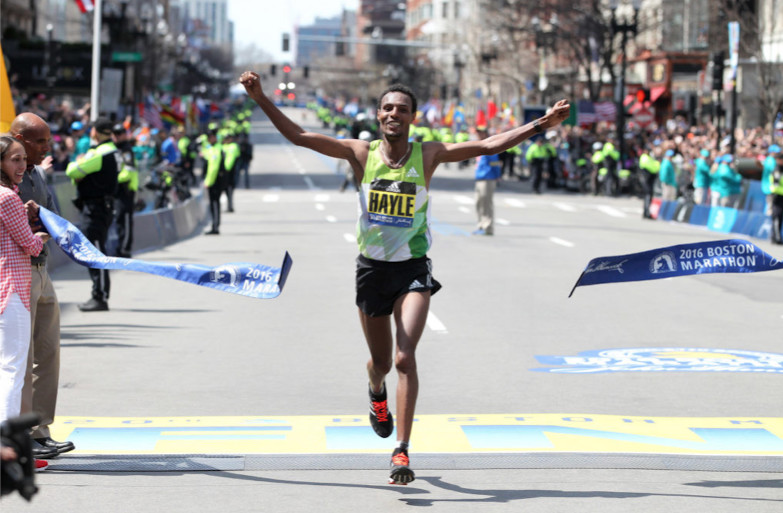
It would be hard to leave the finish line of the prestigious Boston Marathon off the list. Right on Hereford, left on Bolyston and you can see the finish line, with 500m to go. It’s a memory Boston marathoners remember forever. To hear fans, family members and Bostonians screaming at you as you run toward the line certainly gives you a final push to the finish.
Ultra de Trail Mont-Blanc (France)
This UTMB finish line sits right in the heart of Chamonix, surrounded by picturesque views of the French Alps. Ultrarunners descend from the mountain into the village after 171 km of racing, and hear the roar of the crowd as they run through narrow cobblestone streets toward the finish.
Olympic Marathon (Various)
The Olympic marathons always take place on the final two days of athletic events at the Games. Although fans were not allowed in the stadium in Tokyo, there were people lining the marathon course in Sapporo, which was one of the advantages of it being moved to that city. The raw emotion of athletes celebrating as they complete the Olympic marathon is a moment like no other.
Around the Bay 30 km (Canada)
Canada’s Around the Bay 30 km road race has a unique finish line, in which runners finish go through the lower level of a hockey arena to finish at centre ice of Hamilton’s FirstOntario Centre. Friends and families sit inside the arena to watch runners cross the line. Spectators will also sit inside to avoid the freezing temperatures of the March race.
Melbourne Marathon (Australia)
Similar to Canada’s Around the Bay race, the Melbourne Marathon finishes inside one of the world’s top 10 largest stadiums: the Melbourne Cricket Ground (MCG). The MCG has a seating capacity of 100,000 people and is home to the AFL Grand Final and Australia’s cricket team. Runners enter the MCG after completing 41 kilometres around the streets of Melbourne, to finish the marathon at midfield.
Great Wall Marathon (China)
The Great Wall of China Marathon starts and finishes inside the village of Huanyaguang’s Yin & Yang Square. Despite the steep climbs on the iconic Great Wall of China, runners are rewarded by the breathtaking views along the course. In the last two kilometres, as you reach the village from the wall, spectators will be cheering as they have a traditional festival for runners.
Comrades Ultra Marathon (South Africa)
The Comrades Marathon is a point-to-point 90 km ultramarathon in South Africa, starting at City Hall in Pietermaritzburg and finishing at the Sahara Kingsmead Cricket Stadium in Durban. Race spectators wait at the finish in Durban in front of a big screen, waiting for entrants to cross the line. The race has a challenging time limit, as runners must complete the distance in less than 12 hours.
Login to leave a comment
Kipchoge reveals his next goal after leaving marathons
Kipchoge has been recognised the world over as the epitome of limitless possibilities.
Marathon legend Eliud Kipchoge has revealed that he intends to push his body further than the 42km marathon which he has won over 10 times.
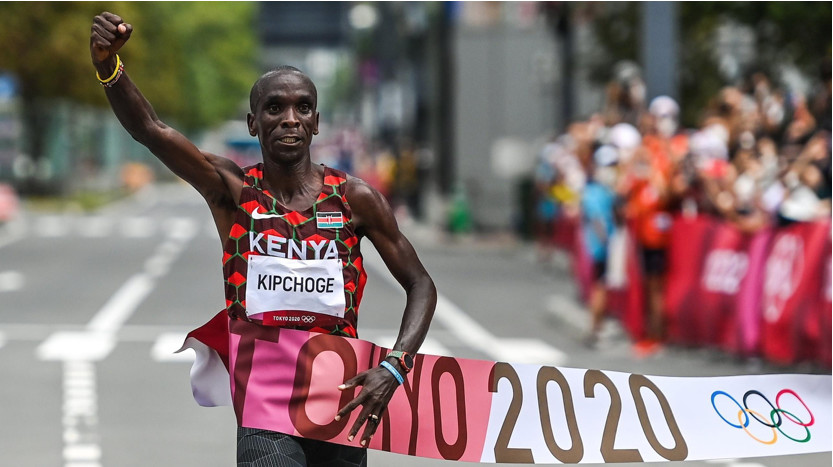
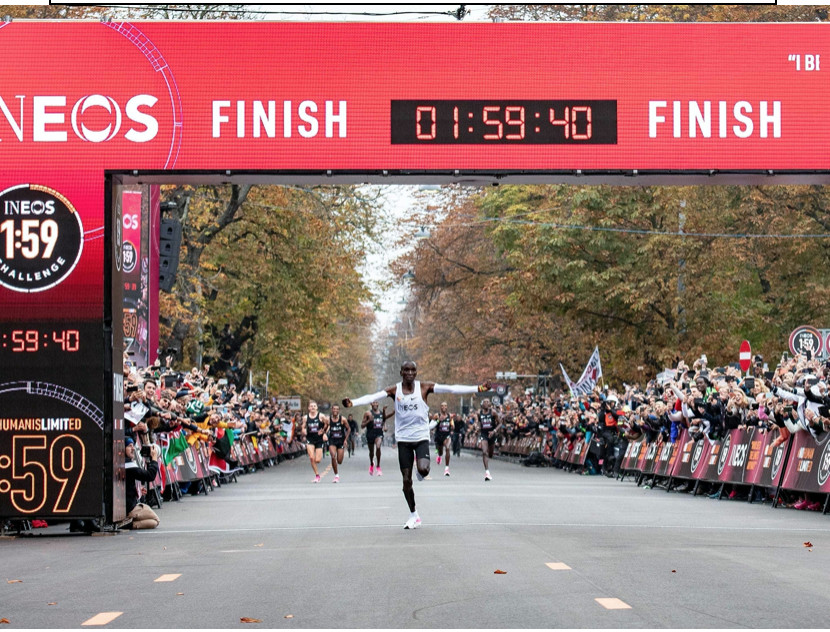
In a recent interview with author and athletic enthusiast Rob Steger, Kipchoge said his next goal after leaving marathons would be the ultra marathon.
"After leaving the marathon, I want to run the ultramarathons just to feel how it is. Running for more than 4 or 5 days or even run at once for 70 kilometres. I really want to feel the pain of running for a long time,” Kipchoge said.
The 36-year-old has been recognised the world over as the epitome of limitless possibilities, having beat the sub-2-hour mark in 2019.
Kipchoge’s timing of 1:59:40 isn’t officially recognised as a world record as the conditions—a straight and even track, a battery of world-class pace-setters and special shoes, among others—were carefully chosen to propel him towards it.
But it takes nothing away from a feat that transcends the realm of mere statistics and accomplishes what was once considered invincible.
He recently asked Kenya to embrace the use of technology in training to keep performing wonders at international competitions.
“If we don’t embrace technology then we are not moving... I know regulations will be there but technology should take centre stage.
“Let all athletes have top technology, have top innovation. That’s the only way to think and actually try to improve your performance,” Kipchoge told Reuters.
His incredible form was now been turned into a movie called Kipchoge: The Last Milestone.
The film portrays Kipchoge as a tireless athlete with a work ethic, a contemplative attitude and a fundamental modesty.
The legend uses hypoxic training which helps his body adapt to reduced oxygen intake to prevent him from running out of breath.
His muscles have high capability to self-contract to enhance the smooth movement of his limbs
An excerpt from his training manual reads that in 2018, he completed an entire session in under 80 minutes with no time between warm-up, workout, and cool-down. Later the same day he ran 12km in less than 50 minutes.
Login to leave a comment
2021 longford marathon goes virtual
Despite the best efforts of all involved with the organisation of the Abbott Longford Marathon, unfortunately it is not possible to go ahead with the in-person event in Longford this year due to the ongoing Covid-19 pandemic.
As a result, the committee has made the decision to go virtual.
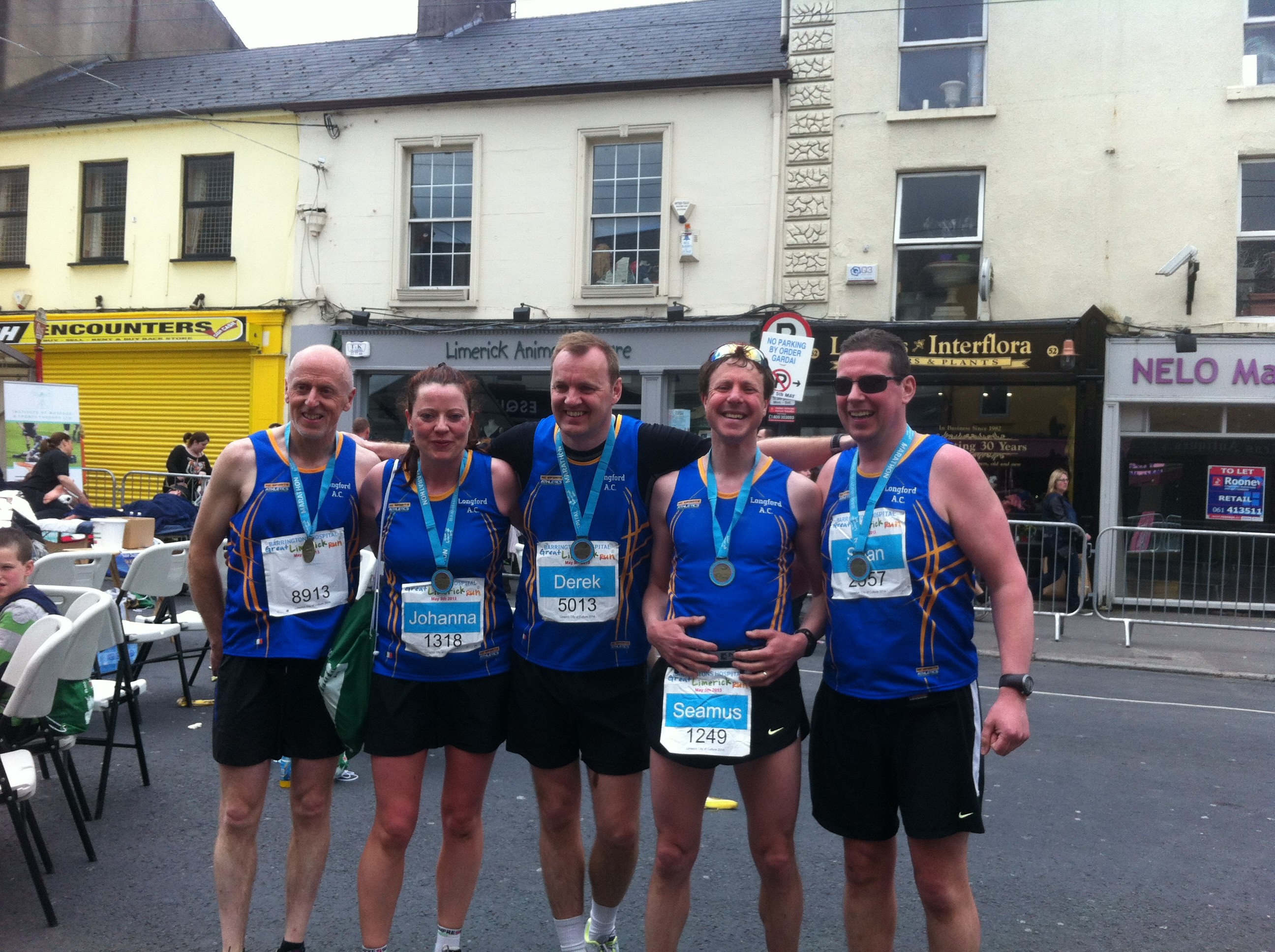
The 2021 Virtual Abbott Longford Marathon will take place between Sunday, August 29 and Thursday, September 30. Participants can take part in a 5K, 10K, Half Marathon, Marathon or 39.3-mile Ultra Marathon and complete the distance at a time and location of their choosing between those dates.
Registration for the 2021 Virtual Abbott Longford Marathon is now open at: http://www.longfordmarathon.com/enter/
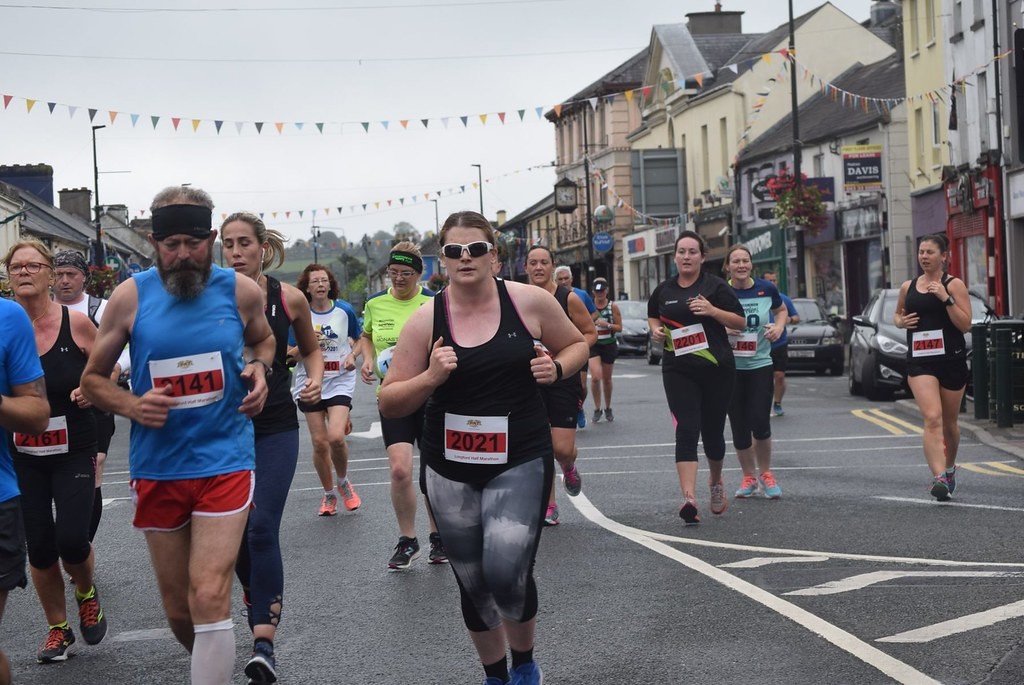
2021 Finishers Medal
Entry in any distance will cost €15, and all runners will receive a specially commissioned 2021 finishers medal by post.Announcing the virtual race, John Sheehan, vice-chairman of the organising committee said,
"While we are of course disappointed not to be able to go ahead with our event again this year, we are delighted that with the support of our main sponsors Abbott, we can bring our event to the virtual world, and I encourage everyone to get involved and take part over the month of September."
Mr Sheehan outlined that the virtual event will help to raise vital funds for charity partners, St Christopher's Services in Longford, at a time when funding for their services is most needed.
He concluded, “We look forward to 2022 with hope and optimism and are planning for the Abbott Longford Marathon at the end of August.
“We hope to see you all soon. In the meantime, keep safe, keep running and enjoy the 2021 Virtual Abbott Longford Marathon.”
Login to leave a comment
Longford Marathon
The Friendly Marathon in the Heart Of Ireland. Ireland's friendliest marathon has a reputation for being one of Irelands best organised events, with a flat course, through the beautiful countryside of Longford, Roscommon and Leitrim beside the River Shannon. Take a place,its an ideal run for anybody training for the Dublin City Marathon in October. Organised by runners, for...
more...China will file criminal charges against 27 officials after deadly ultra marathon
China reported on Friday that it will file criminal charges and take disciplinary measures against 27 leaders and public officials who were found responsible for a disaster in a recent marathon, in which 21 runners died after an abrupt change in weather conditions.
After revealing the findings of an investigation, authorities in the northwestern province of Gansu mentioned, among the officials sanctioned, some leaders of the Communist Party and the administration of the county and city where the tragedy took place on May 22.
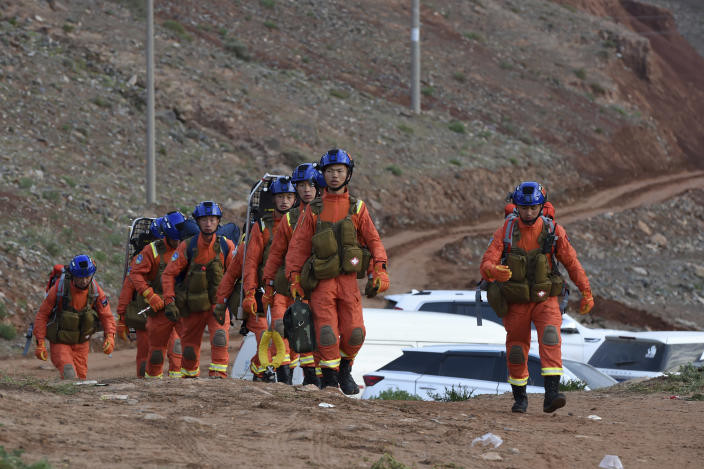
They emphasized that the incident occurred as a result of poor quality and unprofessional management.
The Gansu Government opened an investigation into the incident, as the marathon covered 100 kilometers and some parts of the route recorded temperatures close to zero degrees.
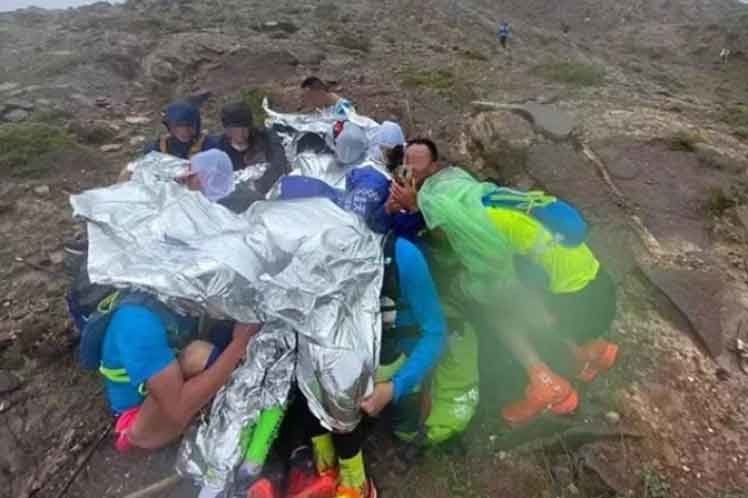
The mountain race was taking place in a forest in Baiyin County with 172 participants, but a spate of hail, freezing rain and gale force winds suddenly lashed a 20-30 kilometer section of the event, which included a high-altitude stage.
Organizers stopped the marathon when they found that many runners suffered physical discomfort and loss of body heat due to low temperatures, while some went astray. However, 21 died, including Asian champion Liang Jing and Paralympic star Huang Guanjun.
As a result of the incident, China suspended other similar competitions until it checked its safety mechanisms, as it detected flaws in their organization and logistics to respond to emergencies.
by Prensa Latina
Login to leave a comment
Des Linden smashes the world record for 50k in her first ultra marathon
Des Linden’s elite marathon career has included two Olympic Games and a Boston Marathon win.
Tuesday morning, running on the Row River Road bike path along the northern bank of Dorena Lake near Cottage Grove, Oregon Linden became a world record holder.
In her first ultramarathon attempt, the 37-year-old from Michigan ran the 50K course in 2 hours, 59 minutes, 54 seconds to shatter the previous women’s record of 3:07:20 held by Great Britain’s Aly Dixon since Sept. 1, 2019.

“I thought it would take a disaster for it to not happen, but you get to the marathon distance and disasters are pretty common,” Linden said. “Then you extend that and you just don’t know. As confident as I was, it’s unknown territory. I was trying to respect it as much as possible.”
Linden averaged 5:47 per mile. She hit the 26.2-mile marathon mark in 2:31:13 and powered through the final five miles with the help of American men’s marathoner Charlie Lawrence, who paced Linden through the entire 50K.
“We held it together, but it got hard the last five but I knew we had that time locked away,” said Linden, who couldn’t see the clock at the finish line. “But I knew. We were crunching the numbers out there. I’m like ‘I gotta break 3 (hours) or else I’m going to have to do this again, like soon.’”
Linden said she’d been planning for this race for a couple of years and felt like the time was right to give it shot.

“The spring is totally free,” Linden said. “Without the major marathons it was like, let’s figure it out. And I think a small operation is a little bit better for trying to test the waters anyways, and with COVID, that’s how it has to be. We just tried to quietly do something and see how I liked the distance and how I measure up and if it’s something I want to pursue moving forward.”
The Row River Road course has been the site of several under-the-radar races the past year, including attempts by former Oregon stars Galen Rupp and Jordan Hasay to break U.S. half-marathon records. Neither were able to do what Linden did Tuesday.
“This is definitely one of the highlights of my running career thus far,” Lawrence said. “Being able to help a friend and probably my biggest mentor in the sport achieve a goal of hers and get a world record, is awesome.”
Linden finished seventh at the 2016 Summer Games in Rio de Janeiro and two years later won the Boston Marathon.
She finished fourth at the U.S. Olympic Marathon Trials in Atlanta in early 2020 before the pandemic shut everything down. She remains the alternate for the Tokyo Olympics this summer behind the three American qualifiers — Aliphine Tuliamuk, Molly Seidel and Eugene’s Sally Kipyego.
by Chris Hansen
Login to leave a comment
The art and allure of 24-hour track racing
Author Michael Stocks gives his perspective on what it’s like to tackle the challenge of running for an entire day PLUS win a copy of his new book One-track Mind
Most us have experienced the feeling of standing on the start line of a track race, consumed by the mixture of tension, trepidation and anticipation of what lies ahead.
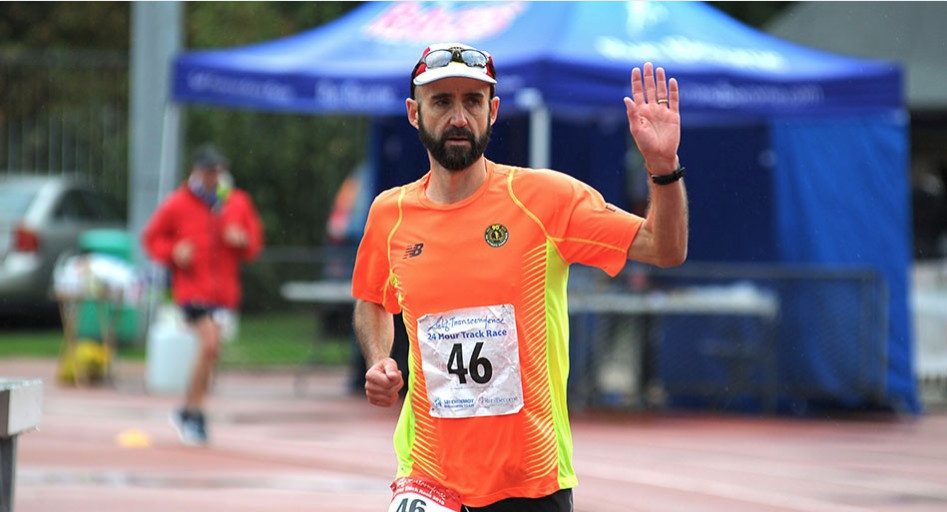
Not so many of us, however, will have stood on that start line knowing that the finish line is a full 24 hours away. Michael Stocks is one of those people and his new book One-track Mind: What Running 150 Miles in a Day Can Teach You About Life is a beautifully written account of everything involved in a challenge which test the limits of physical and mental endurance.
The race about which he writes is the 2018 edition of Self Transendence 24 hour, which takes place annually on the track in Tooting Bec, South London.
Rather than it being a case first past the post, when the hooter sounds after 24 hours victory goes to the person who has covered the greatest distance.
A place on the Great Britain team for the 24 hour World Championships was part of the incentive and Stocks manages to take the reader on just about every step of the incredible journey which unfolded along that 400m lap.
He will be back in action later this month at the Centurion Track 100 race in Ashford, with designs on breaking the V50 100-mile world record of 13:27:27 which is currently held by Russian Oleg Kharitonov.
So what is it that draws him to this particular strand of endurance running?
“In a way it suits my character and plays to one of my strengths which is that when I’m running I don’t really mind where I am – the act of running is the thing, if it’s a race,” says the man who has competed for both Great Britain and England.
“I do love going to beautiful places and running – and then I’m aware of my surroundings – but if I’m racing then really I don’t much mind where I am because it’s about the race and the running and the movements.
“I can honestly say that the fact that I was in the same place, running around and around wasn’t a big thing for me, though I did prepare mentally for that, which I think is really important.”
Stocks admits to being daunted ahead of the race getting underway but, as many long distance runners will attest, breaking the task at hand down into manageable chunks is as important as it is mentally helpful. 24-hour track racing is no different.
“I broke it down into half hours,” he says. “We know we need to drink every half hour, to eat every half hour and that really was my horizon. I just tried to stay in it and not think longer than half an hour.
“But then you’ve also got the change in direction every four hours, which was really important. I was also ticking off every 10k early on, so you kind of find those little goalposts, or goals and then I think the key when you when you get to them is not to think ‘okay I’ve done one hour but I’ve got 23 to go’ but rather to think ‘I’ve got one hour’ and to put that hour behind you.
“I almost had the sense of physically picking something up and placing it behind me and going ‘wow that’s great, I’ve collected that hour’.
“Yes it was daunting, but I really worked hard on staying in the present and thinking about what I’d done rather than about what was to come. It wasn’t successful all the time but on the start line I was confident that I had prepared well enough to get through it.”
One key challenge to overcome during a 24-hour race is, of course, running through the night. Stocks had never done it before and the experience was one of the most memorable and enduring points of the event.
“When I got through the night and the light came I suddenly realised how special the night had been,” he says. “I was really struggling a lot for a lot of it, and obviously you are late in the race, but there was this complete quiet and a sense of nothing outside. It creates this very unusual environment.
“I went through some of my worst stages and bad patches in the night but when I got to the end of those I remembered how the light looked brighter on the track because there was a wet sheen and you’ve got these massive spotlights, but you’ve got hardly anyone on the track because half of the runners had left by then.
“It was an almost surreal environment and I wanted to cling on to part of that quiet because it was such an unusual and special experience and I also had never run through the night.
“It would have been special in the mountains, too, but there was something about the track and the colours and the sense of quiet that just made it quite, quite special.”
Another special aspect of ultra marathon running, Stocks insists, is the community which surrounds it. From the athletes, to the support crews who literally keep their runners fed, watered and clothed, to the race organisers, the nature of the events create a unique sense of camaraderie.
“One of the things I really wanted to get across in the book is this excellent sense of community,” says the London Heathside runner. “When I left that track and the race it was almost heart wrenching because I felt there was such a sense of presence and positivity and community around the track.
“Everything from the organisers and the whole ethos of their races to the other crews who were supporting all the runners, not just their own runner.
“Paul [Maskell], who I was racing for the victory, we were just increasingly helping each other and encouraging each other and it’s really, really incredible.
“I think it’s probably the adversity that keeps you humble. There are just so many amazing people doing the sport.”
by Athletics Weekly
Login to leave a comment
Ultrarunner Tom Evans prepares for his biggest race at Olympic marathon trials
Like many, ultrarunner Tom Evans has struggled with the lack of races in lockdown. The former army captain burst onto the ultrarunning scene in 2017, coming third in the six-day Marathon des Sables, and last year he set a new record in the Tarawera 102km Ultra Marathon, in New Zealand. But he has had to adapt to circumstances and is now setting his sights on the marathon in the rescheduled Tokyo Olympics.
We talked to the 29-year-old about swapping the trails for the pavements, his mental strength, the Olympic marathon trials and his role as a Garmin ambassador.
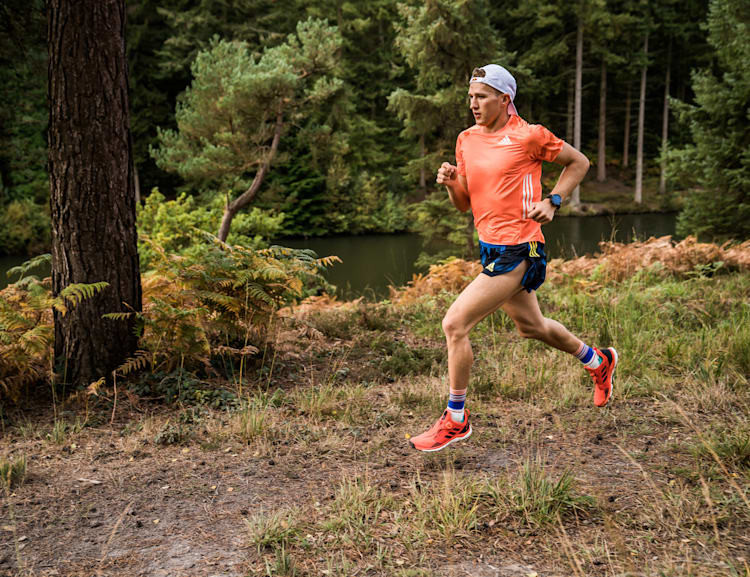
You’ve set your sights on the Tokyo Games. How did this happen?
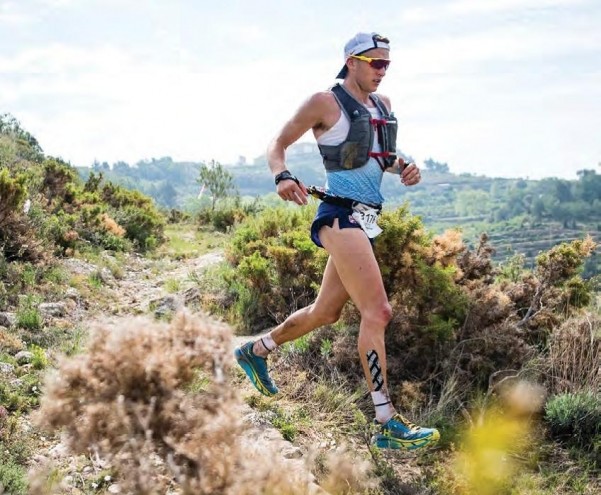
‘At the beginning of the pandemic, Tokyo was not on my list whatsoever – I very much planned on staying on the trails and running long rather than running fast. I guess what the pandemic has taught me is that I like structure and I’m a very goal-orientated athlete and person. I have to have goals, whether it’s “Today I’m going to list 10 things on eBay” or something bigger; I have to set goals and achieve those goals. It’s the same with my running, with there being so little opportunity to race, I thought I need something to set my sights on and if something is going to happen, it’s going to be the Olympics.
‘[With the lockdown restrictions] we couldn’t drive to run or go on training camps, which is how I would normally do my trail running and my ultrarunning. It’s all been very much running from the door, so I’ve been running a lot more on the road, which has led to running a bit quicker and that’s opened my eyes to what I could run at the marathon trials at the end of next month.’ [The event will take place on a looped course in Kew Gardens, London, on Friday, March 26.]
How do you feel about the trials?
‘I’m really excited – for me, it’s really unknown. I think I’ll be able to take a lot of lessons I’ve learnt from ultrarunning into the race and I’m really looking forward to the challenge. It’s been great fun training for it and to now get the opportunity to push myself to the limits and see what I’m capable of.’
‘You know that during a marathon you’re going to hurt and you know that when it starts to hurt, the training that you have done before is what’s setting you up to keep doing it. I go into a race saying, “I know this is going to hurt” and when it starts hurting I think, “Bring it on; I’ve done the training, I trust myself and I knew this was going to happen and now it’s happening, it’s no surprise.”’
by Jane McGuire
Login to leave a comment
Tokyo 2020 Olympic Games
Fifty-six years after having organized the Olympic Games, the Japanese capital will be hosting a Summer edition for the second time, originally scheduled from July 24 to August 9, 2020, the games were postponed due to coronavirus outbreak, the postponed Tokyo Olympics will be held from July 23 to August 8 in 2021, according to the International Olympic Committee decision. ...
more...73-year-old Kmoin Wahlang is one of India’s oldest woman marathon runner
A mother of 12, a grandmother to almost 30 kids, Kmoin Wahlang is one of India’s oldest woman marathon runner.
Hailing from the north-eastern state of Meghalaya, Wahlang grabbed the eye-balls of sports fans and fitness enthusiasts when she made her presence felt during the Tata Mumbai Marathon in January 2019.

While many of us continue to blatantly state our age as an excuse when we fail to execute any strenuous physical activity, Wahlang successfully finished a marathon run at the age of 71 years!
She completed the 42.195km run with a timing of 4 hours 33 minutes and 55 seconds. If the age and the timings didn’t impress you, then note that Wahlang finished the marathon at 89th position out of total 520 women runners during that edition of the Tata Mumbai Marathon.
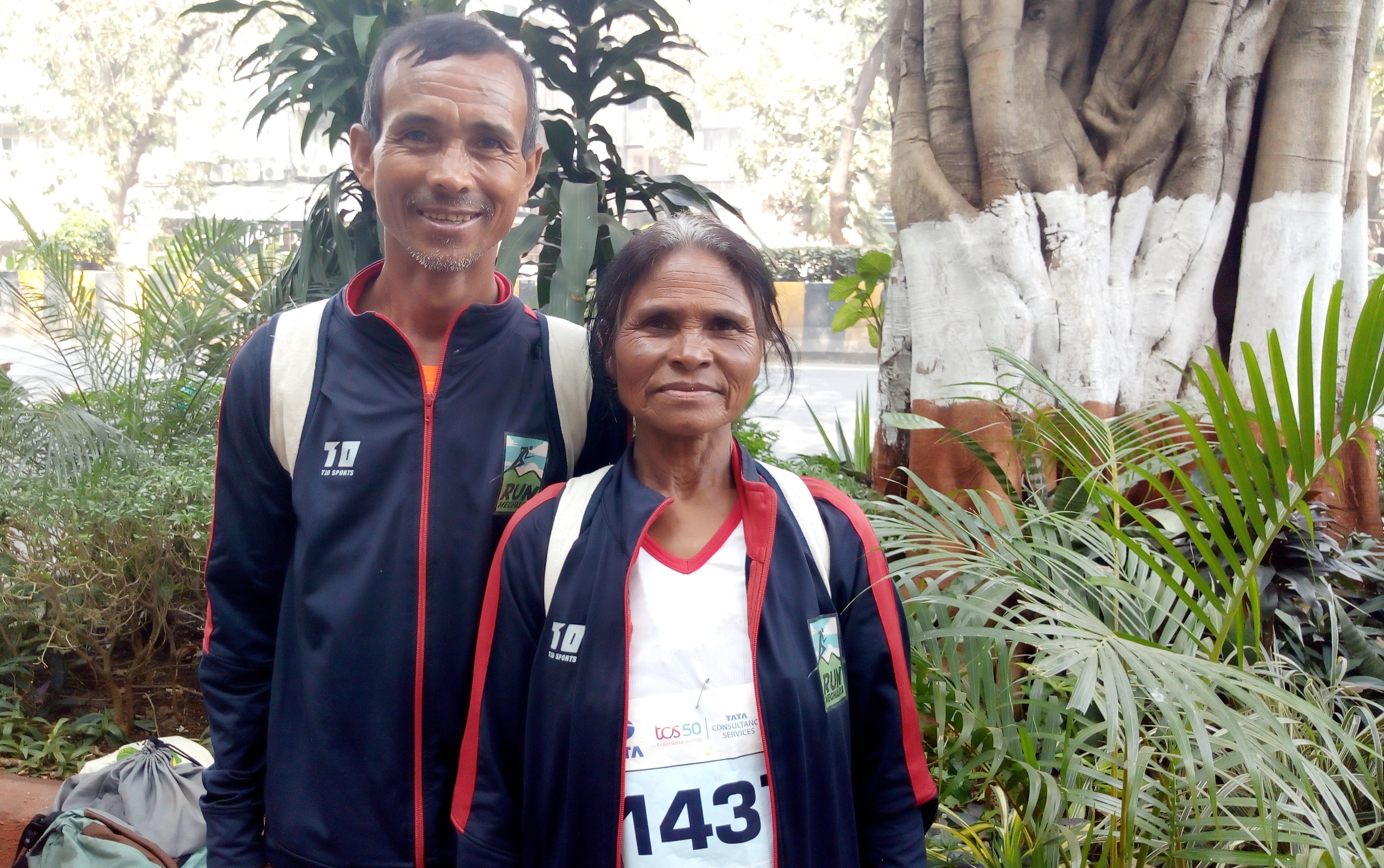
Though she can only converse in her mother tongue, Wahlang didn’t show any discomfort while running the Mumbai Marathon which incidentally was her first marathon outside the city of Shillong. Instead, she showcased extraordinary consistency during the entire course of the race and rarely dropped below the speed of 9km per hour.
Surprisingly, Wahlang’s running career can be traced back to almost two decades. The now 73 year old faced severe stomach issues after the birth of her twelfth child way back in 2001. She started walking extensively to counter this health issue and slowly this walking made way for running.
Wahlang was first discovered by a non-profit organisation called RUN Meghalaya and has since been participating in various marathons in her home state. She had even completed the 45km run in the Mawkyrwat Ultra Marathon before coming down to Mumbai for the Tata Marathon.
by Abhijit Nair
Login to leave a comment
Boxing legend Jeffrey LeMair is now running ultra marathons
The steady beat of a footstep, after footstep. It’s a calming and comfortable sound to Jeffrey LeMair.He runs for fun. Jeffrey has more than 30 marathons under his belt, including the Boston Marathon.
“When I’m having a bad day, some people go out and say ahh I resolve all my problems by running, it’s not that easy, but what happens is you get so relaxed that you’re in a non-emotional state to be able to deal with your issues,” said LeMair.
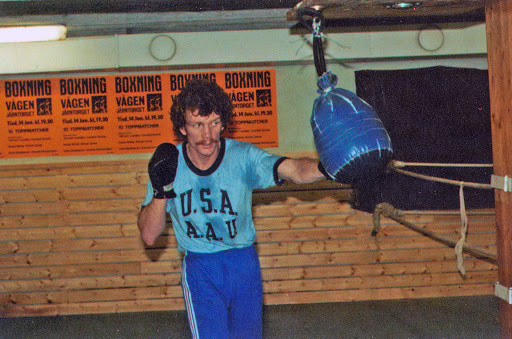
And for Jeffrey, a regular 26 mile marathon isn’t enough. He now runs Ultra Marathons of 50 to a hundred miles.
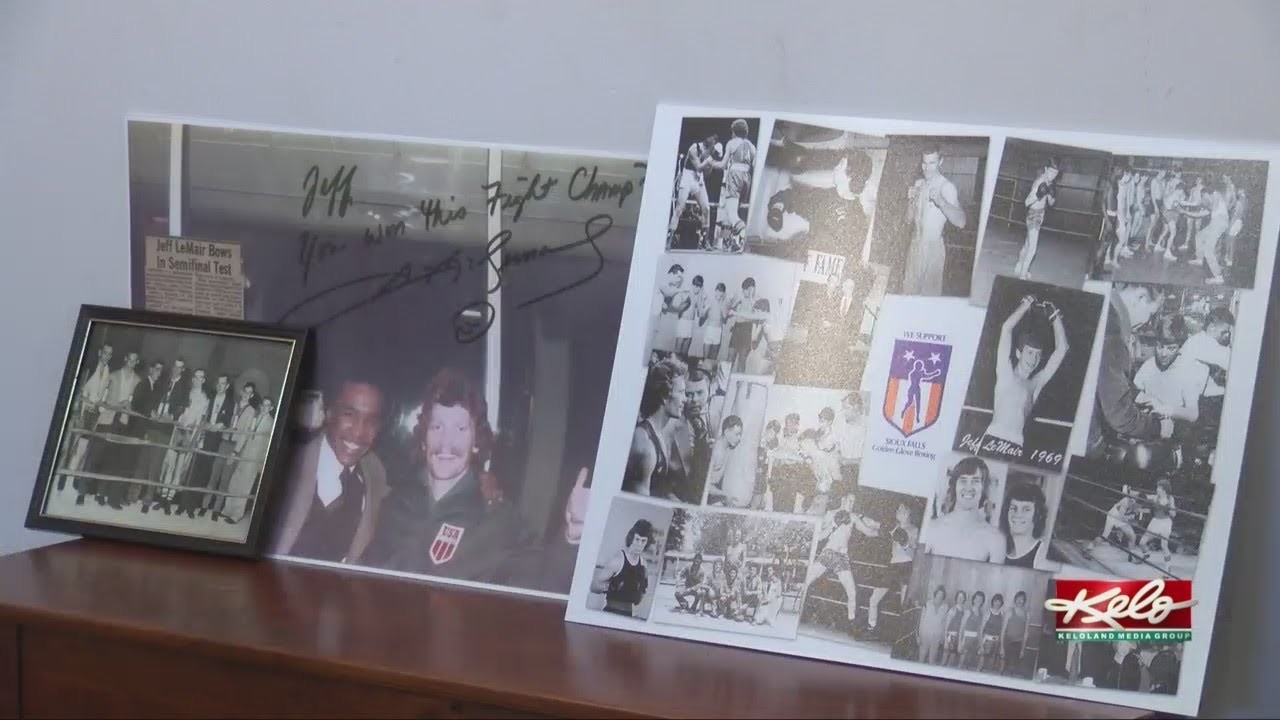
“It’s more of an adventure for me, so I want to extend the adventure, I also want the peace and fulfillment,” said LeMair.
During his 66 years, Jeffrey has run into his share of obstacles. The biggest came in the most unlikely place. The White House. You see Jeffrey wasn’t always a runner. Pound for pound Jeffrey LeMair is probably the best boxer to come out of the state of South Dakota.
Jeffrey won amateur championships, traveled the world and met stars. His brother Greg was his trainer and coach.
“Everybody that knows Jeffrey knows he was a pretty good boxer, but I don’t think people fully understand how good he was, said his brother Greg LeMair.
With Greg in his corner, Jeffrey fought, virtually to a draw, three boxers who went on to become world champions. One of them was Sugar Ray Leonard, who Jeffrey fought in Denver.
“It was a really really beautiful boxing match, really close but in the third round, Jeffrey decked Sugar Ray Leonard, the first time and one of the few times Sugar Ray Leonard was ever off his feet,” said Greg LeMair.
Leonard went on to become an Olympic gold medalist in 1976. At the next Olympics, it was to be Jeffrey’s turn. And that’s how he ended up at the White House on March 21st, 1980. On that rainy day, LeMair, and other top athletes in their sports were called to a meeting with President Jimmy Carter. One of LeMair’s fellow boxers spoke up but the president had made up his mind.
“He said young man, we’re not going, and that was it,” said LeMair.
Boxing will always be a part of his life, the muscles may be a little stiffer, the movement a fraction slower, but you still would not want to be on the receiving end of one of these punches. At times in his life, Jeffrey has been a contender, a challenger and in the eyes of those who know him best, a champion
“As good a fighter as good a boxer as Jeffrey was, he’s as good a human being,” said Greg LeMair.
In more than 200 fights Jeffrey says he was never knocked out and he credits his brother Greg for much of his success. Lemair, who turns 67 in February is preparing for another 100 mile race in 2021.
By the way, his grandkids call him “Grandpa Boom Boom.”
by Tom Hanson
Login to leave a comment
Run Rabbit Run canceled due to COVID-19
STEAMBOAT SPRINGS — Run Rabbit Run, the ultra running race known around the nation, has been canceled, according to a release from race directors.
“While you’re running, you’re socially distanced, but there’s a lot of other factors involved from bringing people from all over, aid stations, volunteers, the community,” said race co-founder Paul Sachs. “Ultimately, it was not the safe or right thing to do this year. We’ll be back next year.”

The announcement explained that directors put together a strict mitigation plan for racing but ultimately couldn’t get a team of medical providers to commit.
All 2020 registrants have been bumped to 2021, which might cause some longterm backup for those on the waiting list. Run Rabbit Run and other ultra races are popular and already have long lists of people hoping to run. With the way permitting works, Run Rabbit Run can’t accommodate any more runners.
“We deferred everybody to next year, so we’re full already,” Sachs said. “I expect some people will drop out, but the reality is there won’t be many open slots.”
A similar situation is occurring in Silverton.
The Hard Rock 100, another famous Colorado ultra marathon, was canceled due to COVID-19. This is the second consecutive year the Hard Rock 100 will not happen, as it was canceled due to snow last summer.
Login to leave a comment
The Comrades Marathon will be offering a virtual alternative
All is not lost for disappointed long distance runners who qualified for the recent cancelled Comrades Marathon.
The Comrades Marathon Association has announced the launch of a virtual event, ‘Race the Comrades Legends’, which will see all finishers receiving a medal.
The world’s greatest ultra marathon will now also stage the world’s biggest virtual event, with athletes from around the globe invited to participate on Sunday, 14 June.
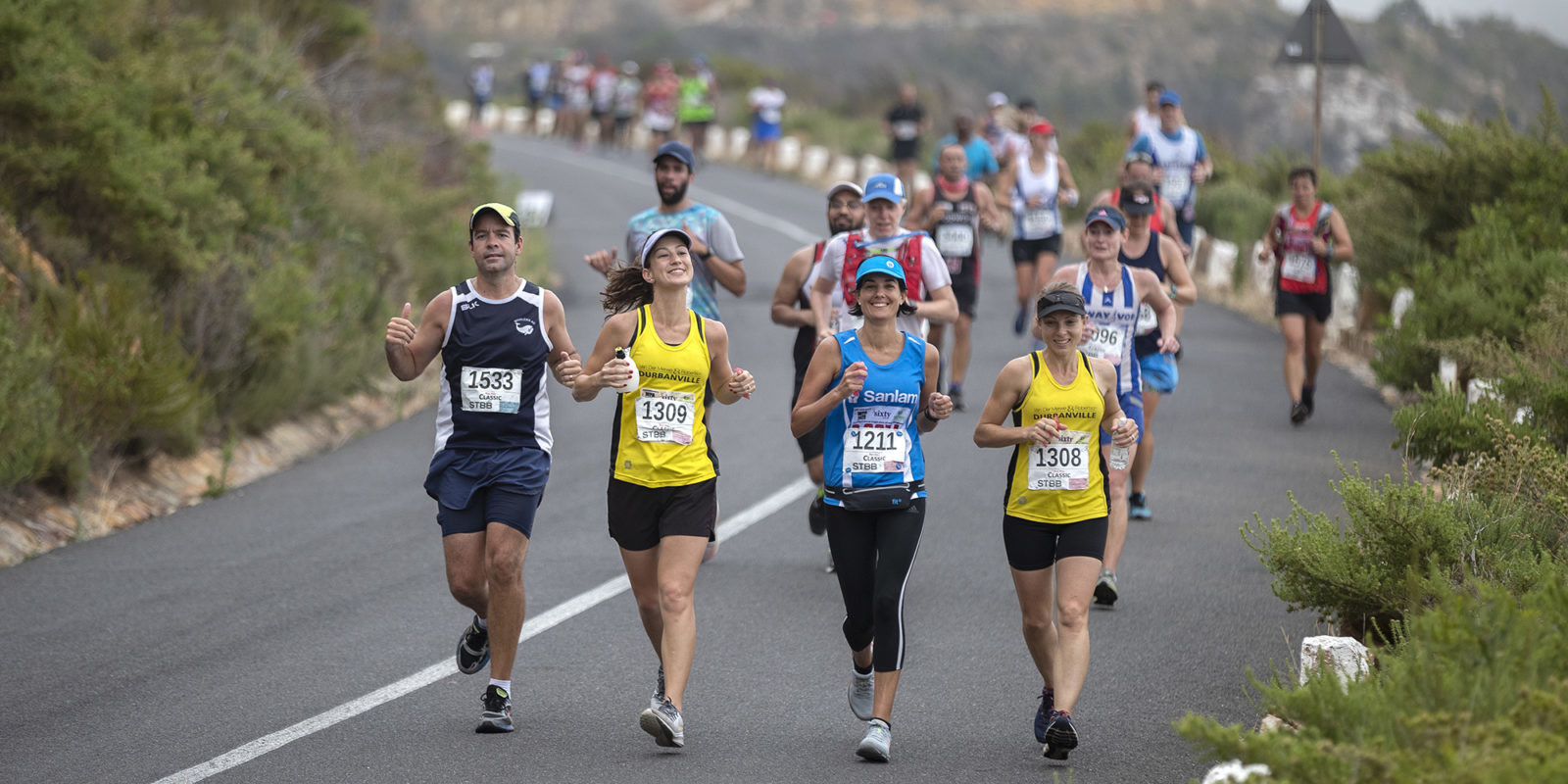
Entry will be free for South African runners who have already entered the 2020 Comrades.
The website will include an virtual online functionality through which runners can compete, ‘run with’ and compare outcomes against Comrades greats such as Bruce Fordyce, Frith van der Merwe, Samuel Tshabalala and many others.
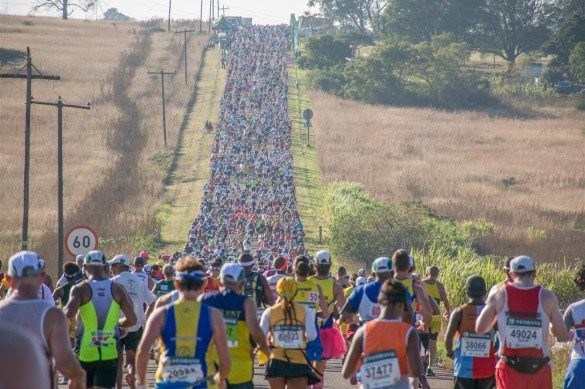
All that runners need to do is to visit the Comrades website, register for ‘Race The Comrades Legends’ and select their distance (5km, 10km, 21km, 45km or 90km).
The cost is R150 for South African runners and $25 for foreign athletes who have not already paid for and qualified for the 2020 Comrades.
Once registration is complete, runners will receive all the necessary race information and rules prior to the race date.
Athletes will then run their respective races, capture their times using a normal timing device and upload it. Their results will be calculated and updated automatically.
They will thereafter receive personalised race feedback by email.
The programme will include full integration of all popular fitness apps, including Strava and Endomondo for direct upload, as well as Garmin, Polar and Suunto.
Runners who do not have any of these devices or apps can upload a GPX, TCX or FIT file format from other devices and apps, or they can manually enter their time based on any watch.
Every entrant will receive a digital race number prior to the race, a virtual medal and certificate immediately after the race and personalised results comparisons.
All finishers will receive a real medal, which will be distributed as soon as possible, as opposed to the majority of virtual races which generally only award virtual medals.
It works pretty much the same way as any other type of running, the difference being that the runner can run at any location, especially in the comfort of your own home, on a treadmill, outside in the garden, or neighbourhood and all at one’s own pace.
by Richard Springorum
Login to leave a comment
Comrades Marathon
Arguably the greatest ultra marathon in the world where athletes come from all over the world to combine muscle and mental strength to conquer the approx 90kilometers between the cities of Pietermaritzburg and Durban, the event owes its beginnings to the vision of one man, World War I veteran Vic Clapham. A soldier, a dreamer, who had campaigned in East...
more...American ultra runner Zach Bitter breaks 100-mile treadmill world record clockin 12:09:15
American ultra runner Zach Bitter spent all day Saturday on the treadmill, starting at 6:30 a.m. PST and running until just after 6:30 p.m.
He ran for 100 miles (160.9K) and set the new treadmill world record for the distance with a time of 12:09:15. He bettered Canadian Dave Proctor‘s previous record (set at last year’s Calgary Marathon expo) of 12:32:26 by over 20 minutes. Bitter averaged an incredible 4:32 per kilometer over 12 hours and 100 miles of running.
Bitter’s average pace of 4:32 per kilometer would have given him a 3:11 marathon, which is a good time on its own, but he ran almost four marathons in a row on Saturday. The run was streamed live on YouTube, and different ultra runners and endurance athletes Zoomed in to chat as Bitter chipped away at his 100-mile trek.
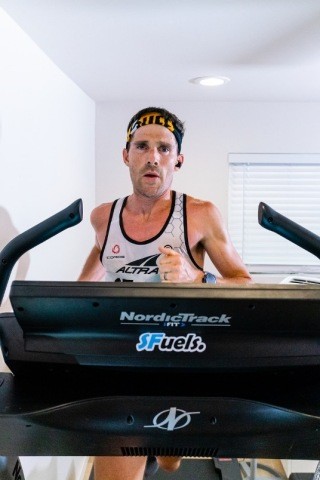
Some of those big names included 2019 Ultra-Trail du Mont-Blanc winner Courtney Dauwalter, Aravaipa Running’s Jamil Coury, Quarantine Backyard Ultra champion Mike Wardian and Proctor himself, who knows exactly what it takes to break the 100-mile treadmill record.
Bitter is already the world record-holder in the 100-mile run, which he set last August at an indoor track in Wisconsin in a time of 11:19:13. He is also the owner of the 100-mile trail record from the 2018 Tunnel Hill trail race in Illinois, where he ran 12:08:36.
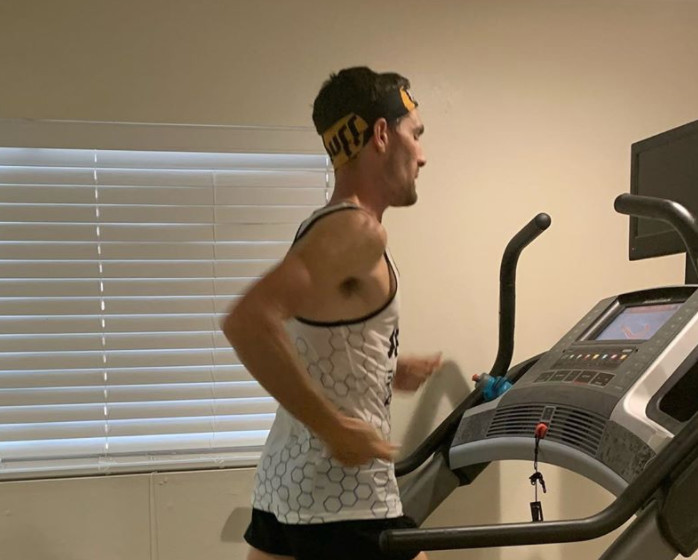
Now, he has officially added the treadmill record to his resume. With these three records to his name, it’s fair to say that Bitter is in the conversation for greatest 100-mile runner of all time, if not the outright winner of that title.
Bitter has been running ultra marathons for a decade now, and he’s got plenty of big race wins and results to his name.
He was 11th at the 2018 Western States 100, he took 32nd place at the 2016 Comrades Marathon and sixth at the International Association of Ultra runners 100K world championships in 2014. In 2019, he won three races, including the San Diego 100-miler in California.
by Ben Snider-McGrath
Login to leave a comment
Mike Reid, will be running in his back garden a 100km ultra marathon
A man is running a 100km "ultra marathon" in his back garden to raise money for a baby hospice.
Mike Reid, from Hinckley in Leicestershire, has calculated he will need to complete about 4,000 laps to cover the distance.
The run is due to start on Saturday night and finish on Sunday afternoon.
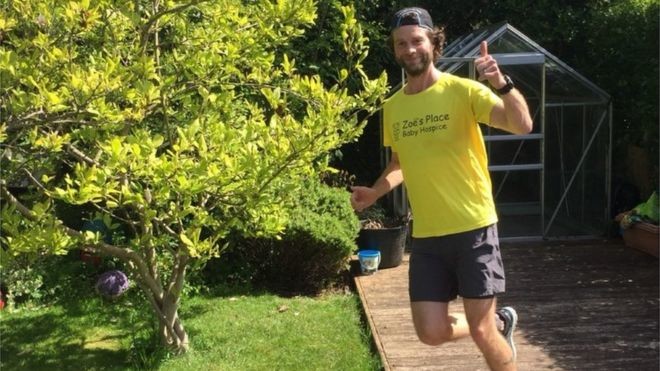
The 37-year-old, who is raising money for Zoe's Place Baby Hospice in Coventry, said the ultra marathon "could prove quite challenging".
Mr Reid has completed a handful of ultra marathons in the past - including two for the same charity.
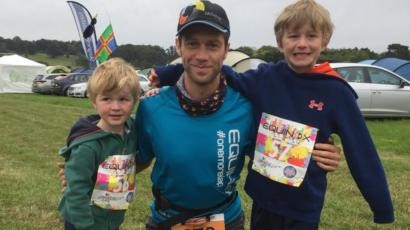
He said: "I have run long distances before and for long periods of time but never in such a confined space, so I think the limited area and frequent changes in direction could prove quite challenging.
"I also strained my calf on a run at the start of this week so I might have to potentially back off the pace a little."
He is running the "ultra marathon" in his garden due the restrictions in place to stop the spread of coronavirus.
He will be cheered on by his wife and two sons as he navigates his way around swings, toys, sheds and greenhouse in his 20m by 9m garden.
More than £500 has already been pledged by supporters for the hospice which is currently closed due to Covid-19.
He said: "I'm blown away by the generosity of people in such a small amount of time.
"This money is going to directly change the lives of children and families when they need it most."
Login to leave a comment
Michael Wardian set out for a virtual ultra marathon. He kept running for 2½ days.
n the early days of the second full month of the global novel coronavirus pandemic that has all but paralyzed the sports world, Michael Wardian went out for a run around the block. He woke up early Saturday morning, laced up his shoes and stepped outside to run around his Northern Virginia neighborhood.
He circled the block and then did it again. And then again and again. Wardian ended up running for more than 2½ days, skipping sleep and piling up miles. When he finally unlaced his shoes late Monday night, he’d run 262½ miles in all, winning a long-distance event called the Quarantine Backyard Ultra, a virtual race inspired by the social distancing recommendations that make a standard road race impossible in the midst of a pandemic.
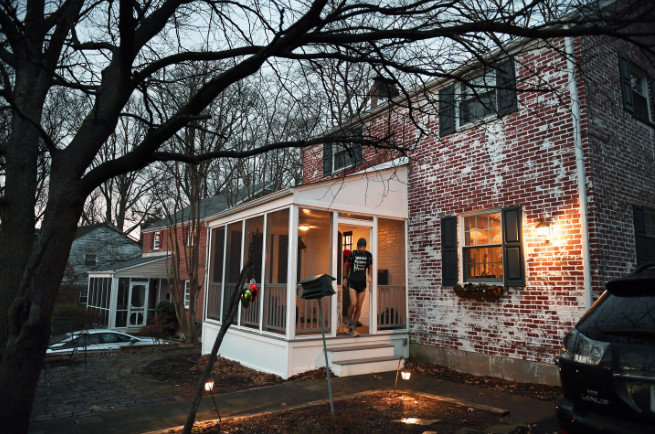
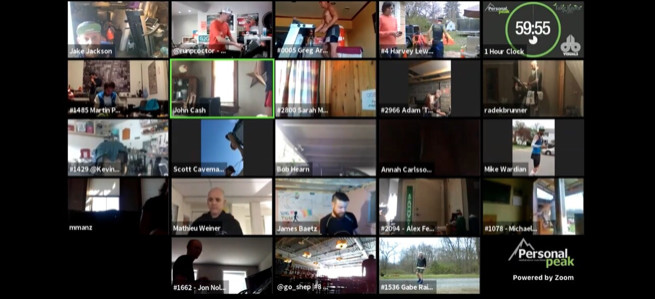
The unique event was intended to fill a void for distance runners who saw their race calendars wiped clean by the spread of the coronavirus. It brought together more than 2,000 runners from nearly 60 countries and turned into a captivating affair with a drama-filled, controversial finish.
“We do not know when this situation is going to end, and this is a fun way to bring a whole bunch of people together to be able to test their fitness, join a community, and do something together when many people cannot leave their homes,” a Calgary-based distance-running outfit called Personal Peak wrote in a March post announcing the race.
The rules were simple enough. The runners had to honor social distancing recommendations and either compete on a treadmill or in some sequestered environment. Some, such as Wardian, circled their neighborhood, while others circled their backyard. One entrant did laps around his living room in Dubai, and another ran circles in a Canadian coffee shop that had been closed because of the virus.
Runners were connected via Zoom and required to run 4.167 miles each hour. After hitting their hourly mark, the runners flashed their watch to the camera and then waited for the next lap to begin at the top of the hour.
For each 4.167-mile lap in the race, Wardian made 10 loops around the block in his Arlington neighborhood. That means that once the race began Saturday morning, he passed the same neighbors, same trees, same parked cars — same everything — more than 620 times.
The race began with more than 2,400 entrants, but they slowly dropped, and Monday was mostly a duel between Wardian and a runner halfway around the world named Radek Brunner, who was pounding out miles on a treadmill in the Czech Republic. Wardian officially won shortly before midnight Monday after more than 62½ hours of running when Brunner was disqualified because of a technicality.
Brunner failed to start running his 63rd lap precisely at the top of the hour, apparently because of some technical difficulty or confusion, and organizers reluctantly said they had no choice but to disqualify him for a rules violation.
In winning the event, Wardian ran the equivalent of 10 marathons in a little more than 2½ days. That’s a bit farther than running straight from Washington to Pittsburgh. Perhaps equally impressive: A sleep-deprived Wardian consistently turned in sub-10-minute miles, but his fastest lap was his final one, when he averaged 7:23 over the event’s final four miles.
Wardian, who turns 46 on Sunday, is well-known on the ultra circuit, his running exploits growing longer each year. He has raced against horses, run around the Capital Beltway, completed marathons on seven continents (twice) and competed in the U.S. Olympic marathon trials and most every other premier distance event. Until this virtual competition, though, he had never run so many hours and so many miles consecutively, he said.
To prepare, Wardian ran a full marathon in his neighborhood the week before, knowing he would be in for a grueling turn in the virtual race. After the first hours of the event ticked by Saturday, the field whittled down quickly. Treadmills broke, hamstrings tweaked, work and real life beckoned, quick power naps turned into full-bore slumber. But mostly the miles and hours just became too much.
By Sunday evening, after 36 hours and 150 miles, the field was down to 14. By that point, Wardian was running in the dark, and his kids were nearing bedtime. Overnight, the runners kept dropping, and at one point, Wardian thought he would be joining them. Around 3 a.m., he briefly stopped running and walked over to his wife, Jennifer.
“I was crumbling in the middle of the night,” he later explained. “She asked if I was all right. I said, ‘No, I just don’t want to be doing this anymore.’ She said that’s not a good enough excuse.”
So he kept going, finding a second wind. He would usually finish his 4.167-mile lap in 40 or so minutes, which gave him a bit of time to catch his breath before lining up again at the top of the hour. This was the reflective period when others typically bowed out.
After 42 hours and 175 miles, Matt Shepard, who had been circling the Tall Timber coffee shop in Canada, Matthieu Weiner of Pennsylvania and Scott Martin from Oregon all dropped. Then Greg Armstrong in Tennessee an hour later. And then, after 46 hours of running, the last female runner, Anna Carlsson, who had been trekking through the outdoors near the northern tip of Sweden, had to stop. She had been running on a frozen lake that had been plowed for the occasion but had to drop when a snowstorm approached.
Finally, as the race hit the 48-hour mark Monday morning, just Wardian and Brunner were left. Both knew it wasn’t the speed or mile-pace that counted. It was a race of attrition, and the last man standing would be the sole winner. Brunner sneaked quick naps at the bottom of each hour, but Wardian hadn’t slept since Friday night.
“Sleep, what? None,” Wardian said at one point. “This is my money race. I don’t need to sleep.”
Because we live in virtual times, the entire event was streamed online, first on YouTube and later on Facebook, and thousands tuned in to watch the runners in Zoom’s now-familiar checkerboard format. The audience was able to engage and ask questions of the runners as they rested between laps.
“Let’s keep doing this!” Wardian said into the camera after he was 216 miles into the race.
And so they kept running into a third day and night. Even with 250 miles behind them — around 9 p.m. Monday — both were turning in a relatively fast pace, and Wardian had his sights set on what organizers say is the virtual backyard ultra record: 69 laps.
But then a whistle sounded for lap No. 63. Wardian took off running in the dark, but more than 4,000 miles away, Brunner stood still on his treadmill, seemingly unaware the lap had started. The online audience watched as Brunner fielded a phone call from race organizers, visibly in disbelief that after 62 hours of running, he was disqualified over what seemed like a minor infraction.
Wardian finished his lap and was slightly confused, too — and also disappointed the race was over and he couldn’t add another record to his lengthy race résumé.
Login to leave a comment
Guy Hudson runs 50k ultra marathon in back garden for Horsham foodbank funds
A determined Henfield dad took on a 50k ultra marathon in his own back garden after the race he was meant to be running had to be postponed due to the coronavirus outbreak.
Guy Hudson decided to do 1,000 laps of his 50m garden course instead.
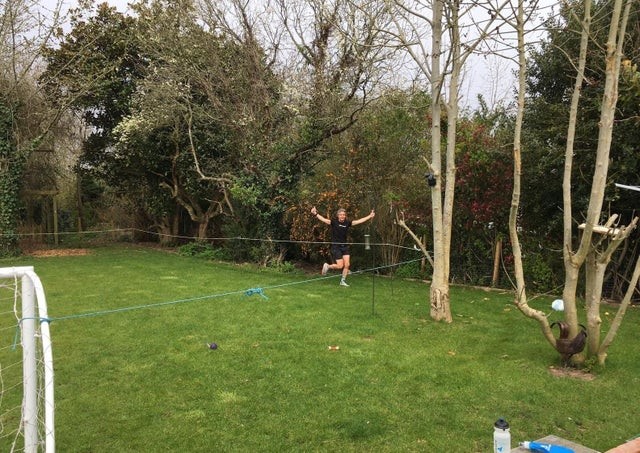
He exceeded his intended distance as well as his fundraising target, which saw him raise more than £1,000 to support the Horsham District Foobank which is experiencing an unprecedented level of demand for help at this time.
Guy said: “Originally I was going to do this just for a personal challenge but it occurred to me that I may be missing a trick if I didn’t also try and raise much needed funds for a local cause.
“It was amazing how many messages of support and kindness I received during the event and as donations were coming in, my daughter was shouting out the total and reading the messages.
“As of April 6, we’ve raised £1,101.80, an amazing amount from 55 people, some of which I don’t even know!
“I am so pleased that the Horsham Community Food Bank will be able to immediately begin using these funds to share support and kindness within the community that I live.”
Guy set off at 8.30am and hit the half way mark in 2hrs38 and the marathon in 4hrs42.
As he went passed his £500 fundraising target before the end of the marathon, he decided to continue until he reached 1,000 laps, and finished the whole fundraiser in 5hrs31.
Guy’s wife, Jo, and son, Sonny, both ran 200 laps (10k) each, while daughter Kitty looked after the food, drink and high-five station.
Guy said: “To even out the wear and tear on my ankles, hips and glutes, I’d decided to change direction every 20 laps which worked out well but became a little confusing remembering in the later hours of the challenge, so I decided just to stick to running clockwise.
“At first it took a while to get into the rhythm of just plodding round and round but as time went on, so did the headphones and sun cream and i just switched off.
“One of the weirdest things was how it seemed to get easier the longer I was going and the second half was definitely somehow ‘easier’ than the first.”
The money that Guy has raised will directly support the Horsham District Foodbank during the coronavirus crisis, for which Horsham Matters has adapted their service in light of Government advice and now provides a doorstep, contact-free delivery of three days’ emergency food for those experiencing financial poverty or for complex households needing support.
by Jasmin Martin
Login to leave a comment
How Running Boast Your Immunity
Exercise physiologist David Nieman has spent the last 40 years studying links between exercise and immunity. It’s not a new field. But with the increasing rate of race cancellations and general concern around the global COVID-19 coronavirus outbreak, plenty of runners have found themselves wondering whether their intense training is helping, or hurting, their health.
Exercise studies show that regular, modest exercise boosts immunity, and lowers your risk of infection. That’s the good news—and the reason so many scientists believe that running and other regular exercise is a healthy, body-strengthening activity.
On the other hand, hard, continuous, long-effort exercise like marathons and ultra marathons can lower your resistance for 24 to 72 hours, and lead to increased colds and respiratory illnesses for a week or two. Too much exercise volume and intensity turns the corner on what experts refer to as the J curve—and your risk of infection goes up.
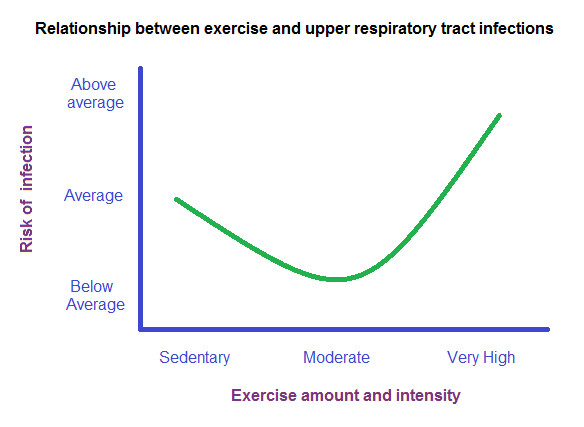
Case in point: Nieman and colleagues recently measured the immune response of Antarctic trekker Colin O’Brady, who in late 2018 became the first person to cross the continent unassisted, covering 930 miles in 54 days. The research team found that O’Brady entered a state of “dysfunctional immune response” that was most severe during the last month when his “energy expenditure was highest, body mass was reduced, and training distress was most severe.”
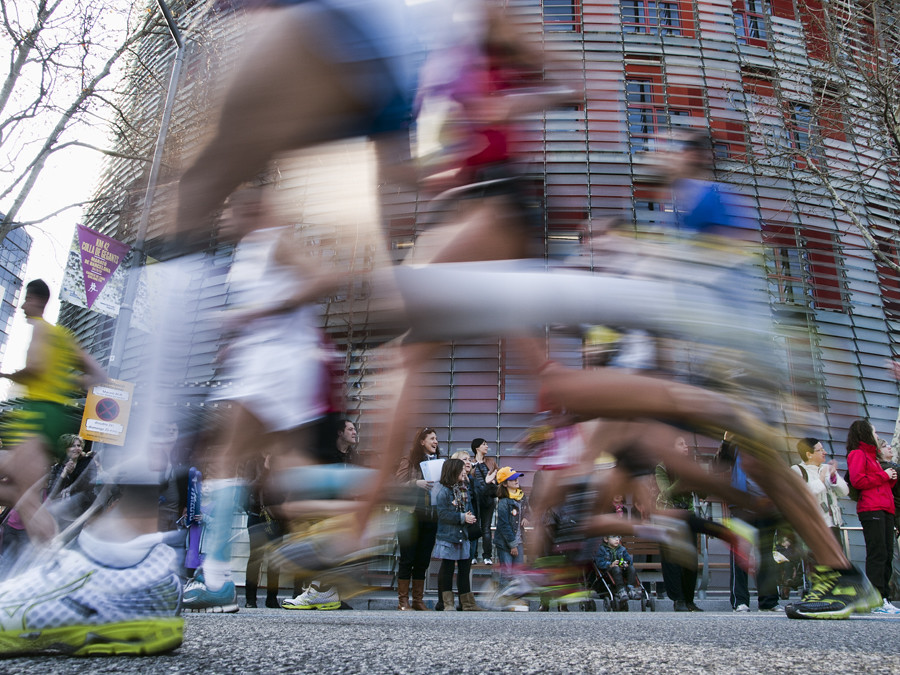
In his famous exploration of immunity at the Los Angeles Marathon, Nieman found that runners who had been training 60 miles a week or more had double the post-marathon infections of those training under 20 miles a week. Overall, marathon finishers had six times more infections and respiratory illnesses post marathon than a control group of non runners. This lowered immunity was transitory, meaning it didn’t last long, but it was significant enough to produce more post-marathon illness.
Train Smarter, Not Harder.- When it comes to training, more is not always better. For the biggest immunity-fighting response, Nieman suggests following this handy, easy to remember rule of thumb: Run less than 60 miles a week, mostly at a low intensity (60% of max VO2 corresponds to 75% of max heart rate), mostly in workouts that are less than 60 minutes at a time.
Nieman and colleagues have been surprised by one of their consistent findings. While long, hard runs seem to lower immunity, the same is not true of long, intermittent runs. In other words, a long marathon-pace run is a stressor, but if you follow a run/walk approach or even 10 minutes hard/10 minutes easy, you reduce the lower-immunity threat. “When you do a back-and-forth kind of running, your body seems to react in a favorable way, like you’ve just been out for a walk,” Nieman observes.
Eat to Boost Immunity.- Nieman believes the key nutrient that bonds exercise and good health is carbohydrates: before, during and after running. In fact, he notes a whole new science of immuno-metabolism that puts glucose and glycogen in the center of healthy immunity, just like they are in endurance running.
By measuring glycogen in immune cells, Neiman has discovered that a three-hour run (with no carb intake) depletes those cells just as it depletes your leg muscles, and the immune cells become noticeably dysfunctional. You could say they bonk. When runners consume carbs during the same run, their immune cells “look and perform much better,” says Nieman.
Beyond carbs, you might also want to stock up on blueberries. Nieman has long been interested in polyphenols, flavonoids and other food substances that support immunity. In a soon-to-be-published paper, he explored the effects of blueberries on immunity and inflammation after a three-hour laboratory run. One group of runners ate a daily cup of blueberries for two weeks before the lab run. Another group didn’t. “The blueberries knocked down the pro-inflammatory response by a lot,” he says, noting that this group of runners also had less muscle soreness.
While he has investigated other frequently-mentioned approaches like vitamin C and probiotics, he finds little evidence that they make a significant contribution to immunity. In Nieman’s world, if you’re consuming healthy carbs and blueberry-like, flavonoid-rich foods, you’re about 90% down the road to an immunity-boosting diet.
In a 2019 paper published in The Journal of Sport and Health Science, “The compelling link between physical activity and the body’s defense system,” Nieman and Laurel M. Wentz suggest several other simple and effective immunity-enhancing strategies that runners can follow all the time:
Develop a specific training plan built around ample recovery, sleep and possible mental stressors.
Don’t do individual workouts or weekly total workouts significantly harder than you’ve been doing.
Monitor yourself closely for early signs of illness and/or overtraining, and adjust accordingly.
Skip the gym with its crowds and potential pathogens. Run outdoors.
Avoid excessive alcohol intake.
Adapt stress management strategies to control for life’s hassles.
by Amby Burfoot
Login to leave a comment
Nontuthuko Mgabhi from Richards Bay aims to be the first woman from Africa to run the World Marathon Challenge
A Richards Bay woman is aiming to become the first woman in Africa to run the World Marathon Challenge - seven marathons on seven continents in seven days - in February.
On Suday, a 15km and 5km fun run and walk was held in Bulwer to raise awareness about her attempt and to help raise funds for it.

Nontuthuko Mgabhi, 32, will use the challenge to raise R3.5million for Khipinkunzi Primary School in Mtubatuba.
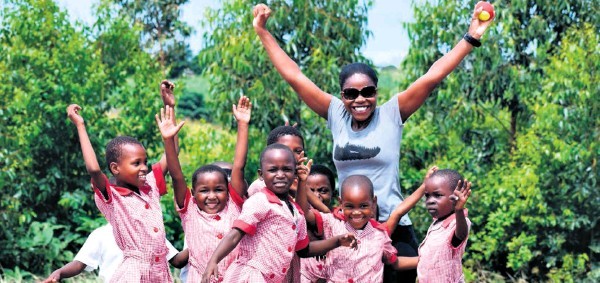
“I wanted to do something special for my birthday and was asked to give a motivational speech at the primary school last year, which has 657 pupils from Grade R to Grade 7. When I arrived at the school, I saw the poor state it was in and wanted to make a difference,” Mgabhi explained.
She is aiming to raise R3.5million to build five classrooms, two administration offices and to revamp the school.
Participating in the World Marathon Challenge means she would have to cover 295km and spend about 68 hours flying. The first marathon is in Antarctica on February 6, the second will be Cape Town on February 7, February 8 is in Perth, February 9 in Dubai, February 10 in Madrid, February 11 in Fortaleza in South America, and finishing in Miami on February 12.
Mgabhi said she started running in 2013, when a friend asked her to participate in the East Coast Radio Big Walk with her.
Ten months later, she participated in the Comrades Marathon and has since completed more than 50 marathons, including four Comrades and 15 ultra marathons.
by Kwazulu-Natal
Login to leave a comment
World Marathon Challenge
The World Marathon Challenge ® is a logistical and physical challenge to run seven marathons on seven continents in seven days. Competitors must run the standard 42.2 km marathon distance in Antarctica, Africa, Australia, Asia, Europe, South America and North America within 168 hours, or seven days. The clock starts when the first marathon begins in Antarctica. ...
more...Ultra marathon runner Will Mather has faced sleet, snow, and high winds during a month long challenge which will see him clock 500 miles
A brisk jog on Christmas Day morning probably fills most of us with dread - so spare a thought for Will Mather who is spending December running 500 miles.
Ultra marathon runner Will has faced sleet, snow, and high winds that blew him off a footpath during his ongoing quest to raise funds for charity.
The dad, from Hadfield, regularly takes to the fells, trails and roads around Glossop.
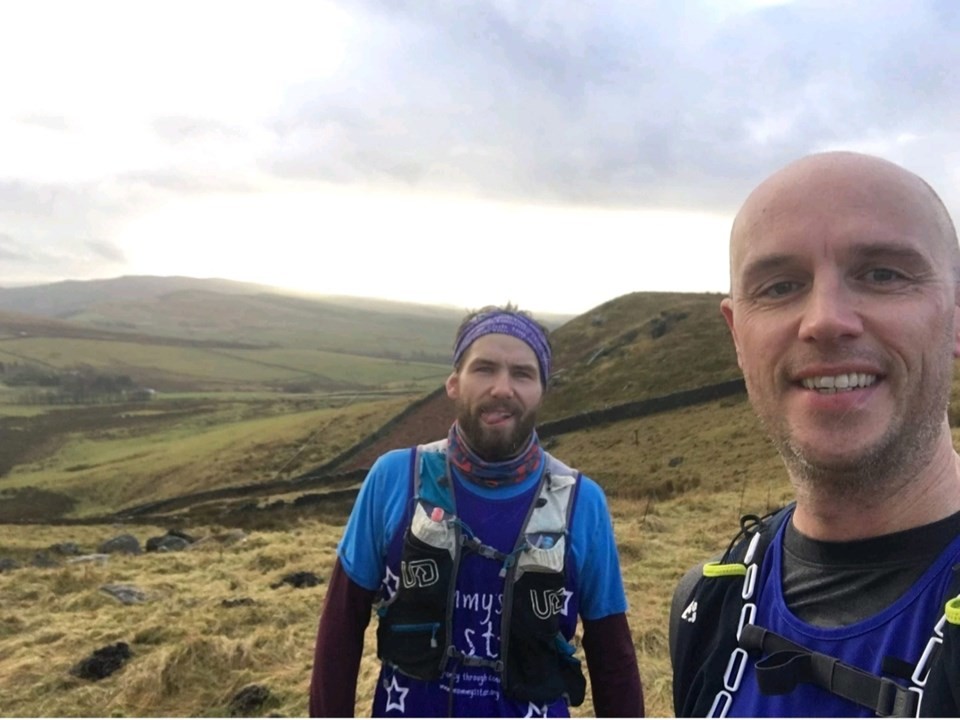
But he has stepped up his routine for a Christmas challenge in support of Mummy’s Star - which supports women and their families affected by cancer during pregnancy.
Will has been running an extra mile each day of the month, working up to 31 miles on New Year’s Eve.
“I started ultra running in 2017 when I had this idea and have thought about how to do it ever since,” he says.
“I could have chosen February where I'd only have to do 28 days but If I'm going to do it I need to do it right so it had to be a month with 31 days.”
Will has taken the last week of December off work so he’ll have time to meet his daily challenges when the miles really ramp up.
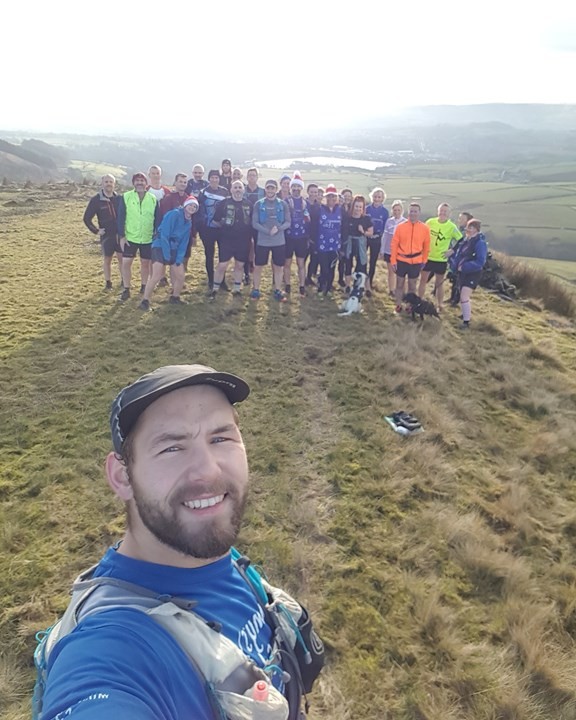
Haulier Will is being backed by his wife Zoe and sons Oliver and Riley during his challenge.
He says: “I’ll be doing this challenge for my local charity Mummy’s Star. It's an amazing charity and when I was introduced to it and read some of the stories it made me think what would I do if me and my wife were in that situation?
“This is the only charity of its kind so without the support mummy star gives there is no support. I think they play a vital part in these situations.”
Some days have been tougher than others but Will has been helped along the way by family and friends who have joined him on his runs.
“I got the wall feeling rubbish long days at work and just simply knackered (4-5hours sleep isn't the best) I still got out and did the 20miles, getting home at 10pm I had a shower and eat my tea in bed. Sleep was needed,” he wrote on his 20th day.
On day 16 he wrote: “16 miles around kinder trying to find a path as the clouds were low and the everything covered in snow.”
While on day 9, Will started his run at the eye wateringly early hour of 3.30am.
“Day 9 was a 9mile run on my own with the moon and badgers keeping me company at 3.30am, it does mean I can get a small rest period before I do 10 miles tomorrow evening,” he wrote.
by Beth Abbit
Login to leave a comment
'I puked, fouled myself and collapsed - it was great': Meet the record-breaking ultra marathon runner fuelled by beer and burritos
At the ultra running World Championship, competitors looped a 1,500 metres circuit continuously for 24 hours and, with time running out, American Camille Herron was suffering.
She had thrown up twice, stopped to lie down twice, and had such serious bowel issues the officials had forced her off the course to shower and change her clothes. By the finish Herron had run 168 miles, the equivalent of running 6½ consecutive marathons, each in an average time of 3 hr 44 min.​
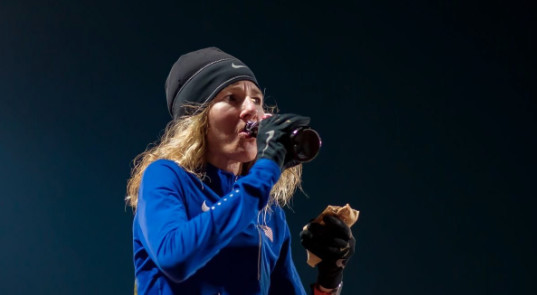
She certainly means it when she says: “I want to change what people think is possible. Especially for women.”​
Herron’s feat was a world record, she finished sixth in the race overall (including the men) and moved to third best on the United States all-time list for both genders. To get there she had to endure multiple setbacks.​
“I was trying this new fuelling plan with this new product and it wasn’t going well,” Herron explains. “The race was in France, so most of the rest rooms were squat toilets. For 350 athletes, they only had three normal toilets.”​
On her third bathroom stop in quick succession, she found a queue of athletes so decided to carry on. “But on that lap my bowels sort of unleashed themselves,” she says, laughing about it now. “But this is ultra running. S--- happens. Literally!”​
She switched her food to cups of mashed potato, makeshift burritos and her secret weapon – beer. Her condition did not improve but then a switch flicked in her mind.​
“After puking the second time, with 2½ hours to go, I just said to myself, ‘Let’s drop the hammer, let’s go beast mode’.”​

Herron started to fly. “I like to think of myself as a boxer, throwing punches,” she says. “Those last few hours were awesome, the most fun I’ve ever had in a race.”​
Surely she doubted, during the low moments, that it would all come together so spectacularly?​
“No,” she says. “I had already accepted before the race that I would be challenged. So at no point did I feel defeated. It was like ultra chess, we had to brainstorm how to deal with the problems. In the night, that’s the hardest part, because the brain is shutting down, so you’re trying to keep the light on.”​
Herron discovered the benefits of beer by accident. “I was in a trail race, really struggling, sitting in a chair. I’d tried everything and it wasn’t working and my husband just said, ‘You want a beer?’ I popped out of my chair after that. It got my blood flowing again.”​
During her latest world record she downed three Belgian beers along the way. “It settles my gut and helps me focus,” she laughs.​
Herron’s achievements are all the more astonishing as she has had to overcome a lopsided body, re-teaching herself how to run after years of injuries. She was born with her right thigh bone twisted inwards and has an extra bone in her right foot. “There’s something developmentally quirky about how I’m built,” she says. To reduce the strain on her body she re-learnt to run lifting her legs from the ground rather than pushing off. It means she looks like she is roller skating rather than running. “It’s like I’m prancing,” she says. “But I’m light on my feet. As a marathon runner, I had a great engine but I wasn’t fast enough because I wasn’t powerful. But as there’s less impact, for ultras it has turned out to be an advantage.”​
Since readapting her style, Herron has had only one injury, following a serious accident in February in which her car flipped upside down.​
Her steel was instilled from an early age. Herron’s grandfather was shot in both legs in the Second World War and awarded two Purple Heart medals, which are given for members of the US military wounded or killed while serving. He and Herron’s father were also basketball players under tough Olympic coach Henry Iba.​
“You had to be hard-nosed to play for him,” she explains. “My dad told stories of playing for six hours straight without water. So at age seven, I used to play in the yard, without water, until I blacked out. Then I’d get a sandwich and play some more. I was thinking, ‘This is what I got to do, push myself to extremes’. I was training for ultras without realising it.”​
Another formative event came when she was 17 and her whole family were made homeless by the strongest tornado ever recorded.​
“We get tornadoes all the time in Oklahoma,” she recalls, “so when we left the house I didn’t take anything. But it was crazy, four people in our area lost their lives, our house was flattened. But though we lost everything, I thought: ‘I’m still alive.’ At 17, that’s a big thing to realise, the value of your life. It changed my perspective.” From then on she started running on Sundays instead of going to church, to celebrate her life.​
Herron now believes that she can eventually chase down the men’s ultra running world records and she is partly driven by the inequality she feels is rampant in the sport. The normally upbeat Herron turns serious as she recounts her struggles for recognition in ultra running.​
“In my breakout year in 2015 I won two world titles and broke a world record and I thought I should get an agent,” she says, “but he couldn’t find me a sponsor. Then Jim Walmsley [a top male US runner] dropped out of Western States [a big US race] and I caught him in the world 100km championships, and he gets sponsored by Hoka. I was p----d.”​
She fired her agent and joined Walmsley’s agent, who eventually got her a sponsorship deal with Nike. Recently she was left fuming after a race in France offered prize money for the top 20 men, but only the top five women. And the women’s race was half the distance.​
“Sometimes it’s like a throwback to the 1970s,” she says. “I can’t believe it’s 2019 and women are still fighting for equal prize money. While everyone looks at the men like they’re superstars, I see people looking at me and tutting. I’m pretty tall, and I run aggressively and people don’t like it. I hear them saying, ‘She’s going out too fast’. So it’s a big motivation for me to run faster. To beat the men.”​
The way she is going, she might end up leaving them all behind. They can collect up her beer bottles when they come by.
Login to leave a comment
Grandma, Pamela Chapman Markl, 64, is breaking ultra marathons records
It’s not unusual to find Pamela Chapman Markle running anywhere from 80 to 100 miles each week. It’s just part of her long-distance race training as an ultramarathon runner, and the San Leon resident says she loves it.
“I enjoy the challenge physically and mentally,” said Markle. “It’s always a surprise to me to see how the body will adapt to what you demand of it.”
At 64 years old, Markle is persevering in a passion that pushes her to the limit. And the demands for ultramarathon running — races that go beyond typical marathon length of 26.2 miles — can be tough.

“My current running schedule is very hectic,” said Markle, who runs one long weekend run of up to 25 miles. “Stretching has become a necessity with my aging, and also some strength work.”
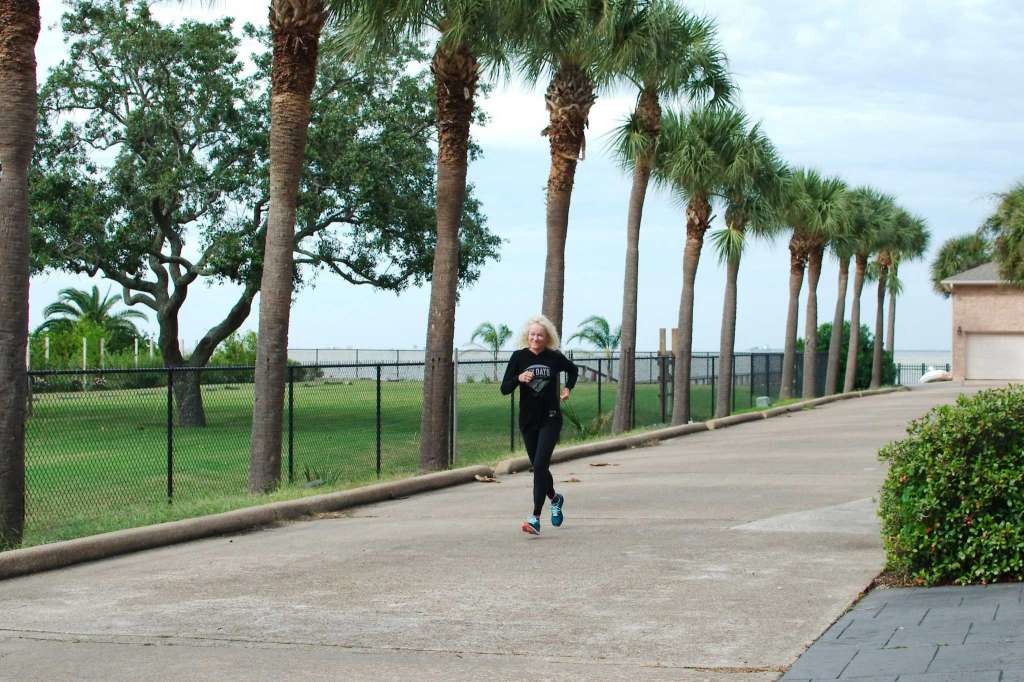
Races often range from 50 to 200 miles, with some lasting for an undetermined distance requiring more from 24 to 48 hours. The courses can be varied from cross-country trail races to repeating single loops on a track.
Most of the races that Markle has completed have been between 50 and 150 miles and last up to 48 hours. She has run almost 40 ultramarathons in the last 10 years.
“I have run nine ultramarathons since January 2019, and I have more to complete this year,” said Markle, who works as a certified registered nurse anesthetist.
Preferring to run by herself rather than in crowds, Markle doesn’t train with a running group and has no time in her schedule for the traditional marathons and 5Ks.
“I am disciplined enough to run alone and love it,” said Markle, who’s also careful to manage her nutrition for running.
Her hard work is paying off. Markle is breaking race records in her age division and earning recognition, including running one of the fastest times of 21 hours and 29 minutes in her age group at a 100-mile road race in Florida.
Markle set another record at the MadCity 100K in Wisconsin, where she won the USA Track & Field National Champion for her age group. She also set records in her age group for the Badwater 135 race, a course that covers 135 miles non-stop across California terrain.
Chris Kostman, who organizes the Badwater series of ultra running races, said Markle is redefining what’s possible for runners as they age.
“She has broken the women’s 60-plus age group record during each of the four consecutive Badwater 135 races she’s competed in,” Kostman said. “Her performances are plain to see, and we all stand in awe of Pamela.”
She became interested in distance running a decade ago when a surgeon who she knew ran ultramarathons encouraged her to give running a try. Her first race was called the Rocky Raccoon and 100 miles long. Markle trained for nine months.
“I didn’t train properly and had quite a few injuries,” said Markle, who has three daughters and eight grandchildren. “I decided to do another race with a different training program. Then I got hooked.”
by Kimberly Piña
Login to leave a comment
Rocky Raccoon 100 mile
Rocky Raccoon is the fastest 100 mile trail run for men in North America, as well as the oldest running 100 miler in Texas having been first run in 1993 with 29 finishers. It’s described as beautiful, fun, and great for veteran runners as well as those looking for their first 100 mile finish. Any American Citizen may enter the...
more...Women are not only finishing ultra marathon races they are winning some of them
According to conventional wisdom and most of the sport’s history, women should not win ultraendurance events — ever — when competing against men. But they are.
Three big wins in the past few months have put women’s performance in the longest and most difficult sporting events on the planet firmly in the spotlight. In September, American athlete Sarah Thomas, a cancer survivor, became the first person to swim the English Channel four times without stopping, spending 54 hours in the water and covering 134 miles. In August, German cyclist Fiona Kolbinger won the 2,500-mile nonstop Transcontinental Race across Europe and in January, British runner Jasmin Paris won one of the toughest running races there is, the Spine, a 268-mile jaunt across Britain’s backbone in winter, while breastfeeding her baby.
The proportion of women in ultramarathons was very low at the beginning of the ultrarunning movement. Records began for U.S. 100-mile ultramarathons in the late 1970s, and the proportion of women was basically zero. Now it’s steady at 20 percent. And not only are women running, but they’re winning.
That’s a record for women in the sport. Still, some prominent ultra gatekeepers don’t think women’s participation will equal success across the board.
Women are winning increasingly frequently. Badwater, the Spine, the Moab 240 — the list of big ultramarathons women have crushed goes on, and it’s not just a matter of winning against a weaker male field than usual. When Paris won the Spine in January, running 268 miles from England to Scotland, she smashed the course record by over 12 hours.
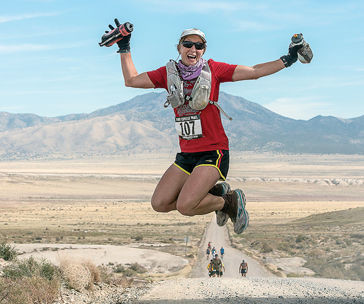
Physically, men hold most of the cards: better V02 Max, which measures the rate at which your body can take in and use oxygen, larger hearts, larger muscle mass, better body mass index ratios and stronger and (usually) longer bones. But women do have some advantages: They’re more efficient than men at converting glycogen to energy. Glycogen is the secondary source of fuel used when glucose levels drop, so basically women can access and burn fat better. They also store fat better, itself an advantage because it means they can draw on those stores during punishing longer races.
Psychologically, too, men don’t have an obvious edge over women. Let’s start with pain: If you’re running long distances, you’re likely to experience pain. Despite a popular myth that women have a higher pain threshold than men, studies show that in fact women feel pain more quickly. This works to their advantage in ultras, as a quick response to pain means that they can locate and treat small problems like the onset of blisters early in the race. Also, when women feel pain, brain studies have shown that they mobilize emotion-processing parts of the brain to deal with it and so can train themselves to overcome it, whereas male brains more often use threat-control circuits, giving them increased adrenaline and awareness — but tiring them out faster.
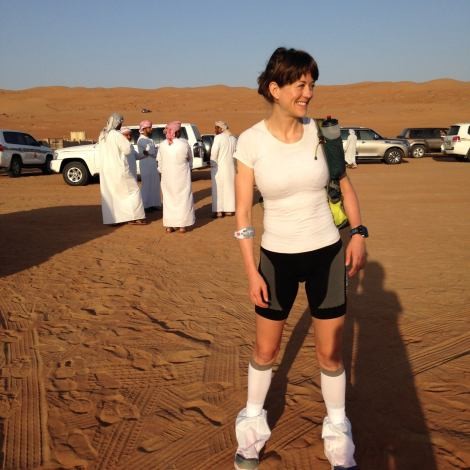
“Science doesn’t really back up anecdotal theories about childbirth making women stronger endurance runners,” says psychologist and keen marathoner Sian Williams, but she adds that there is evidence that women can be better at pacing themselves. A 2015 analysis of more than 90,000 marathon results for 14 races suggested both sexes slowed by the second half, but men more so than women. The study, published in Medicine and Science in Sports and Exercise, suggested that men’s early burst of speed is linked to competitive behavior but causes issues in the latter part of the race. “Perhaps the psychology of ego and risk plays as much a part as physiology in lasting the distance,” Williams concludes.
That psychology of risk emerges also in the way the sexes handle sleep deprivation. Men have the physical advantage: They need less sleep than women by an average of 20 minutes. But men and women have diametrically opposed reactions to lack of sleep: Men’s behavior becomes riskier, and women’s more risk-averse — also an advantage in an ultramarathon, which requires alertness, night navigation and injury management. In what could be the clincher, women have been found to become more selfish and ego-driven with lack of sleep, mimicking typical male behaviors and increasing competitive will, which could give them a final push toward the end of an ultra.
Elisabet Barnes is a two-time women’s champion of the Marathon des Sables, a 251-mile race across the Sahara Desert. She’s also won ultras outright, including Australia’s Big Red Run. For her, the key is less about biology and more about attitude — such runs require “leaving the ego behind, planning all aspects of the race meticulously and having a spiritual presence, leveraging the elements and working with them … rather than fighting the harsh environment,” she says This, she notes, may be easier for female participants.
Though the men have a clear advantage physically, female behaviors can disproportionately benefit them in the long and tough races. That could come in handy for the top ultra women who are setting their sights on that “overall winner” title. Even in the iconic Barkley — where many female running luminaries have tried and failed — 2020 could be the year for that elusive female first.
by Alice Morrison
Login to leave a comment
Chris Dunn-Veale, 46, runs 856km, completed nine ultra-marathons, with one race 106km long, seven 100km long, and one 50km
Chris said it felt "really good" to have completed the challenge.
He added: "It was amazing. I still can't quite get over it."Just talking about it doesn't seem real.
"I actually ended up doing 860km, because the last race added an extra 4km due to horrendous weather!".
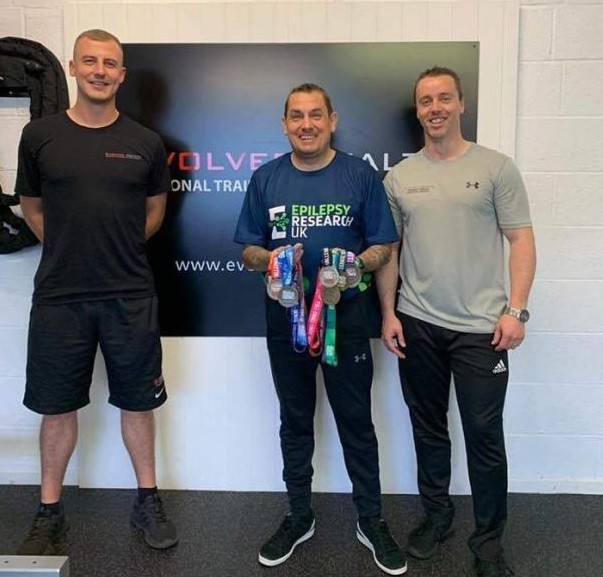
The feat was part of Chris' wider Challenge 10,000 - which began in 2017 - to raise cash for the charity Epilepsy Research UK, which he is a ambassador of - after losing one of his friends to the condition.

Chris began his ultra marathon challenge back in May on the Isle of Wight, and it saw him traverse some of the toughest running areas of the country, including The Jurassic Coast, parts of the Cotswolds, the Peak District, and Beachy Head.
The final race was last weekend.
Chris also wanted to give a big thanks to Matt Chappell and Charlie Blake, and Evolve Health.
He said: "They have really looked after me so well throughout the challenge, and they were absolutely amazing.
"They really kept me going, they helped me recover and stay fit, and sponsored me throughout.
"I want to thank everyone at Evolve Health, a lot".
Chris's Challenge 10,000 is still running, with the Epilepsy Research Charity Goal Challenge continuing to raise funds.
Clubs across Salisbury, and from as far as Bognor Regis to Weston-super-Mare, will donate £3.50 every time a certain player scores or keeps a clean sheet.
by Benjamin Paessler
Login to leave a comment
How Much Do Tennis Players Run Per Match?
How far does a professional tennis player actually run during a match? It sure looks like a lot of work chasing balls back and forth along the baseline.
Well, according to data that IBM and SI.com teamed up to track and publish data from the 2015 Australian Open, it varies depending on playing style.
The research reveals that, among the top men, David Ferrer (photo), who is known for his speed and agility, covers the most distance. Through three rounds of the tournament, Ferrer had run approximately 10,000 meters or 6.2 miles, which is particularly impressive when you consider how tiny a tennis court is (27 feet wide for singles).

On the other end of the spectrum, top-ranked Novak Djokovic, who was forced to stop due to a shoulder injury in this year’s tournament, had covered less than half that distance, somewhere between 4,000 and 5,000 meters or about 2.5 to 3.1 miles through three rounds of play.
SI.com reports that this is because Djokovic tends to play closer to the baseline, while Ferrer plays farther back. It’s also worth pointing out that the length of each game, set, and match will affect how long the match goes—the longer the set or match, the more running required.
A similar analysis conducted at the 2014 U.S. Open found that Caroline Wozniacki ran more than twice as far as Serena Williams (9,709 meters or around 6 miles for Wozniacki, and 4,509 meters or 2.8 miles for Williams) to make it to the final. Williams defeated Wozniacki in the 2014 final, but Wozniacki famously put all that running to good use two months later when she ran her first marathon, New York City, in 3:26:33. This year, Williams proves you don’t need to run all that much to win as she advances to the 2019 U.S. Open Women’s Final this weekend.
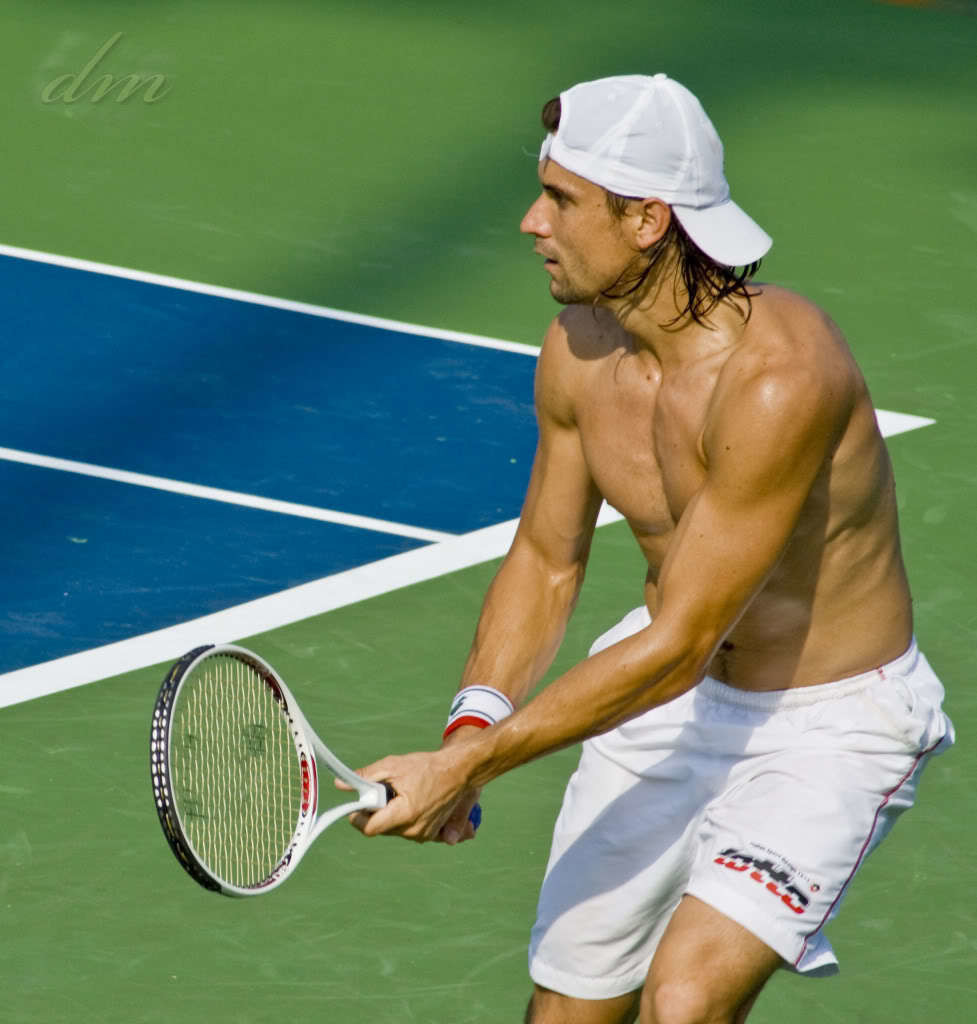
Wozniacki isn’t the only top tennis player to be marathon-curious. Both Djokovic and Andy Murray have expressed interest in running a marathon after retirement. But for Federer and Williams, it’s a hard pass for now—both feeling that they are not suited for the distance.
Because of the high-intensity of tennis, playing a few matches will help your cardio capacity. “It’s very intense. You are conditioning. It's a very hard workout and allows you to stay in shape,” says Kevin Vincent, M.D., Ph.D., the director of the University of Florida Running Medicine Clinic. Plus, running is an activity performed primarily on the sagittal plane of motion, which includes front-to-back movements like walking. By incorporating tennis into your training, you will benefit from the lateral or side-to-side movements.
That said, your legs still take a beating, and it can cause injury. The biggest risk to worry about? Calf and hamstring injuries, says Darrin Bright, M.D., OhioHealth sports medicine doctor and ultra marathoner. “If your foot catches or you plant wrong, you could get muscle strains. Tennis elbow is common among tennis players, but I primarily see acute muscles strains,” Bright says.
Ultimately. it’s fine to play (not to mention fun!), and may help strengthen your body and balance your leg muscles, just don’t try to rally on long run days or when you do a hard workout.
by Runners World
Login to leave a comment
Abbott has announced a new partnership with the Longford Marathon to become the title sponsor for the race in 2019
The marathon, which is in its 18th year, will take place on Sunday, August 25 and is expected to attract more than 1,200 participants.Ciaran Corcoran, strategic programmer director of Abbott’s diagnostic business site in Longford said: "Abbott has been a proud member of the Longford Community for more than 15 years, employing more than 700 people and we’re delighted to support the Longford Marathon, which is one of the largest events held in Longford each year. "Marathon runners truly embody the idea that at our healthiest, we can accomplish amazing things. Our sponsorship of the Longford Marathon allows Abbott to celebrate the health and achievement of people from all over Ireland.”A keen marathon runner, this year will see Ciaran Corcoran run the Abbott Longford Marathon for the 5th time. “I’m delighted that so many of my colleagues are joining me in this year’s marathon.
The support along the route from the people of Longford is tremendous. There is great excitement among our employees from Abbott’s 9 sites across Ireland, a significant number of whom will be participating on the day.
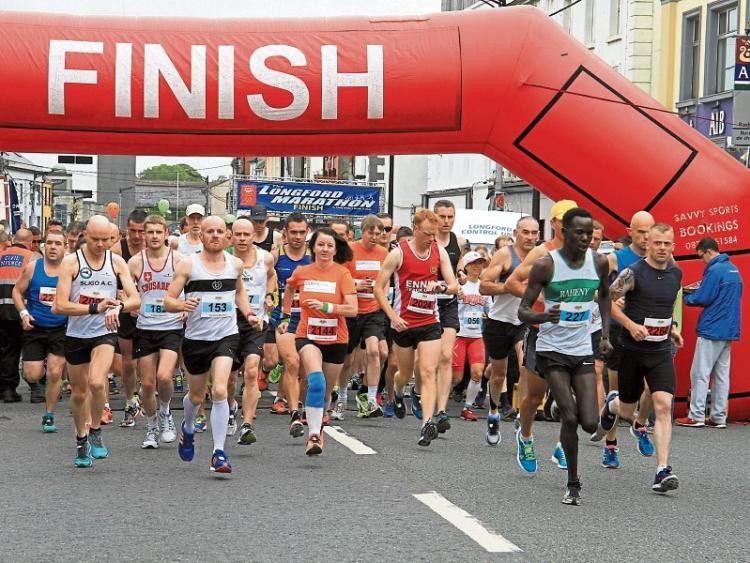
Not only is the marathon contributing to a great community spirit, it is also raising funds for St Christopher’s Services Longford, which provides services for the intellectually disabled throughout the midlands."
Fiona Fenelon organizer of the Longford Marathon said; “We are delighted to partner with Abbott as title sponsor of this year’s race. Abbott is one of the largest employers in the region and as a company focused on helping people to live their best lives, is a perfect partner for us.
"This year’s Abbott Longford Marathon will be one of the biggest ever, attracting participants from throughout the country. The Abbott Longford Marathon includes a range of race distances from a 5km race to a 63km ultra marathon. Regardless of ability and experience, participants can reach a meaningful personal achievement."
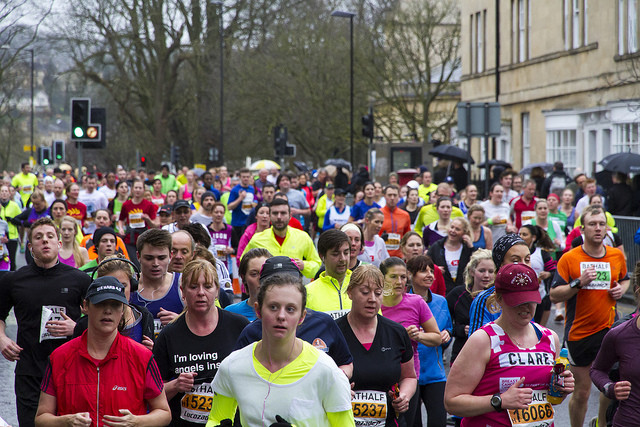
by
Login to leave a comment
Longford Marathon
The Friendly Marathon in the Heart Of Ireland. Ireland's friendliest marathon has a reputation for being one of Irelands best organised events, with a flat course, through the beautiful countryside of Longford, Roscommon and Leitrim beside the River Shannon. Take a place,its an ideal run for anybody training for the Dublin City Marathon in October. Organised by runners, for...
more...Amarjeet Singh Chawla lost his eyesight by age 40 but runs marathons to bring awareness about avoidable blindness
Amarjeet Singh, the visually impaired marathoner famously known as “Sporty Sikh”, on Sunday completed a 21-km run in Pune to raise awareness about the issue of “avoidable blindness”.
Singh was diagnosed with macular degeneration, one of the leading causes for vision loss, at the age of 13, and lost his eyesight completely by the age of 40. It was only at 48 that he started his sports career. He had earlier won a gold medal in 50m freestyle at an all-India swimming competition for disabled in Mumbai and is the only blind person to scale the 19,830-ft Dolma Pass in Tibet.
Asked how he is preparing for the Kargil Marathon, Singh said: “I have never practiced regularly for any marathon event. I am visually impaired and need a person to help me run. I cannot find a person to help me every single day. So, I practice only on the weekends and try to complete one run, be it 10km or 21km. The Kargil Marathon is on August 25. I will go there three days in advance with Rahul Brahme who has escorted me in 32 half marathons. We have a good tuning. In the three days, we will do 5km runs twice a day to get acclimatised to the weather as there is a risk of elevation in that area.”
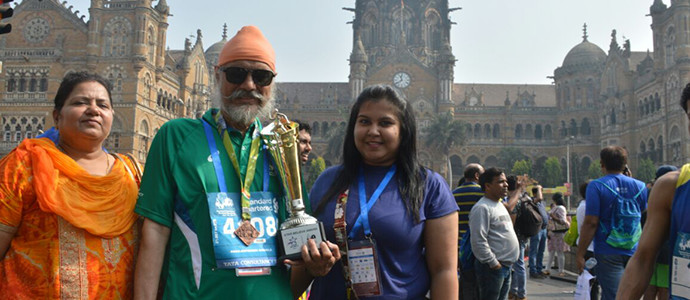
Singh has finished 179 runs in all and there will be five more before the Kargil Marathon. “I have done 107 half marathon (21km), 66 10km runs, five ultra marathons and one intercity ultra. I wish to be a part of longer runs. I want to run from Delhi to Amritsar, which is approximately 650 km, to raise awareness against drug abuse,” he said.
Asked about the most difficult run he has completed so far, the Sporty Sikh says: “The Mumbai-Pune 160km run held in June was my first long-distance run and the most difficult so far.
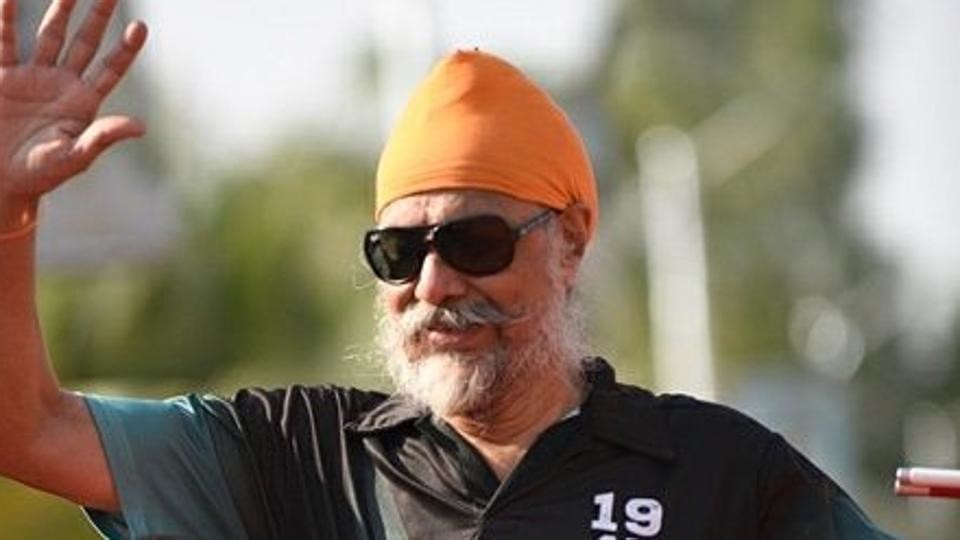
I began my run from Goregaon Sports Club and a few women who had earlier participated in Pinkathon escorted me. Severe summer temperatures made the run difficult. It was 44° Celsius and the most difficult part of the race was the ghat section. This was a three-day run and I am thankful to the people who escorted me and helped me.”
The 63-year-old marathoner says he wanted to do something in life that would help people remember him. “I was approached for a fundraiser for the visually impaired persons and my first marathon was 7km. Cricketing hero Kapil Dev escorted me for 200 metres. This is when I thought that running for a cause will take me places. After that I was escorted by Milind Soman, felicitated by Sachin Tendulkar and have received the mayor’s award in Mumbai. All this appreciation keeps me going. I motivate myself and after completing every event I ask myself: ‘Bol Amarjeet, karega kya?’ (Tell me Amarjeet, will you do it?) and my inner self says yes and I get ready,” he says, adding that he never says no to run: “You can ask me to run at any point in the day; even at 2am. Just a cup up tea and I am ready.”
by Shalaka Shinde
Login to leave a comment
How high-tempo training with elite Ethiopians helped Briton Tom Evans to place third at the Western States 100 this year
Tom Evans spent two months in Ethiopia training with elite marathon runners to prepare for this year’s Western States 100 mile ultra marathon. The training paid dividends as he finished third with the fastest ever time by a non-American runner of 14 hours, 59 minutes and 44 seconds.
“The slowest runner [in the Ethiopian running group], except for me, was a 2:08 marathoner,” the Briton said. “That made it very interesting. Their tempo runs were on dirt tracks with rolling hills, so were perfect for Western States.”
“They would run until they dropped and we were being followed by a car so they’d be picked up,” Evans said. “At first, because of the altitude, I was the first to drop out but I began to get used to the elevation.”
WSER100 is one of the most prestigious 100 mile races in the world. It takes place in California, starting at altitude before descending into deep, hot canyons. Jim Walmsley won this year’s race in a record 14:09:28.
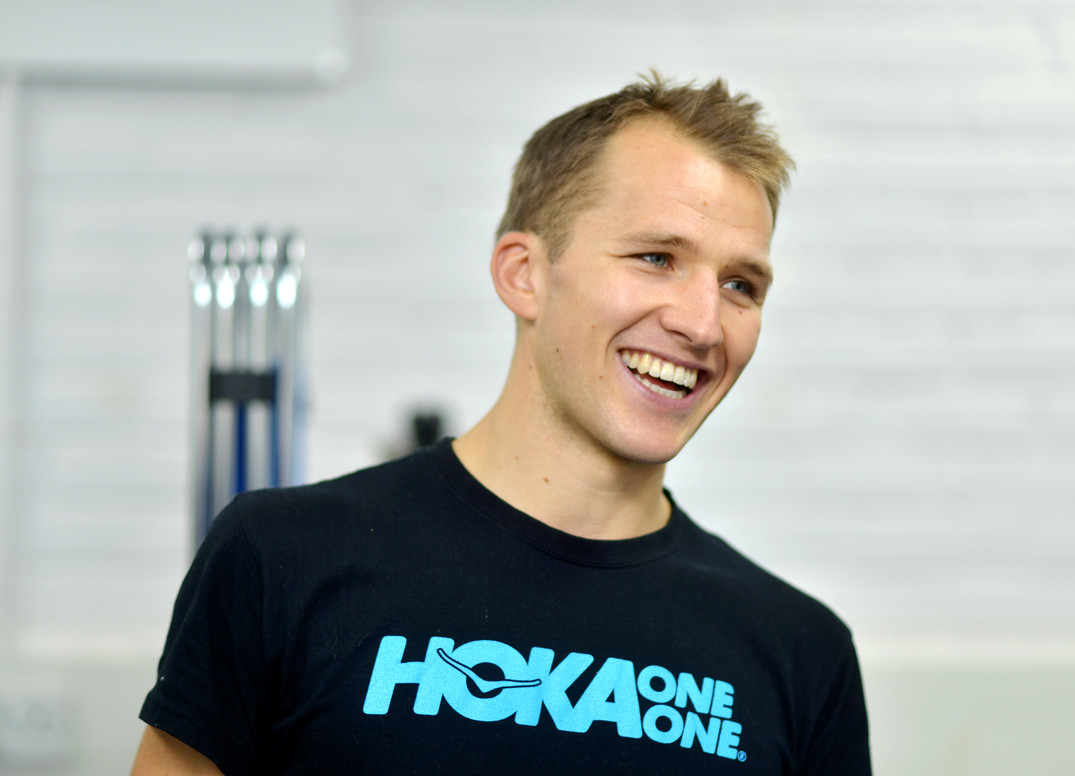
The brutal tempo sessions in Ethiopia were fuelled by fierce rivalries, with runners motivated by the hope of being picked up by foreign agents and given the opportunity to race and earn money abroad.
“It’s almost becomes survival of the fittest,” Evans said.
The “sag wagon” that accompanied the runners was always a tempting respite from the sessions.
“You can drop out when ever you want,” he said. “So, it’s about how much you want it. It was really good mental strength training as they were always going fast and furious.”
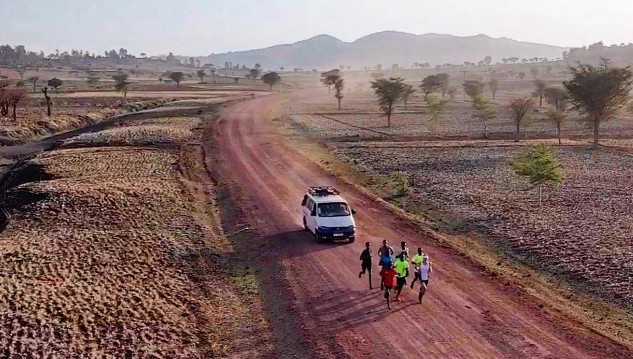
Being in a new environment forced the former soldier to be more flexible in his attitude to training.
“You had no idea what was going to happen. I had kids throw rocks at me one day,” he said. “It was such a culture shock. I just had to deal with what was ahead of me day by day.”
Evans said he had learned from them the importance of strong contrasts between hard and easy sessions.
He felt not all of the training was relevant to his competition goals. The other athletes in the group were all preparing for marathons or half marathons, so their longest run was just two hours. Evans would sometimes head out for eight hours at a time.
“They thought I was absolutely mental,” he said. “They couldn’t get over how much volume I was doing. But they were fascinated. They really respected what I was doing.”
There were no coaches on hand to force runners on to the track or trail, but the total immersion experience meant they were not necessary.
“I became so attuned to my body. I was making decisions to drop out of sessions all based on feel,” he said.
Evans, who has won the CCC event at the Ultra Marathon du Mont Blanc (UTMB) week, could feel the effects of his training when he ran WSER100.
“I just felt so much more efficient,” he said. “So, at the end, I was still able to run hard.”
“For me, coming third in my first 100 miler was a best-case scenario,” Evans said. “I knew it was possible, I just didn’t know if it was probable.”
For now, Evans is going back to shorter races of about 50km to 100km, but he said the experience had “lit a fire” in him.
“I definitely want to come back and see if I can improve my place, if not my time.”
by Mark Agnew
Login to leave a comment
Western States 100
The Western States ® 100-Mile Endurance Run is the world’s oldest and most prestigious 100-mile trail race. Starting in Squaw Valley, California near the site of the 1960 Winter Olympics and ending 100.2 miles later in Auburn, California, Western States, in the decades since its inception in 1974, has come to represent one of the ultimate endurance tests in the...
more...Kyle Robidoux is legally blind and will be making history as he takes on the Western States 100 this weekend
When 43-year-old Roxbury, Massachusetts resident Kyle Robidoux sets foot on the starting line at Squaw Valley Saturday morning, he will be making Western States history.
According to Race Director Craig Thornley, Robidoux will be the first known runner in the 45-year existence of the Western States 100-Mile Endurance Run who is legally blind.
With the help of a team of sighted guides, Robidoux will attempt the 100.2-mile trek from Squaw Valley to Auburn. But he is no stranger to ultra running. Since being declared legally blind at age 19, Robidoux has completed a number of premier running events, including five Boston Marathons.
"I've run in three 100-mile races, all with varied terrain, but Western States by far will be the most challenging," said Robidoux, who is being sponsored by Clif Bar. "There are a variety of conditions, so it'll be important for me to run really hard when terrain is runnable, knowing on climbs I'll have to walk. I'll have to make up my time during the runnable stuff."
Robidoux was diagnosed with Retinitis Pigmentosa, a degenerative eye disease that affects night vision and typically leads to complete blindness, when he was 11. Though he still has an estimated 3 percent field of vision, his eyesight has gradually declined over time.
"I have very extreme tunnel vision, like looking through a paper towel roll," Robidoux said. "I have no peripheral vision, no up or down, no night vision at all. I'm not colorblind but I can't see contrast very well. When I'm running, I can't tell the difference between dirt, rocks or roots. I can't see elevation change and I can't see if I need to step up or down."
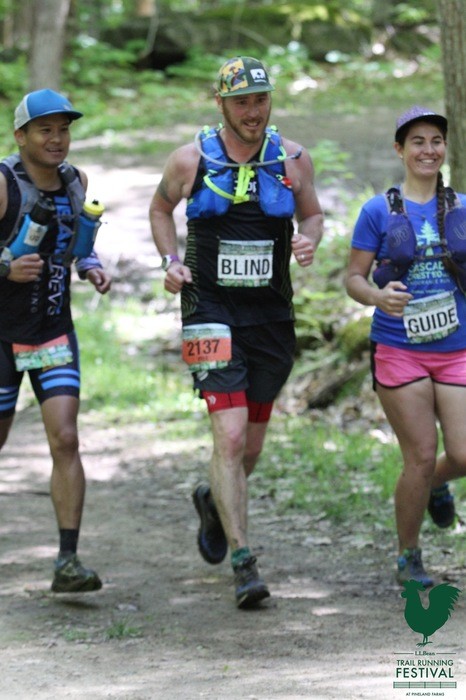
That's where his guides come in. Connected through an organization called United in Stride, which helps recruit sighted guides for visually impaired runners and vice versa, Robidoux's guides run side by side with him, bound together by a tether. The guides act as a sight coach throughout the race, giving various verbal cues to the visually impaired runner.
"Their goal is to keep me safe and keep other runners safe during races," Robidoux said. "They keep me moving forward and upright. That puts me in a position where all I have to focus on is running; not if I trip on something or run into someone else."
Among Robidoux's guides is seven-time WSER champion Scott Jurek.
"It will be fun seeing this course in a different light," said Jurek. "It's so cool to have an opportunity to be someone else's eyes."
After getting to know each other over the past several years, Jurek feels Robidoux is up for the challenge.
"Kyle's got a tenacity to him," Jurek said. "He might not be the fastest, but he's got an intense desire, something you have to have for Western States, whether you can see or not."

That desire sprouted from depression. Robidoux's initial resentment toward his diagnosis made him inactive, overweight and on a path toward Type 2 diabetes.
"I essentially dealt with it by not dealing with it," said Robidoux. "I was bitter and angry about my eyesight. I was convinced things were being taken away from me that I loved doing."
With the support of his family, Robidoux began seeing a therapist to help deal more effectively. Soon after, he started running again to improve his health and be able to play with his daughter, Lucy. He dropped 70 pounds and completed his first event – the Maine Half Marathon – by age 34 in 2010.
“I started to realize that things weren’t being taken away from me, I was giving up on them,” Robidoux said. “I still have days when I get really angry and frustrated. It’s a continuing process. There’s a strong likelihood that I’ll lose all of my vision. It’s scary, but I’m learning how to adapt and emotionally prepare for that.”
Robidoux has finished over 25 marathons and ultra marathons and plans to continue for as long as he’s able.
by Nick Pecoraro
Login to leave a comment
Western States 100
The Western States ® 100-Mile Endurance Run is the world’s oldest and most prestigious 100-mile trail race. Starting in Squaw Valley, California near the site of the 1960 Winter Olympics and ending 100.2 miles later in Auburn, California, Western States, in the decades since its inception in 1974, has come to represent one of the ultimate endurance tests in the...
more...Two Words That Can Really Help Your Marathon Training
Believe it or not, there is a method to those runs in a marathon program and these words can make that effort count!
Put simply, those two words are “slow down." This may sound strange but let’s break down why this is so important!
I have run almost 60 marathons/ultra marathons over the past 12 years and it took me that long to finally reach a goal that I had had from the beginning – to run a sub-3 hour and 30 minute marathon. Part of that reason had to do with the fact that probably 80% of those marathons were not serious efforts and more for the location.
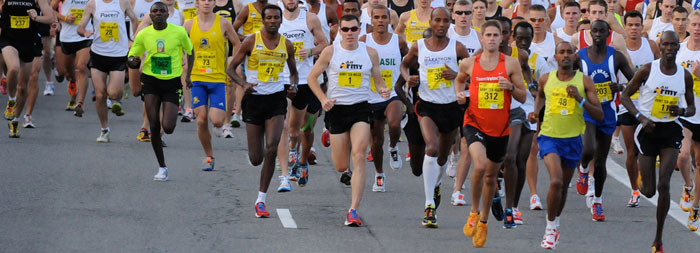
But, I firmly believe that another reason had to do with the training program I was using (Hansons Marathon Program) and the focus on the off-day runs being run at slower paces.
A marathon training program will typically have a few elements – the easy run, the long run, and the speed/tempo runs. The speed runs will include things like tempo runs and repeats.
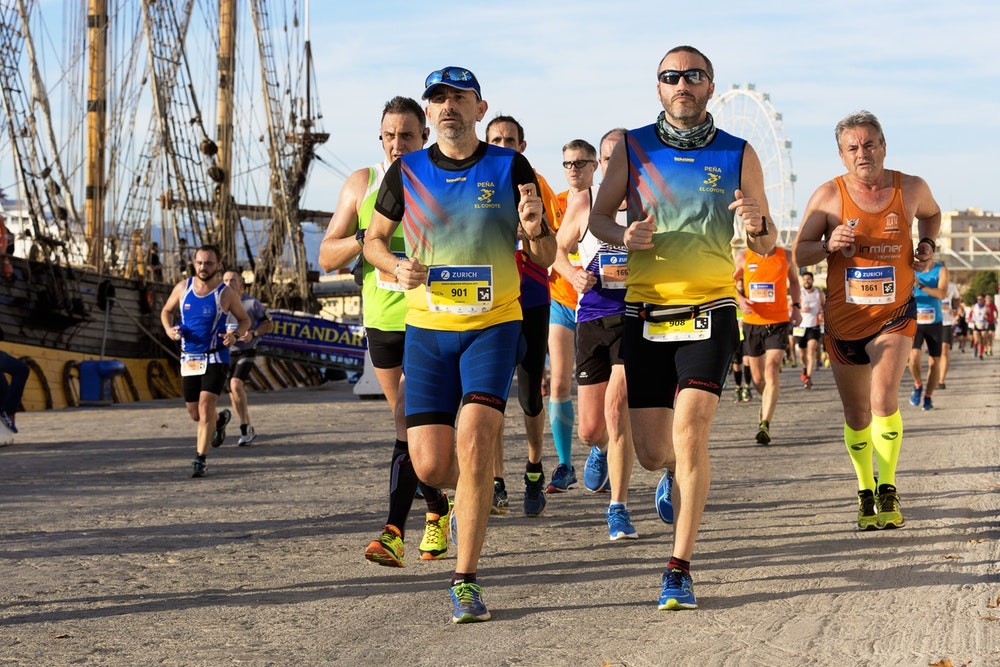
The long run will get your body conditioned to staying on your feet for longer periods as you prepare for the 26.2 mile distance. Finally, the easy run. These runs are typically to help you get your miles in and to help you aerobically.
Many times, runners attack these slow days as if they need to turn in quality performance runs every time they hit the roads. This means running these slower runs at paces that are between what they should be and the speed workout paces.
This actually does not help in your body recovering between workouts and instead treats these miles and runs as workouts, instead of slow and comfortable paces to help your body and muscles recover while still covering the miles.
There are even a couple of programs that recommend not even doing those slow runs but instead doing cross-training on those days and only running for tempo runs, repeat workouts, and long runs. This is again because those slower runs are meant to help in recovery while still helping your heart and blood flow.
So, while it may seem that running slow on slow days is not very beneficial, it can actually be one of the most important parts of a training program! It allows you to continue to get the benefits of a workout and the mileage while not taxing your body more than it should be for the “easy” day of the program.
I do know this – my last training program was more fun and more productive than any program I had ever used before and I feel that I owe a lot of that to the fact that I actually forced myself to slow down on slow days to a pace that was much slower than I had ever run before on slow days.
Remember – while each run can have a purpose, every run does not have to be fast. Slow down on those easy days and trust your body and the program.
by Charlie
Login to leave a comment
Four runners from India are eyeing a place in the 2019 IAU 24-Hour World Ultra Marathon Championship to be held in France in October
Rajasthan's Lallu Lal Meena and Yamini Kothari and Odisha's Pranaya Mohanty are attempting this feat during the 24 Hour Stadium Run at the Mumbai University track, which began at 6pm Saturday and will finish at the same time Sunday.
Sikkim's Shiva Hang Limboo too will aim to make it to the 24-Hour World Ultra Marathon Championship in the 12-Hour category.
The top men will cover close to 200 kilometres (124 miles) during this period while the women should hit 170 km (105 miles).
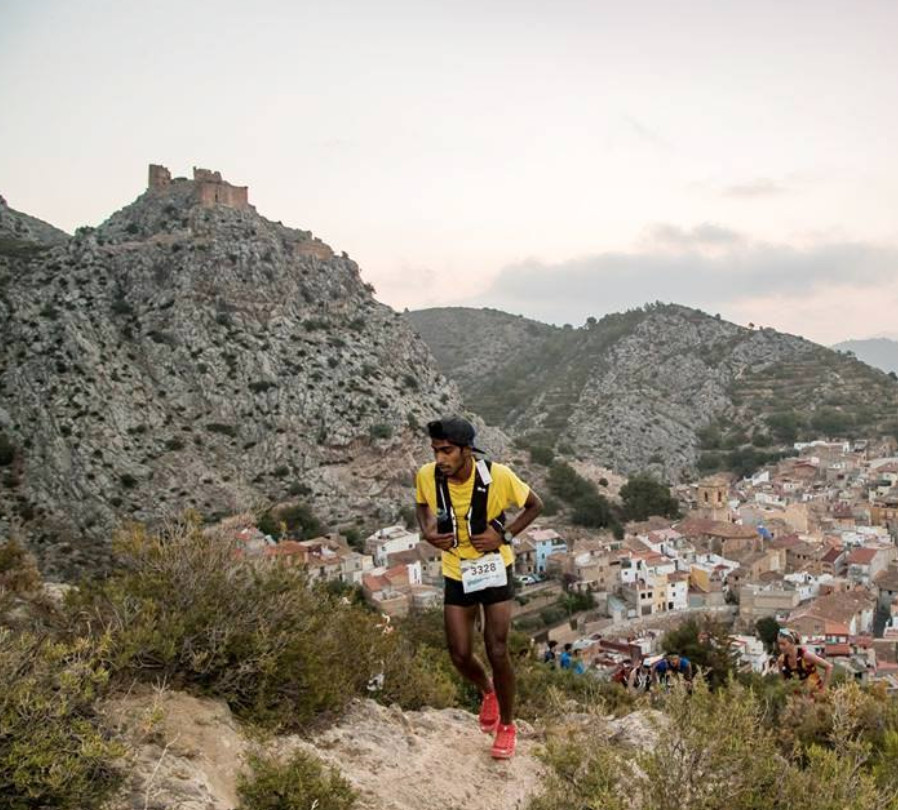
The 24-hour Stadium Run tests the endurance as well as mental and physical abilities of athletes.
"I have a great chance of qualifying for the worlds," said Meena.
"I have done it in the past and I am quite confident of making it there once. The criteria for qualification is 205 kilometres and I have come with a target of 220 kilometres.
I'm also attempting to run for 23 hours straight and if my body permits I will do 24 hours without any break," Meena was quoted as saying in a release issued Saturday.
Login to leave a comment
A brand new urban ultra marathon challenge is going to take place in the heart of London
Ultra London, a brand new urban ultra-marathon event, is set to take place on Saturday October5. The multi-distance event will be held on an innovative course, that aims to showcase some of London’s finest viewpoints, whilst crossing many of its lesser known open spaces, nature reserves and Sites of Specific Scientific Interest.
The 55km ultra course starts in Woolwich and finishes in Richmond upon Thames, with participants following large parts of the Capital Ring Walk route across south London. The challenging yet accessible event also includes a 27.5km run or walk starting at Crystal Palace, also finishing in Richmond.
The course, a mix of trails, footpaths, parks, disused railway lines, woodland and more will provide a challenge for participants who will also need to ensure they navigate the correct paths through parts of Falconwood, Grove Park, Crystal Palace, Streatham, Wimbledon and onto Richmond.
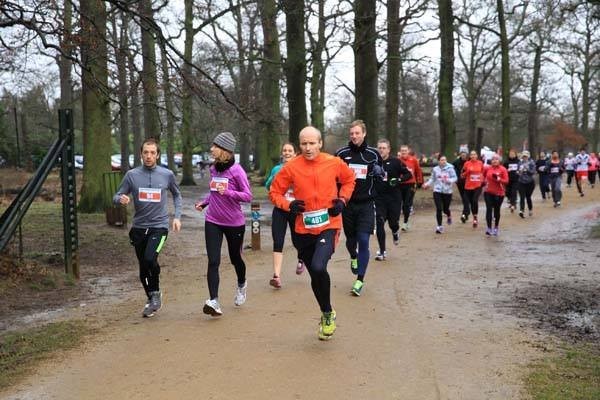
Andy Graffin, Director of Product Development at The Great Run Company who are staging the event, said: “We’re excited to be trying something new in the growing area of ultra running. Many of London’s landmarks are world famous of course, yet the Capital Ring is a comparatively little-known gem and we hope this event will provide participants with a suitable challenge and perhaps some surprises along the way, they will pass numerous landmarks and enjoy some breath-taking views of the Capital.
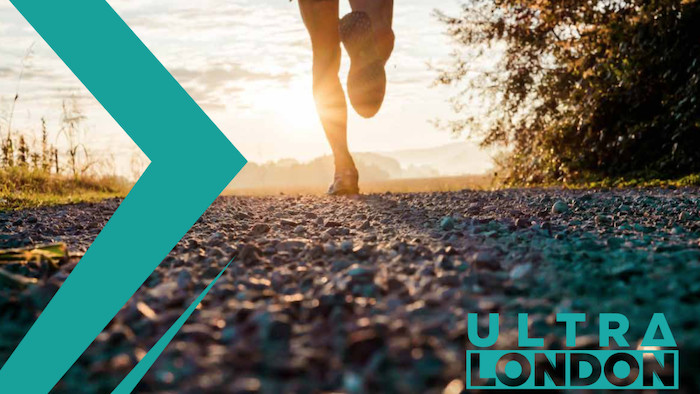
“Being in London, the event is accessible for participants and also for friends, family and supporters who can plan a route using public transport that will allow them to see their runner at numerous points along the course.”
Whilst the inaugural event this year uses the southern half of the Capital Ring there are plans to include the northern half of the route in 2020, where the ultimate challenge for ultra-runners will be to complete the entire 125km circular route in the Ultra London 125.
Login to leave a comment
South African Gerda Steyn shattered the course record at Comrades as Camille had to drop out due to hamstring issues
The 94th running of South Africa’s premier Ultra marathon, the Comrades got underway at 5:30am Sunday June 9.
South African runners Edward Mothibi and Gerda Steyn ended up the 2019 Comrades Marathon champions. Gerda broke the course record winning one million R ($66,849US) in the process.
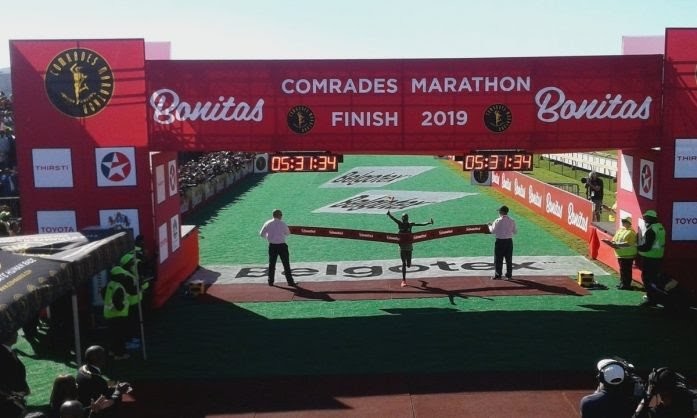
Edward Mothibi won the race after a fourth placed finish in his Comrades debut last year, beating defending champion Bongmusa Mthembu by just 25 seconds.
Local favourite Gerda Steyn stole the show on Sunday as she shattered the women’s record leading the charge with South African athletes produced sterling performances in KwaZulu-Natal.
After breaking clear of the rest of the women’s field shortly before the halfway mark, Steyn gradually extended her lead throughout the second half, crossing the line in 5:58:53 to secure her maiden victory in the 87km race between Durban and Pietermaritzburg.
This shattered the up-run record, held by Russian runner Elena Nurgalieva, by more than ten minutes. Steyn became the first woman to run the Comrades up run in less than six hours. Her time was the fourth fastest of all-time for women, the only faster times were notched in down-runs.
The race is run ‘gun to gun’ meaning that contestants have 12 hours in total to complete the course.
This year’s race is an “UP RUN” starting at the City Hall in Durban and finished at the Scottsville Racecourse in Pietermaritzburg. The race distance is approximately 87km.
28-year-old Gerda Steyn has enjoyed a meteoric rise from amateur to professional in the space of just five years. After finishing as runner-up last year, Steyn took a six-week break from the sport before preparing to tackle the New York Marathon, finishing 13th in a PR of 2:31. The 2018 and 2019 Two Oceans winner made it clear in advance that her goal this year was to win and that is what she did this morning.
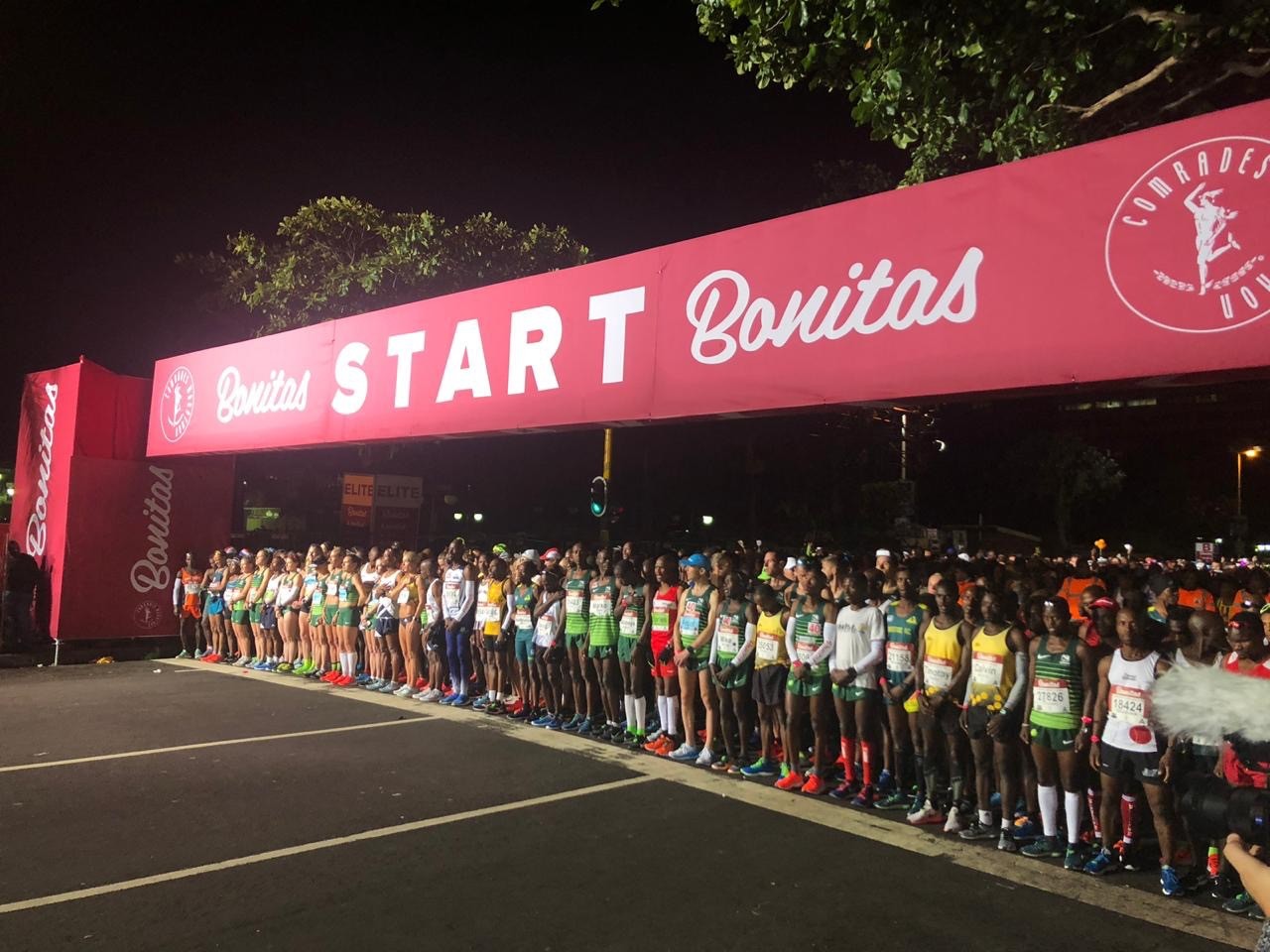
America’s Camille Herron was not able to finished and dropped out.
Camille’s brother Jack posted this on Facebook. “My sister Camille Herron ended up dropping out from Comrades due too hamstring issues she’s been dealing with. I’m heart broken for her because this is just such a special event for her and our entire family.
“I understand the whole mentality of getting to race another day... but she trains so hard and we wait all year for her to defend this title she’s earned. I mean, just her single win is enough, but she goes out every time for a win, so when it doesn’t happen... it’s tough.”
Steyn now will shifts her focus away from Ultra marathons in a bid to qualify for the Olympic marathon in Tokyo next year. The Olympic marathon is expected to be run in blistering heat, with the start moved to 06:00 to mitigate potentially dangerous temperatures. Steyn’s ultra experience could make her a real contender for the Olympic crown.
Login to leave a comment
Comrades Marathon
Arguably the greatest ultra marathon in the world where athletes come from all over the world to combine muscle and mental strength to conquer the approx 90kilometers between the cities of Pietermaritzburg and Durban, the event owes its beginnings to the vision of one man, World War I veteran Vic Clapham. A soldier, a dreamer, who had campaigned in East...
more...William Sichel has become the first person to run the 500 plus miles of Scotland’s answer to America’s Route 66
An exhausted former cancer patient from Orkney, Scotland has become the first person to run the 500 plus miles of Scotland’s answer to America’s Route 66.
Pensioner William Sichel completed the circular North Coast 500 mile tourist route in northern Scotland when he ran into Inverness at around 2am on Monday.
The route has been hailed as one of the greatest drives in the world but has never been run before.
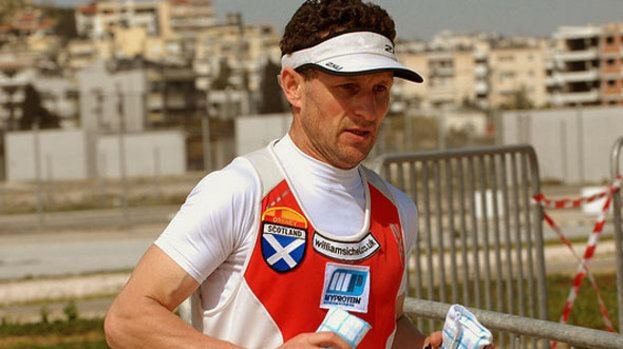
William started at Inverness Castle in Scotland on April 13, with the goal of finishing the iconic route, solo, in eight days. His official time was 8 days, 19 hours, 7 minutes and 7 seconds.
It took him to the west coast, up to Cape Wrath, through Caithness, through Tain and then down the east coast, to finally complete the loop in Inverness.
“I completed a recce run on the whole course in November last year when I was driven around the whole route, which is actually 518.7 miles and ran for up to three hours a day to get a feel for the area," William said.
“Following that experience I decided to have a go at running the whole thing.”
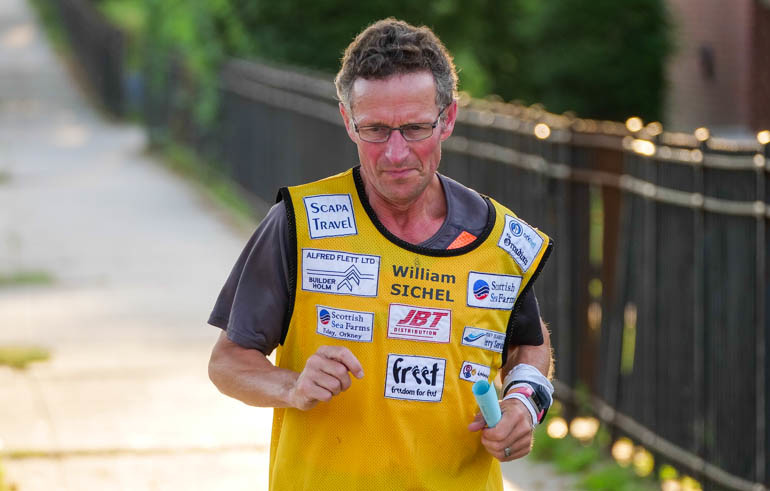
“I am completely drained. I haven’t slept for 21 hours but I made it in under nine days,” said William at the end of the run.
“It was incredibly demanding in every sense – mentally and physically. We made it – thanks to the team, it was a team effort. I’m now just looking forward to my bed.
“I was running into head winds at times but overall I got lucky with the weather. I had a lot of support. I was amazed how it caught on with people as I went round. I hadn’t expected that at all.”
William has completed 107 ultra marathons since 1994. Last summer he ran the Self Transcendence 3,100 Mile race in New York – the world’s longest certified footrace.
No one had previously run the North Coast 500 route although cyclist James McCallum, completed the route in 31 hours in 2016.
Login to leave a comment
3100 Mile Race
The Self-Transcendence 3100 Mile Race. Called 'The Mount Everest of ultramarathons' by The New York Times, is the longest certified footrace in the world. Athletes are able to test themselves in a format unlike any other ultra-marathon event. In order to meet their goal of 3100 miles in 52 days, they must log an average of 59.6 miles per day....
more...Meet Cactus the dog who just ran one of the world’s toughest races, the Marathon des Sables
A dog has become the first canine to cross the finishing line at one of the world’s toughest ultra marathons.
The hound, nicknamed Cactus, wandered onto the course on day two of the Marathon des Sables in Morocco.
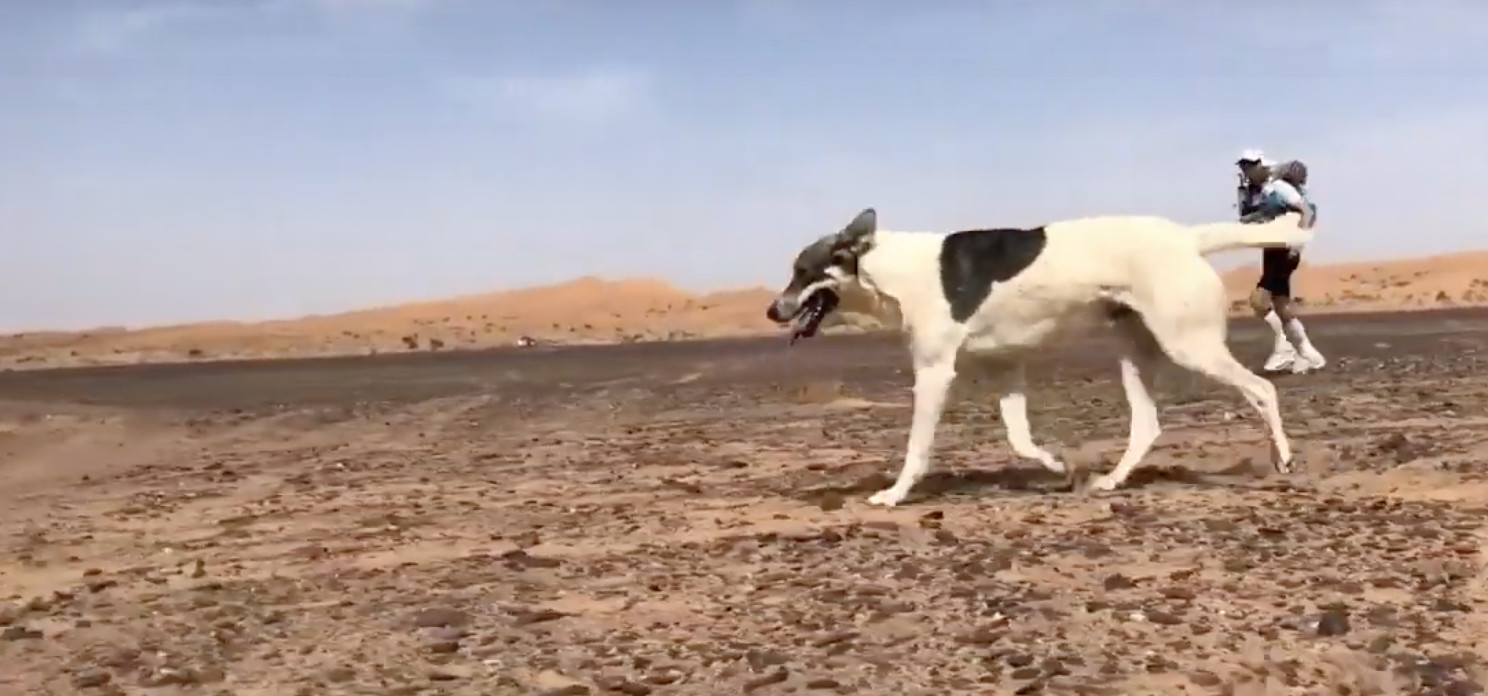
He began following competitors in the 251-kilometre, six-day endurance race in the sweltering Sahara Desert.
‘Cactus’ finished the second stage, then the third and fourth. Organisers tweeted on Friday to say he had crossed the finishing line.
Runners welcomed their four-legged competitor and cheered him on as he trudged with them on his self-inflicted jaunt. He also rested with them and ate and drank in their company.
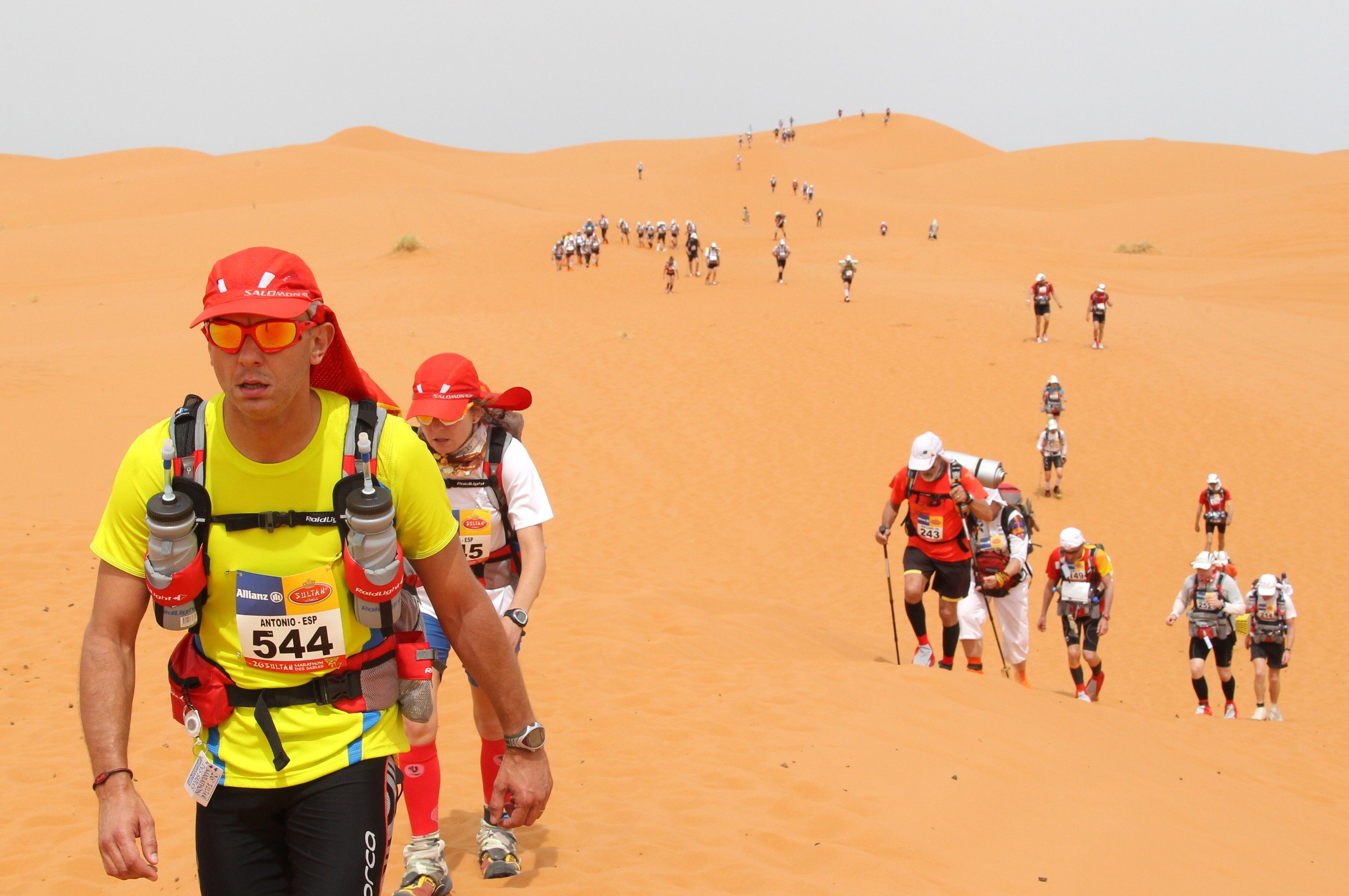
Owner Karen Hadfield took to social media to say that he is a nomad dog and regularly runs 40-km a day in the area.
Pictures emerged on Saturday of organisers and competitors bidding ‘Cactus’ farewell as Karen came to collect him.
Login to leave a comment
Marathon Des Sables
The Marathon des Sables is ranked by the Discovery Channel as the toughest footrace on earth. Seven days 250k Known simply as the MdS, the race is a gruelling multi-stage adventure through a formidable landscape in one of the world’s most inhospitable climates - the Sahara desert. The rules require you to be self-sufficient, to carry with you on your...
more...Defending champions Kenyan Justin Kemboi Chesire and local favorite Gerda Steyn are hoping to successfully defend their titles at Two Oceans
A quality field of top local and international elite athletes will take part in this year's Old Mutual Two Oceans Marathon in Cape Town on Saturday April 20.
Defending champions Kenyan Justin Kemboi Chesire (3:09:22) and local favourite Gerda Steyn (3:39:32), both from Nedbank Running Club, will be hoping to successfully defend their titles.
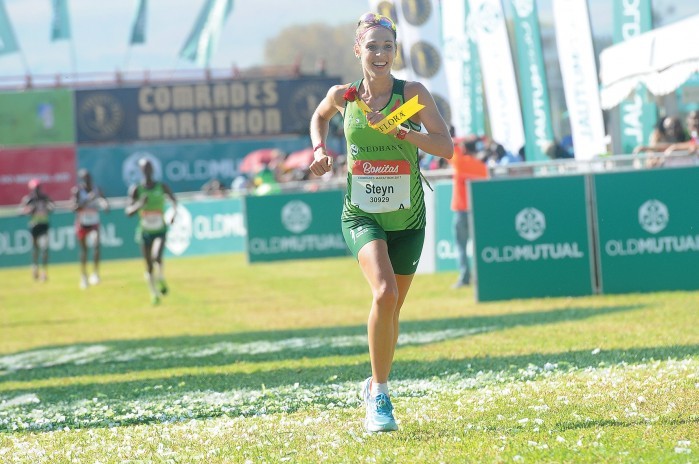
Steyn is training with an end goal of Comrades in mind, and with the Easter weekend being that much later this year, it might be a tough task to pull off both wins.
Chesire's training has been going according to plan but he can expect some tough competition from a quality field of ultra runners who have all been training to win.
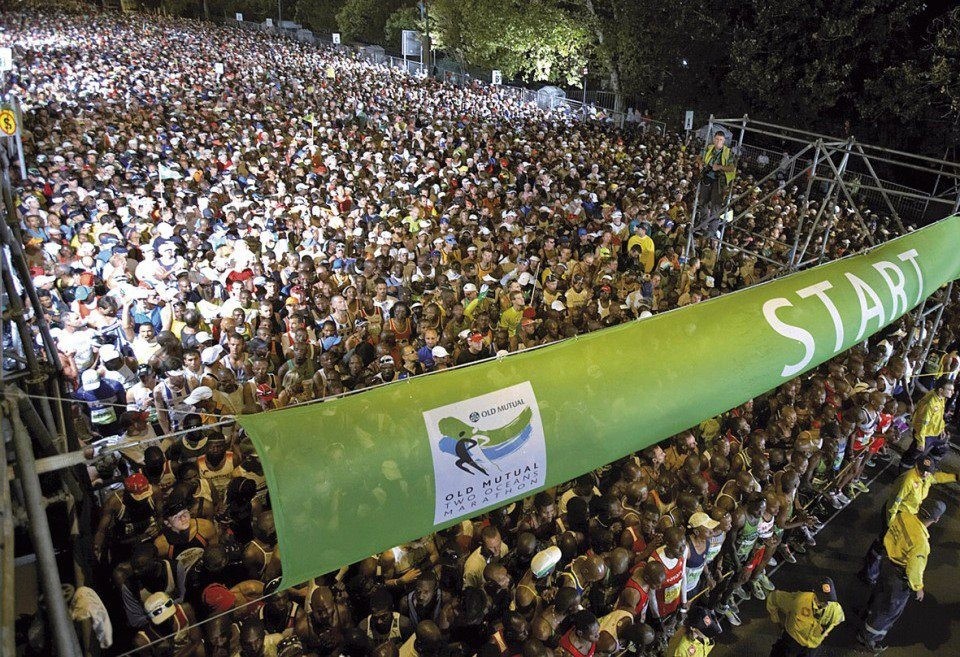
His fellow countryman Abraham Kiprotich, who boasts the fastest marathon of the entire field (2:10 at the Istanbul Marathon late last year), will be running his first ultra marathon and it will be an interesting test to see how he fares over the last 14km with the Constantia Nek climb part of this last section.
Another popular Maxed Elite runner, Zimbabwean Prodigal Khumalo, is back running after a foot injury had him sidelined since December last year. Khumalo has chosen to run the 24km trail event.
Joining this strong field of male runners is local trail legend Ryan Sandes. He has switched from running the trail event for this year, to running his first 56km ultra event. Sandes is hoping to add the Old Mutual Two Oceans Ultra Marathon to his illustrious list of achievements.
Login to leave a comment
Two Oceans Marathon
Cape Town’s most prestigious race, the 56km Old Mutual Two Oceans Ultra Marathon, takes athletes on a spectacular course around the Cape Peninsula. It is often voted the most breathtaking course in the world. The event is run under the auspices of the IAAF, Athletics South Africa (ASA) and Western Province Athletics (WPA). ...
more...

